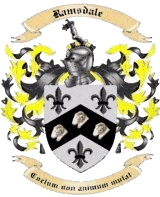Part 1 Index: Etymological & Teutonic Sources
Part 2 Index: Locative Sources
- Ramsdale Hamlet, Fylingdale's Parish, North Yorkshire
- Ramsdale Megalithic Standing Stones, North Yorkshire
- Ramsdale Valley, Scarborough, North Yorkshire
- Ramsdale & Ramsdell Chapelries, Hampshire
- Lilla Howe Bronze Age Barrow, North Yorkshire
- Cuerdale Hoard, Preston, Lancashire
- Wade's Causeway, North Yorkshire
Part 3 Index: Danish or Norwegian Origin
- Danish or Norwegian Origin (published sources)
- Danish or Norwegian Origin (table of place-names)
- Viking Society Web Publications
- Molde Wind Roses
- "On dalr and holmr in the place-names of Britain", Dr. Gillian Fellows-Jensen
- "The Place-Names of the North Riding of Yorkshire" (1979) A. H. Smith, Volume V
Part 4 Index: General
- Fylingdales: Geographical and Historical Information (1890), Transcript of the entry for the Post Office, Professions and Trades in Bulmer's Directory of 1890
- Fylingdales Parish: Victoria County History (1923) A History of the County of York North Riding Volume 2, Pages 534 to 537
- Ramsdale Mill, Robin Hood's Bay, Yorkshire - Postcard Views (circa 1917 to 1958)
- Ramsdale Valley, Scarborough, North Yorkshire: Edwardian Postcards (1901 to 1915)
- Scarborough, North Yorkshire: Bulmer's History and Directory of North Yorkshire (1890)
- Ramsdale Megalithic Standing Stones, Bronze Age Stone Circle, Fylingdales Moor, North Yorkshire
- Robin Hood's Bay - published articles regarding its origin
- Ramsdale Family Register - Home Page
- Whitby Jet - published articles
Etymology

The place name and English surname Ramsdale is locative (both toponymic and topographical) in origin (1) belonging to that group of surnames derived from the place where the original bearer once dwelt or where he once held land, and (2) likely also derived from 'ramsons', being a widespread colloquial name for wild garlic (Allium ursinum) the derivation of which is:
- OE hramsa, 'onion, garlic, ramsons, wild garlic' and 'rank' - the butter and milk of cows which have eaten Ramsons is said to be bitter (rank) - and OE suffix dæl, 'valley, dale' giving OE hramsa dæl, 'wild garlic valley'.
- the first of two possible ON derivations combines ON elements hramsa, rammr ('bitter') and ON dalr, 'dale, valley' giving ON hramsa dalr, 'wild garlic valley', possibly a Scandinavianised form of OE hramsa dæl.
- the second of the two possible ON derivations combines ON hrafn, 'a raven' (hrafns, genitive singular) traced back to, and often spelt, hramn (hramns) according to the morphological rule after which 'n' becomes 'r' after 'm', giving hramns dalr, 'ravens valley'. Cognate with OE hræfn, hræfen, hrefen) 'a raven' and OSax hravan.
"A Modern English - Old English Dictionary" (1927) Mary Lynch Johnson, based on "A Concise Anglo-Saxon Dictionary for the use of Students" (1916) John R. Clark Hall:
- hramsa m (-n/-n) onion, garlic
- hramse, f (-an/-an) onion, garlic
- hramsacrop m (-es/-as) head of wild garlic
"An Etymological Dictionary of the English Language" (1898) Walter William Skeat at page 489
RAMSONS, broad-leaved garlic. (E.) Put for hramsons. 'Allium ursinum, broad-leaved garlic, ramsons'; Johns, Flowers of the Field. Ramsons = rams-en-s, a double plural form, where -en represents the old A.S. plural, as in E. ox-en, and -s is the usual E. plural ending. We also find M.E. ramsis, ramzys, ramseys, Promptorium Parvulorum sive Clericorum Dictionaries Anglo-Latinus Princeps, auctore fratre Galfrido Grammatico dicto, circa A.D. MCCCCXL Ed. A. Way, C.S., 1843, 1853, and 1865. [1440.] page 422; and Way says that Gerarde calls the Allium ursinum by the names 'ramsies, ramsons, or buckrams.' Here again, the suffixes -is, -eys, -ies are plural endings. A.S. hramsan, ramsons; Gloss, to Cockayne, A.S. Leechdoms; a plural form, from singular hramsa. Swedish rams-lök (lök = leek), bear-garlic. Danish rams, or rams-lög (lög = leek) …
"A Compendious Anglo-Saxon and English Dictionary" (1848) Joseph Bosworth at pages 45, 66, 173 and 186
At page 45
Blæc: genitive, masculine, noun, blaces: feminine, blæcre; se blaca, adjective, Black … A black fossil, jet. Blæc hrem, es; masculine, A raven …
At page 66
Dæg hræfen; dæg hræfnes; masculine, A day raven.
At page 144
Hræfen, hræfn, hrefen; genitive, hræfnes; masculine, 1. A raven. 2. The Danish standard. Derivatives Dæg-, niht-. Hræfen-cynn Raven or crow-kind. -fót Raven's or crow's foot. -leac Raven leek, ragwort.
Hræmn A raven, vide hrem.
Hrefen, hrefn A raven, vide hræfen, derived from.
Hrem, hremn A raven. -fót Raven's foot, Lye's Dictionarium Saxonico et Gothico-Latinum, 1772 vide hræm.
At page 173
Niht hræfen, niht hræm A night raven … niht róc Night-rook, raven.
At page 186
Remn a raven, vide hrem.
"A Compendious Anglo-Saxon and English Dictionary" (1848) Joseph Bosworth at pages 41, 42 and 185
At page 41
belene, 1. The herb henbane. 2. A kind of sweet cakes or dainty meat.
At page 42
belone henbane vide belene
At page 42
beolene, henbane vide belene
At page 185
ram, ramm, es; masculine, 1. A ram 2. A battering ram
Rammes-ig, e; feminine Ramsey.
"A Compendious Anglo-Saxon and English Dictionary" (1848) Joseph Bosworth at page 137, entry 25
Henne belle; Henbane, S.
"A Compendious Anglo-Saxon and English Dictionary" (1848) Joseph Bosworth at page 144, entry 26
Hramse, an; feminine, Henbane (hramsa not present)
"An Etymological Dictionary of the English Language (1898) Walter William Skeat at pages 50, 262 and 810
BANE, harm, destruction. (E.) M.E. bane, Chaucer, Canterbury Tales 1099. A.S. bana, a murderer. Icelandic bani, death, a slayer. Danish and Swedish bane, death. Goth, banja, a wound … Derivatives bane-ful, bane-fully.
HEN, the female of a bird, especially of the domestic fowl. (E.) … Derivative hen-bane, Prompt. Parv. page 235; literally 'fowl-poison'; see Bane …
HENBANE. Spelt hennebone (i.e. hen-bane) in the 13th century; Vocabularies, Wright, T. (First Series.) Liverpool, 1857; (Second Series.) Liverpool, 1873. i. 141, col. 2; hennebane in the 15th century, id. 265, col. 2.
"An Anglo-Saxon Dictionary" (1921) Joseph Bosworth, Supplement by T. Northcote Toller at page 562, entry 7 at page 562, entry 6
hræfn A raven. Add Hraebn, hraefn …
"An Anglo-Saxon Dictionary" (1921) Joseph Bosworth, Supplement by T. Northcote Toller at page 563, entry 7
hramsan. Substitute: hramsa, hramse, an; m. f. wild garlic: Hramsa, hromsa … [vide NED rams, ramson].
"Dictionary of Indo-European Languages: Part Three: Vocabulary of the German Language Unit" (1909) Falk, Fick and Torp at page 103, entry 7
hramusa(n) m. … Norwegian, Swiss, Danish, rams m. allium ursinum; Anglo-Saxon hramsa, English 'ramson' …
"An Icelandic-English Dictionary" (1874 & 1957) Richard Cleasby and Gudbrand Vigfusson at page 281, entry 42
HRAFN, often spelt hramn, m. [A.S. hræfn; E. 'raven'; German rabe; Danish ravn, etc.; compare Latin corvus] a raven … in the sayings, sjaldsénir hvítir hrafnar, 'white ravens are not seen every day', of a strange appearance; þá er hart þegar einn hrafninn kroppar augun úr öðrum, 'it is too bad when one raven picks another's eyes out'; Guð borgar fyrir hrafninn, 'God pays for the raven', perhaps referring to 1 Kings 17.4 (And it shall be, that thou shalt drink of the brook; and I have commanded the ravens to feed thee there) & 17.6 (And the ravens brought him bread and flesh in the morning, and bread and flesh in the evening; and he drank of the brook) and Job 38.41 (Who prepares for the raven its nourishment when its young cry to God and wander about without food ?). The raven was a favourite with the Scandinavians, as a bird of augury and of sagacity, víða flýgr hrafn yfir grund, 'the raven is a far traveller'; compare the wise ravens Huginn and Muninn, the messengers of Odin, Grímnis-mál, Edda; whence Odin is called hrafn-blætr, m. 'raven worshipper' (Hallfred), and hrafn-áss, m. (Haustl.); hrafna-dróttinn or hrafna-goð, hrafn-stýrandi, a, m. 'lord or god of ravens'; hrafn-freistaðr, m. 'raven friend' … A raven was the traditional war standard of the Danish and Norse vikings and chiefs … also the Anglo Saxon Chroniclers, e. g. the Saxon Chronicle, Asser, A. D. 878, etc. … The croaking of ravens was an omen … when heard in front of a house it betokens death … the ravens are said to hold a parliament, hrafna-þing; and metaphorically a disorderly assembly was called by that name … A black horse is called Hrafn, Edda. In popular lore the raven is called krummi, quod vide Botanical, hrafna-blaka and hrafna-klukka, u, f. Cardamine pratensis, the ladies' smock or cuckoo-flower, Hjalt. Krummi, a, m. a pet name of a raven, perhaps crook-beak … frequent in popular songs … Krumma-kvæði, n. Raven song; krumr, m. = krummi (?), a nickname … krumsi, a, m. = krummi. Proper names of men, Hrafn, Hrafn-kell; of women, Hrefna, Hrafn-hildr: local names, Hrafna-björg, Hrafna-gjá, Hrafna-gil (whence Hrafn-gilingr, a man from H.), Hrafn-hólar, Hrafn-ista (whence Hrafnistu-menn, an old family), etc., Landnámabók: in poetry a warrior is styled hrafn-fæðir, -gæðir, -gælir, -greddir, -þarfr, = feeder of ravens, etc.: the blood is hrafn-vín … a coward is hrafna-sveltir, m. 'raven-starver' …
- hrafn-blár, adj. raven-black
- hrafn-hauss, m. raven-skull, a nickname
- hrafn-hvalr, m. [Anglo Saxon hran or hren = a whale], a kind of whale
- hrafn-ligr, adj. raven-like
- hrafn-reyðr, f. a kind of whale; also called hrefna, balaena
- hrafn-svartr, adj. raven-black
- hrafn-tinna, u, f. 'raven-flint', a kind of obsidian or agate
- hrafn-önd, f. a kind of duck
"An Icelandic-English Dictionary" (1874 & 1957) Richard Cleasby and Gudbrand Vigfusson at page 482, entry 20
RAMR, adjective, röm, ramt; rammr is a less correct form … modern usage distinguishes between ramr, strong, and rammr, bitter, whence remma, bitterness: [Northern English 'ram'] strong, stark, mighty, of bodily strength … strong, mighty, with the notion of fatal or charmed power; ramt tré, mighty tree' … vehement, röm ást, strong love … ramr harmr, 'strong grief' … röm víg, 'fiery slaughter' … as a nickname, … II. bitter, biting, opposite to sweet (sœtr); ramr reykr, 'strong reek' … III. in poetical compounds, ram-dýr, of ships; ram-blik, 'the strong beam' = gold; ram-glygg, 'a strong gale'; ram-þing, a meeting = battle.
"An Etymological Dictionary of the English Language" (1898) Walter William Skeat at page 492
RAVEN (1), a well-known bird. (E.) For hraven, an initial h being lost. M.E. raven, Chaucer, Canterbury Tales 2146. - A.S. hrœfn, hrefn, a raven, Grein, ii. 100. + Dutch raaf, raven, + Icelandic hrafn. + Danish ravn. + German rabe, O.H.G hraban. No doubt named from its cry. - KRAP, to make a noise; whence also Latin crepare, to rattle. The crow is similarly named.
RAVEN (2), to plunder with violence, to devour voraciously. (French from Latin) Quite unconnected with the word above, and differently pronounced …
Hyoscyamus niger, commonly known as henbane, black henbane or stinking nightshade, is a poisonous plant in the family Solanaceae which can be found growing on the North Yorkshire moors and hills.
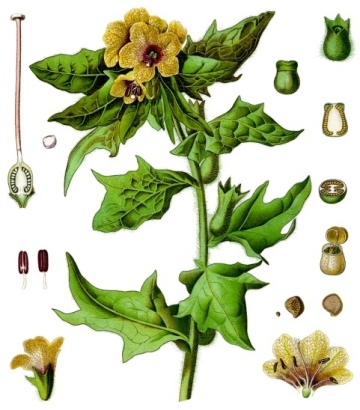
Henbane was historically used in combination with other plants, such as mandrake, deadly nightshade, and datura as an anaesthetic potion, as well as for its psychoactive properties in "magic brews" These psychoactive properties include visual hallucinations and a sensation of flight. It was originally used in continental Europe, Asia, and the Arab world, though it did spread to England in the Middle Ages.
Henbane ingestion by humans is followed simultaneously by peripheral inhibition and central stimulation. Common effects of henbane ingestion include hallucinations, dilated pupils, restlessness, and flushed skin. Over-dosages result in delirium, coma, respiratory paralysis, and death. Low and average dosages have inebriating and aphrodisiac effects.
Henbane leaves and herbage without roots are chopped and dried and are then used for medicinal purposes or in incense and smoking blends, in making beer and tea, and in seasoning wine. Henbane leaves are boiled in oil to derive henbane oil. Henbane seeds are an ingredient in incense blends. In all preparations, the dosage has to be carefully estimated due to the high toxicity of henbane. For some therapeutic applications, dosages like 0.5 g and 1.5 - 3 g were used. The lethal dosage is not known.
Henbane is toxic to cattle, wild animals, fish, and birds. Not all animals are susceptible; for example, the larvae of some Lepidoptera species, including cabbage moths, eat henbane. Pigs are immune to henbane toxicity and are reported to enjoy the effects of the plant.
Clinical manifestations of acute henbane poisoning include … slurred speech, difficulty speaking … auditory, visual or tactile hallucinations, confusion, disorientation, delirium, aggressiveness and combative behaviour. Some scholars propose that certain examples of berserker rage had been induced voluntarily by the consumption of drugs such as the hallucinogenic mushroom Amanita muscaria or massive amounts of alcohol. However, this is much debated and has been thrown into doubt by the following:
- there is no mention of berserkers eating magic mushrooms in the viking sagas nor is there any mention of mushrooms in the sagas or any other written texts or archæological evidence dating from the viking era;
- the discovery of henbane seeds in a Viking woman's grave unearthed at the ring fortress of Fyrkat, near Hobro, Denmark in 1977.
Given that crushing and rubbing henbane petals onto the skin produces a numbing effect along with a mild sensation of flying, this finding has led to the theory that henbane - rather than mushrooms or alcohol - was used to incite the legendary rage in berserkers. The henbane seeds were found in a small purse. If thrown onto a fire, a mildly hallucinogenic smoke is produced. Taken in the right quantity, the seeds can produce hallucinations and euphoric states. Henbane was often used by the witches of later periods. It could be used as a 'witch's salve' to produce a psychedelic effect if the magic practitioners rubbed it into their skin. In her belt buckle was white lead which was sometimes used as an ingredient in skin ointment.
Hyoscyamus niger, black henbane, Keith Cleversley January 2002
Family: solanaceae
Genus: Hyoscyamus
Species: niger
Common names:
- Black Henbane
- Altercum (Arabic)
- Apolinaris (Roman, 'plant of Apollo')
- Asharmadu (ancient Assyrian)
- Banj (Persian)
- Bazrul (Hindi)
- Belendek (Anglo-Saxon)
- Beleno (Spanish)
- Belinuntia (Gaelic)
- Bengi (Arabic)
- Bilinuntia (Celctic, 'plant of Belenus')
- Bilzekruid (Duch)
- Blyn (Bohemian)
- Bolmort (Swedish)
- Csalmatok (Anglo-Saxon)
- Bulmeurt (Danish)
- Dioskyamos (Greek, 'god's bean')
- Giusquiamo (Italian)
- Gur (ancient Assyrian)
- Hyoscyamus (Roman)
- Hyoskyamos (Greek, 'hog’s bean')
- Jupitersbon (Swiss, 'Jupiter’s Bean')
- Kariswah (Newari)
- Khorasanijowan (Bengali)
- Lang-tang (Chinese)
- Lang-thang-tse (Tibetan)
- Sickly Smelling Nightshade
Hyoscyamus niger is either an annual or a biennial, depending on location. It is an upright plant that grows up to 80cm and has undivided, very pungent leaves. The flowers are in thick panicles, and this species has the largest flowers of the Hyoscyamus genus. They are generally pale yellow with violet veins, though some have lemon or bright yellow flowers without veins. The seeds are black, very small, and usually remain in the fruit (Ratsch 1998, 279).
Hyoscyamus niger is the most widely distributed henbane plant, and is found in Europe, Asia, Africa and the Himalayas. It has become naturalized in North America and Australia (Rastch 1998, 279).
Traditional Uses
H. niger is discussed in ancient Greek literature under the name "apollinarix", the plant of the god Apollo. Dioscorides, the famous ancient Greek pharmacologist and botanist who wrote one of the most influential herbal books in history, a five volume set called "De Materia Medica", was familiar with the medicinal value of black henbane. Medieval Anglo-Saxon pharmacopeias also touted the healing properties of the plant. It has also been suggested that henbane was the magic nepenthes in Homer's Odyssey, the drug which Helen gave to Telemachus and his comrades to make them forget their grief. It is thought that henbane under the name of hyoskyamos was sacred to the goddess Persephone (Hocking 1947).
H. niger was used as a ritual plant by the pre-Indo-European peoples of central Europe. In Australia, handfuls of henbane seeds were discovered in a ceremonial urn along with bones and snail shells, dating back to the early Bronze Age. During the Palaeolithic period, it has been speculated that henbane was used for ritual and shamanic purposes throughout Eurasia. When the Palaeoindians migrated from Asia into the Americas, they brought with them their knowledge of the use of the plant. When they were unable to locate Hyoscyamus niger, they substituted the very similar and related tobacco plant (Nicotiana tabacum) (Hofmann et al. 1992).
The Gauls of ancient Western Europe poisoned their javelins with a decoction of henbane. The plant's name is derived form the Indo-European 'bhelena' which is believed to have meant 'crazy plant'.In the Proto-Germanic ancestral language of modern English and German, 'bil' seems to have meant 'vision' or 'hallucination', and also 'magical power, miraculous ability'. There was even a goddess known as Bil, a name interpreted as 'moment' or 'exhaustion'. The goddess Bil is understood to be the image of the moon or one of the moon's phases. She may have been the henbane fairy or the goddess of henbane, and it's speculated that she may have even been the goddess of the rainbow; 'Bil-röst' is the name of the rainbow bridge that leads to Asgard. 'Bil' then would also be the original word for 'heaven's bridge' (Hofmann et al. 1992).
The Assyrians knew henbane by the name of sakiru. They used the plant as a medicine to treat a variety of ailments and they also would add it to beer as a way of making it more intoxicating. It was also used as a ritual incense made by combining black henbane with sulfur to protect the user from black magic. In ancient Persia, henbane was called bangha, a name that was later used to describe hemp (Cannabis sativa) and other psychoactive plants. Persian sources suggest that henbane has had a religious significance throughout history, with many journeys to other worlds and visions described as being evoked by various henbane preparations (Ratsch 1998, 279-280).
King Vishstap, who is known historically as the protector of Zarathustra, imbibed a preparation of henbane and wine known as mang. (It has also been speculated that the potion he drank was a mixture of haoma and henbane in wine). After drinking this concoction, he fell into a sleep so deep it seemed deathlike, lasting three days and three nights. During this time, his soul journeyed to the Upper Paradise. In Persian folklore, Viraz, another visionary, also made a three-day journey into other worlds by using a mixture of henbane and wine. As the story goes, at the end of the third night, “the soul of the righteous”, meaning Viraz, felt as if it were in the midst of plants, inhaling their heady scent, sensing an intensely fragranced breeze that blew in from the south. The soul of the righteous, Viraz, inhaled the wind through its nose and awoke enlightened (Couliani 1995 cited in Ratsch 1998, 279-280).
The Celts consecrated black henbane, known to them as beleno, to Belenus, the god of oracles and the sun, when they would burn it as a fumigant in his honour. Henbane also appears to be one of the most important ritual plants of the Vikings, since Iron Age Viking gravesites were found to contain hundreds of henbane seeds. An archeological dig of the ancient gravesite in Denmark yielded a significant artifact, a leather bag worn by the deceased woman which was filled with hundreds of henbane seeds (Robinson 1994).
The oldest ethnohistorical evidence of the Germanic use of henbane as a magical plant can be found in the nineteenth book of the collection of church decrees, the German Book of Atonement. In one passage, the process of a henbane ritual is described in detail: Villagers gather together several girls and select from them one small beauty. They then disrobe her, and take her outside their settlement to a place where they can find 'bilse', which is henbane in German. The chosen girl pulls out the plant with the little finger of her right hand and it is tied to the small toe of her right foot. She then pulls the plant behind her to the river, as the other girls lead her there, each carrying a rod. The girls dip the rods in the river, then use them to sprinkle the young maiden with the river water, in hopes that they will cause rain through this magical process. It is believed that this ritual was associated with the Germanic god of thunder, Donar (Hasenfratz 1992 cited in Ratsch 1998, 280).
The beer of Donar the god of thunder was brewed with henbane, as he was considered an extremely enthusiastic drinker and very skilled at holding his liquor. As a result, henbane was in huge demand in Germany, although it was quite rare there as it was not indigenous. Therefore Germans planted henbane gardens specifically for using in brewing beer. The history of the sites where these gardens once stood is reflected in their modern day names, such as Bilsensee, Billendorf and Bilsengarten (Ratsch 1998, 280-281).
Since its introduction to North America, many indigenous tribes have taken to using the plant in ways similar to Datura. The Seri tribe add the leaves to their chicha, or infuse them in water and drink to create soporific and analgesic effects (Voogelbreinder 2009, 194).
Traditional Preparation
During the Middle Ages and the early modern period of Europe, henbane was associated with witchcraft and magic, in particular with oracles and love magic. It was believed that henbane smoke could make one invisible and that it was an ingredient in witches' ointments. In modern occultism, henbane seeds are used as fumigants to conjure spirits and to summon the dead. The flowing recipe is for a fumigant used in occult rituals:
- 1 part fennel root/seeds (Foniculum vulgare)
- 1 part olibaum - (Boswellia scara)
- 4 parts henbane (Hyoscyamus niger)
- 1 part coriander seeds (Coriandrum sativum)
- 1 part cassia bark (Cinnamomum cassis)
One would take this incense into the black forest, light a black candle and set the incense vessel on a tree stump. The mixture would burn until the candle went out, and it is then that one can see the spirits of the dead (Hyslop & Ratcliffe 1989 cited in Ratsch 1998, 281).
The dried, chopped plant matter can be used for incense and in smoking blends, as well as for brewing beer, spicing wine, and making tea. The seeds are the ideal component when making incense. Henbane oil can be made by boiling the leaves of the plant in oil. This can then be used for therapeutic or erotic massage purposes (Ratsch 1998, 279).
One must be very careful to assess henbane dosage properly. According to Lindequist, a therapeutic dose of Hyoscyamus with a standard alkaloid content is 0.5 g, and the maximum daily dosage is 3 g (Lindequist 1993 cited in Ratsch 1998, 279).
Medicinal uses
In addition to its ritual significance, Hyoscyamus niger has significant medicinal importance as well. The use of henbane smoke to treat toothaches and asthma is widespread. In Darjeeling and Sikkim, henbane is used for these purposes, as well as to treat nervous disorders. The plant has also been used since ancient times to heal bones, as an analgesic and antispasmodic, and as a sedative and narcotic. In Nepal, the smoke of the leaves is used to treat asthma. In homeopathic medicine, a preparation of H. niger is well known to be an effective treatment for anxiety, agitation, unease, insomnia and spasmodic digestive disorders (Ratsch 1998, 281).
In China, henbane, known as lang-tang, was steeped in wine and used to treat malaria, mania, skin diseases, and dysentery. The seeds were said to cause one to see spirits if crushed and consumed. The leaves and flowers are still used in TCM to treat neuralgia and gastric spasms. The smoke of Chinese henbane seeds is inhaled as a treatment for coughs, bronchial asthma, rheumatism and stomach aches (Voogelbreinder 2009, 194).
Traditional effects
Hyoscyamus niger conains 0.03 to 0.28% tropane alkaloids, principally hyoscyamine and scopolamine. The parasympathetic effects of the plant are due to these alkaloids. The primary effects include peripheral inhibition with central nervous system stimulation, and last up to four hours. Hallucinogenic effects are also present and can last up to three days. Overdose can lead to delirium, comas, and death. However, there are few reported cases of overdose. Low doses of henbane beer have aphrodisiac effects. Very high doses can lead to delirium, confusion, memory loss, 'insane' states, and 'crazy behaviour' (Ratsch 1998, 282).
Henbane is toxic to grazing animals, deer, fish, many birds, and so forth. Interestingly, pigs are immune to the effects of the toxins and appear to appreciate the inebriating effects of consuming the plant (Morton 1977).
References
- Hocking, G.M. Henbane: Healing Herbs of Hercules and Apollo. Economic Botany 1 (1947): 306 - 316.
- Hofmann, A., Ratsch, C., Schultes, R., Plants of the Gods: Their Sacred, Healing, and Hallucinogenic Powers. Rochester: Healing Arts Press, 1992.
- Morton, J. Major Medicinal Plants: Botany, Culture and Uses. Springfield, IL: Charles C. Thomas Publisher, 1977.
- Ratsch, Christian., The Encyclopedia of Psychoactive Plants: Ethnopharmacology and its Applications. Rochester: Park Street Press, 1998.
- Robinson, D. Plants and Vikings: Everyday Life in Viking-age Denmark. Botanical Journal of Scotland 46, no. 4 (1994): 542 - 551.
- Voogelbreinder, Snu, Garden of Eden: The Shamanic Use of Psychoactive Flora and Fauna, and the Study of Consciousness. Snu Voogelbreinder, 2009.
"Sagas of the Solanaceæ: speculative ethnobotanical perspectives on the Norse berserkers" (2019), Karsten Fatur, The Journal of Ethnopharmacology
A new study on the legendary Viking warriors known as berserkers suggests that they were able to achieve their battle trances and ferocity through the use of henbane. The article by Karsten Fatur, an ethnobotanist from the University of Ljubljana, also offers evidence to refute the possibility that a particular type of mushroom was used by the Norse to become these warriors. The study was published earlier this year in the Journal of Ethnopharmacology.
Very little is known of the berserkers, but scattered accounts of them appear in sagas and Norse mythology. It is thought that the word berserker comes from 'bear skin' because they wore animal pelts in battle. Fatur offers this description of them:
"The berserkers were said to be not just ordinary warriors, but rather to fight while in a specific trance-like state, which was likely helpful in dissociating them from the close-up atrocities they would have seen and committed in battle. This state has been variously claimed to involve anger, increased strength, a dulled sense of pain, decreases in their levels of humanity and reason, behaviour akin to that of wild animals (including howling and biting on their shields), shivering, chattering of their teeth, chill in the body, and invulnerability to iron (swords) as well as fire. Additionally, they were said to attack enemies indiscriminately with no sense of friend or foe and to throw off their armour in battle."
"2. Berserkers"
"Exactly who the berserkers were is a matter of controversy in itself. Originally, the term is thought to have emerged in reference to a specific hero in Norse mythology who fought without armour, thus leaving him 'ber sark' or bare skinned (Fabing, 1956). Then, during the Saga period (870 - 1030 CE) in Iceland and Scandinavia, a group of warriors arose known by the same name before their sudden disappearance around the 12th century CE (Fabing, 1956). Actual direct references,however, are often unclear; even the meaning of the word 'berserker' has been thought to perhaps mean 'bear skin' rather than 'bare skin' and refer to these warriors wearing bear or animal pelts in their battles (Liberman, 2004; Wade, 2016)."
"This lack of information exists in large part due to the fact that knowledge of the berserkers was not recorded substantially until after the tradition had been outlawed by the Christian church while seeking to stamp out paganism and because the writings that did exist were often made by Christian writers with an agenda to denounce these traditions (Wade, 2016).
"Some archæological items from the period display images of warriors whose bodies are covered in animal skins, and various myths among the Norse peoples point to warriors dressing in the skins of bears and wolves to gain their ferocity, but there is no concrete way to associate these phenomena (Wade, 2016)."
"Iconography from the period does also seem to display that berserkers were among the social elite of the time, though this too is open to interpretation (Dale, 2017)."
"Ultimately, all that can be said with certainty is that they were elite warriors who were known for their recklessness in battle and that they may have fought without armour (Liberman, 2004). The berserkers were said to be not just ordinary warriors, but rather to fight while in a specific trance-like state, which was likely helpful in dissociating them from the close-up atrocities they would have seen and committed in battle (Wade, 2016)."
"This state has been variously claimed to involve anger, increased strength, a dulled sense of pain, decreases in their levels of humanity and reason, behaviour akin to that of wild animals (including howling and biting on their shields), shivering,chattering of their teeth, chill in the body, and invulnerability to iron (swords) as well as fire (Dale, 2017; Fabing, 1956; Speidel, 2002;Wade, 2016). Additionally, they were said to attack enemies indiscriminately with no sense of friend or foe and to throw off their armour in battle (Fabing, 1956; Wade, 2016). When the state wore off after about one day, the berserkers were said to experience several days of weakness and dulled mental capacity (Fabing, 1956). Reports also seem to point to clubs being needed to defeat berserkers since blades could not harm them; this has been interpreted by some as potential proof of the term berserker referring to warriors who wore animal skins, since pelts would provide some protection against the cutting of swords but would do very little to protect from the blunt trauma involved in attacks with clubs (Dale, 2017). Though often thought of out of context within popular culture, it has been suggested that the Norse berserkers were in fact part of a larger tradition of Indo-European 'ecstatic' warriors who made use of trance-like states in battle (Speidel, 2002)."
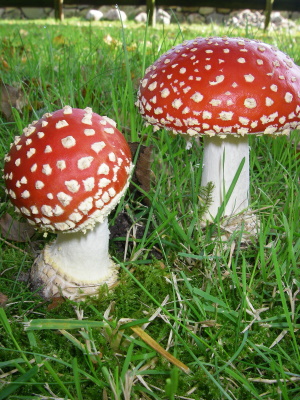
Previous studies suggest that Amanita muscaria, a mushroom commonly called 'fly agaric', was used by the Norse to become berserkers. It is known that in Siberia this mushroom was dried and eaten during religious rituals to achieve a psychoactive state. However, Fatur believes that henbane, also known as Hyoscyamus niger, would be a more likely candidate for the Vikings to have used. This plant, which originated in the Mediterranean but spread northwards to Scandinavia, was well known in the Middle Ages to have psychoactive effects. It was even added to medieval beers, so much so that authorities banned that practice in 1507.
Fatur notes archæological finds from Scandinavia that show henbane being used during the Viking age. This includes a woman's grave in Denmark from around the year 980 that included a pouch of henbane seeds with clothing, jewellery, and other grave goods that suggests she was a priestess or shaman.
The article offers this analysis of why henbane (Hyoscyamus niger) would have been more likely than mushrooms (Amanita muscaria):
"As previously discussed, both substances may cause increases in strength, altered level of consciousness, wild/delirious behaviour, jerking/twitching, and redness of the face, all of which have been associated with berserkers. What makes Hyoscyamus niger a more compelling theoretical cause of the berserker state, however, is its additional symptoms that are not commonly seen in intoxications involving Amanita muscaria. In addition to the previous symptoms, Hyoscyamus niger's alkaloids also have pain killing effects unseen in the compounds within Amanita muscaria, which may account for some of the reports of the supposed invulnerability of the Norse berserkers. Even more compelling is the duration of effects; though the berserker state has been reported to involve several days of side effects after the high has subsided, this is not a common feature in intoxications with Amanita muscaria."
Fatur also notes a few other effects that might have been caused by henbane, which has been seen in studies about modern cases of that plant use. These include the inability to recognize faces (berserkers were said to be not able to distinguish between friends and foes in battle), the removal of clothing, and loss of blood pressure, which might explain why berserkers did not lose much blood when struck by blades. There are some aspects of berserker behaviour which cannot be explained by using henbane, namely the chattering of teeth and the biting of shields.
7. Conclusions
The present article has been able to provide a theory: that Hyoscyamus niger was used by the famed berserker warriors of the Saga period (870 - 1030 CE) in Scandinavia to produce their battle trances. Ultimately, future finds will determine if this theory will be proven or disproven. The most reliable form of archæological/historical data combines paleobotanical and textual/artifactual information in order to provide a complete picture of the past (Merlin, 2003). The present investigation has done just this, showing that at present the data available supports the potential use of Hyoscyamus niger as an intoxicating agent to induce the berserker trance. Although the Amanita muscaria mushroom is a popular theoretical cause accepted by many, we have seen here that the symptomology of the berserker state aligns much better with an intoxication arising from the anticholinergic alkaloids hyoscyamine/atropine and scopolamine. Of the plants that contain these alkaloids, Hyoscyamus niger is the most viable option as a result of its presence in Scandinavia during this time period and its association with various archæological sites that show it was being employed by humans in this time and place and that it was commonly growing as a weed in areas of human habitation. This article must of necessity conclude with the remark that I myself am neither a historian of nor an archæologist of the Nordic region. As an ethnobotanist studying the use of anticholinergic solanaceous plants in Europe, however, this theory came to me as a result of the information present in the literature. Only future research may now confirm or deny the speculative ethnobotanical perspective here presented
Hyoscyamus niger, henbane, black henbane … So poisonous that the smell of the flowers produces giddiness but, in some cultures, used for ritual and recreational purposes due to its strong hallucinogenic properties … Causes … agitation and combative behaviour … The seed heads look like a piece of jawbone complete with a row of teeth. This plant was, therefore, used in dentistry from ancient times. The hallucinogenic, soporific effects of the plant would have made people forget the toothache …
Alternatively, the surname Ramsdale derives directly from the Norse place-name Raumsdalr (the valley of the river Rauma in the counties of Oppland and Møre og Romsdal in Norway - modern: Romsdal) an eponym after "Raum the Old" (Old Norse: Raumr inn gamli), son of King Nór, legendary founder of Norway who may have been descendants of the ancient Gothic "Raumii" tribe. Raums Dale is the modern district of Romsdal in the county of Møre og Romsdal. Raum was said to have been ugly, as was his daughter, Bryngerd, who was married to King Álf. Indeed, in Old Norse, raumr means a big and ugly person. See "An Icelandic-English Dictionary" (1874 & 1957) Richard Cleasby and Gudbrand Vigfusson:
- Raumar, m. plural the name of a people in Norway: Rauma-ríki, n. a county in Norway: Raums-dalr, m. the present Romsdalen: Raum-dælir, m. plural the men from Raums-dalr: Raum-elfr, f. the river Raum in Norway, Fornmanna Sögur: Raumskr, adjective from Romsdalen, Fornmanna Sögur. ii. 252.
- raumr, m. a giant, Titan, Edda (Gl.) 2. a big, huge, clownish person, Fas. ii. 384, 546, Skíða R. 51.
- ELFR, f., … a proper name of the three rivers called Elbe … Raum-Elfr, the Elb of the Raums (a people in Norway) …
For references to Raum- people and places see "Harald Fairhair and his Ancestors" (1920), "The Ancestors of Harald Haarfagre" (1920) and "Harald, first of the Vikings" (1911)
"Icelandic Sagas and Other Historical Documents Relating to the Settlements and Descents of The Northmen of The British Isles" (Volume IV) The Saga of Hacon and a fragment of the Saga of Magnus with Appendices translated by Sir G. W. Dasent
At § 212 on pages 203 and 204: "When King Hacon sailed out of Bergen it was said to him that the Duke had sent men into the stewardships in South Mæren and in Romsdale. … And when they came north off Romsdale-mouth they heard that Finn ball was inside in Ve-isle with his band. They turned at once into the firth, and came on them unawares, and slew Finn and some men with him."
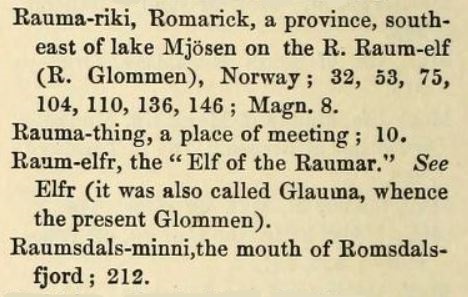
At § 10 on page 16: "King Ingi was at feud with the Drontheimers for that they kept back the levies of men from him and other sea-service. The king fought with them at the Rauma-Thing, as is written in his Saga."
At § 32 on page 35: "Rognavald got the stewardship at Fold and about Oslo; but he had held before the stewardship in Romarick. The men of Rauma called him rather hard in his stewardship; and he stood in need of much, for he had a great company."
At § 205 on pages 195 and 196: "Thence they went south into Romsdale, and slaughtered everywhere the cattle of the king's men. But they laid hands nowhere on the men, for they had all gone south away from them … Arni black was to have the stewardship in Romsdale, and he turned back south to the king …"

At § 293 on pages 310 and 311: "As Sturla says":
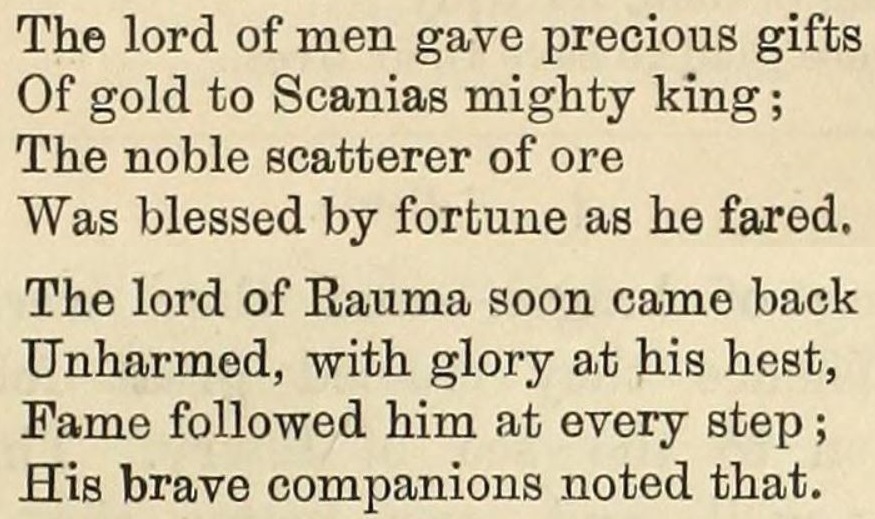
Index of Places at page 463:

At § 79 on page 72: "… When the Ribbalds heard that then they turned east over the fell, and the messengers told the king that there was not less expectation that they might come down into Romsdale or into Mæren."
Index and Names of Places at page 446:
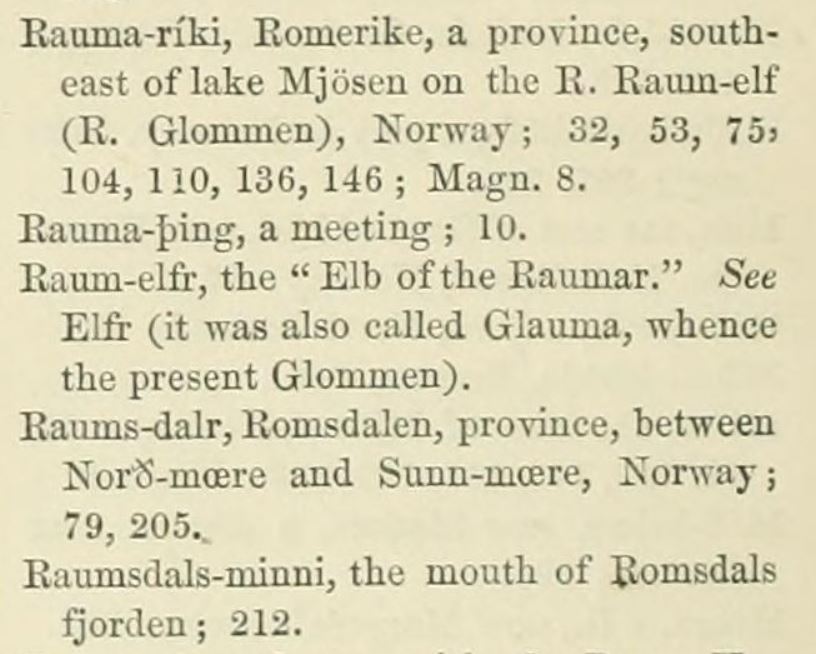
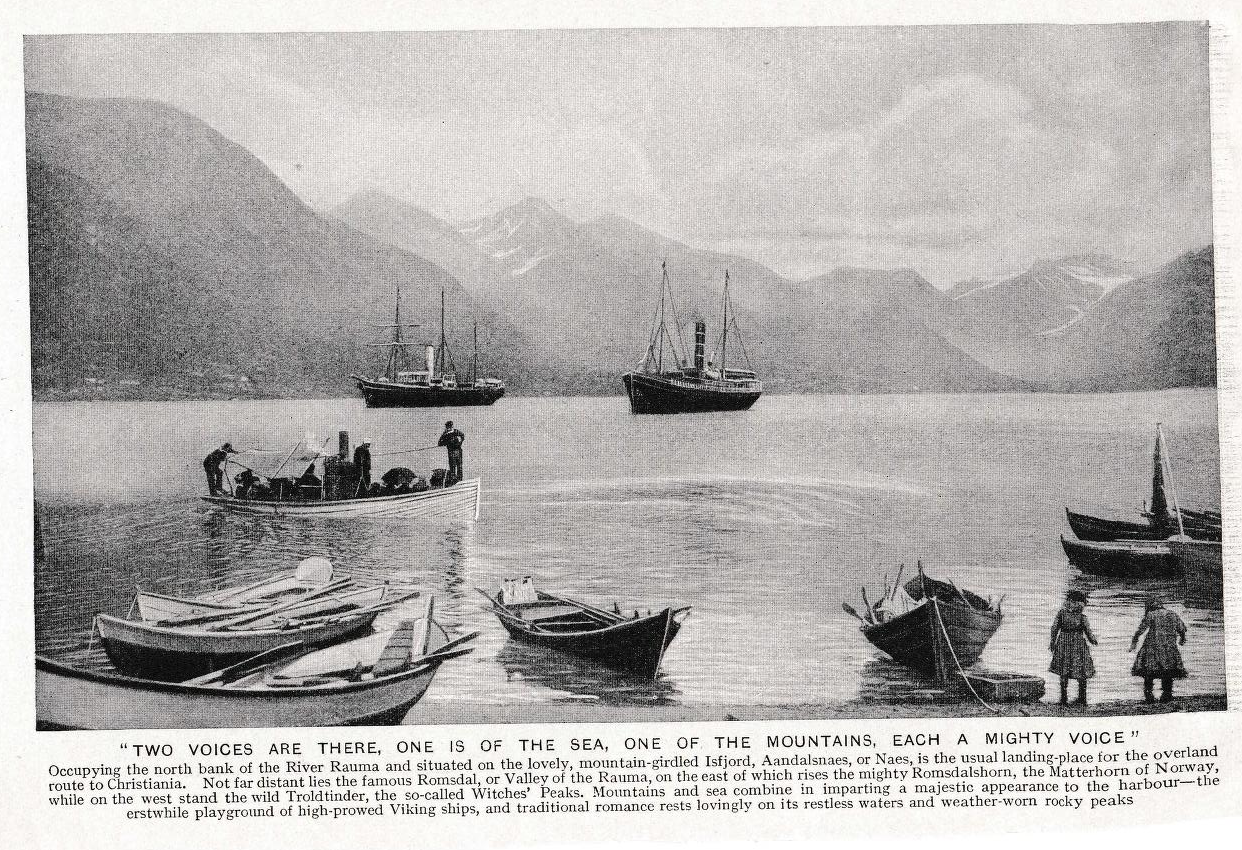
"Norway, I. Virile Ways of the Modern Vikings" (circa 1920) A. MacCallum Scott Volume V at page 3870
Snorri Sturluson, Edda, Skáldskaparmál
2. Glossary and Index of Names edited by Anthony Faulkes, Viking Society for Northern Research, University College London (1998)
Nǫkkvi m. a king in Raumsdalr (Romsdal, Norway) v345/4 (genitive with mœtir, or with ræsinaðr ?, see note and Glossary under nǫkkvi)
nǫkkvi m. boat (originally a hollowed tree-trunk; Falk 1912, 85) v491/8; cf. v345/4, see note and Index
Raumar m. plural, inhabitants, people of Romerike or Romsdal in Norway v376/1 (Hkr II, III, Fagrskinna)
"A New Introduction to Old Norse, Part III": Glossary and Index of Names (2007) Anthony Faulkes and Michael Barnes, Viking Society For Northern Research, University College London at page 172
Mœrr f. district in Norway (Norðmœrr-Raumsdalr-Sunnmœrr; modern Møre and Romsdal) XVI:9
"An Icelandic-English Dictionary" (1874 & 1957) Richard Cleasby and Gudbrand Vigfusson
Raumar, m. plural, the name of a people in Norway: Rauma-ríki, n. a county in Norway: Raums-dalr, m. the present Romsdalen: Raum-dælir, m. plural, the men from R.: Raum-elfr, f. the river Raum-elfr (Raumelfr 'Raum river') in Norway, Fornmanna Sögur: Raumskr, adj. from Romsdalen, Fornmanna Sögur ii. 252.
raumr, m. a giant, Titan, Edda (Gl.) 2. a big, huge, clownish person, Fornaldar Sögur ii. 384, 546, Skíða R. 51.
raumska, að, modern rumska, to say hem! in awakening, Fornaldar Sögur iii. 11.
"An Icelandic-English Dictionary" (1874 & 1957) Richard Cleasby and Gudbrand Vigfusson
ELFR, f., genitive elfar, accusative, dative elfi, a proper name of the three rivers called Elbe, Latin Albis, viz. Gaut-Elfr, the Elb of the Gauts (a Scandinavian people) = the River Gotha of the present time; Sax-Elfr, the Elb of the Saxons, the Elbe; Raum-Elfr, the Elb of the Raums (a people in Norway), i. e. the present Glommen and Wormen, Bær. 3, Njála. 42. Fornmanna Sögur i. 6, ii. 128, iii. 40, iv. 121, ix. 350, 393, 401, x. 292: Elfar-bakki, the bank of one of these Elbes, Bær. 3, Fornmanna Sögur ix. 269, 274; Elfinar-bakki, Fornmanna Sögur i. 19;, of the river Ochil in Scotland, is a false reading = Ekkjals-bakki, vide Orkney. 12. Compounds: Elfar-grímar, m. plural dwellers on the banks of the Gotha, Fornmanna Sögur vii. 17, 19, 321. Elfar-kvíslir, f. plural the arms of the Gotha, Fornmanna Sögur i. 7, iv. 9, ix. 274; used of the mouths of the Nile, Edda 148 (pref.) Elfar-sker, n. pl. the Skerries at the mouth of the Gotha, Fornmanna Sögur, Fornaldar Sögur; compare álfr, p. 42. 2. metonymically used of any great river, (rare in Iceland but frequent in modern Danish).
Elfskr, adjective, a dweller on one of the Elbe rivers, Landnáma, Fornmanna Sögur ii. 252.
"A Concise Dictionary of Old Icelandic" (1910) G. T. Zoëga at page 111
elfar-bakki, m. bank of a river.
Elfar-byggjar, -grimar, m. plural, the dwellers on the banks of the Gotha (Gautelfr); -kvíslir, f. plural, the arms of the Gotha, also used of the mouths of the Nile; -sker, n. plural, the skerries at the mouth of the Gotha.
elfr (genitive elfar, dative and accusative elfi), f. river; especially as proper name in Saxelfr, the Elbe; Gautelfr or Elfr, the river Gotha (in Sweden); Raumelfr (in Norway).
The Ynglinga saga, when relating the events of the reign of King Gudröd (Guðröðr) the Hunter relates:
"Álfheim, at that time, was the name of the land between the Raumelfr ['Raum river', lower parts of the modern Glomma river] and the Gautelfr ['Gaut river', the modern Göta älv]."
The words "at that time" indicates the name for the region was archaic or obsolete by the 13th century. The element elfr is a common word for 'river' and appears in other river names. It is cognate with Middle Low German elve 'river' and the name of the river Elbe. The Raum Elf marked the border of the region of Raumaríki and the Gaut Elf marked the border of Gautland (modern Götaland). It corresponds closely to the former Norwegian province of Bohuslän, now in Sweden.
The name Álfheim here may have nothing to do with Álfar 'Elves', but may derive from a word meaning 'gravel layer'.
However, the Saga of Thorstein, Viking's Son claims that the two rivers and the country was named from King Álf the Old (Álfr hinn gamli) who once ruled there, and that his descendants were all related to the Elves and were more handsome than any other people except for the giants, a unique and possibly corrupt reference to giants being especially good looking. The Sögubrot af nokkrum fornkonungum also mentions the special good looks of the kindred of King Álf the Old.
Álfr hinn gamli: in proper names, hinn Gamli is added as a soubriquet, like 'major' in Latin, to distinguish an older man from a younger man of the same name; hinn gamli and hinn ungi also often answer to the English 'father and son'; thus, Álfr Gamli and Álfr Ungi, old and young.
"North Men - The Viking Saga 793-1241" (2015) John Haywood at page 27
Chapter 1: Thule, Nydam and Gamla Uppsala - The Origin of the Vikings
… Around eight tribes lived in Norway; their homelands can be identified with some certainty because they are etymologically related to the names of regions of modern Norway. The Raumarici most likely lived in Romerike, the Alogi in Hålogaland north of the Arctic Circle, the Rugi in Rogaland, and so on. Rodulf's Rani probably lived in Romsdal, the valley of the river Rauma, in the west of the country. Thanks to its rugged geography, Norway remained a land of local tribes even at the beginning of the Viking Age. Elsewhere, most of the tribes named by Jordanes had vanished by this time …
"Native Families of the Orkney and Shetland Islands" (13 May 1999) Niven Sinclair
Drawing on the available historical research sources such as Craven, Peterkin's Rentals. J Clouston's Records of the Earldom of Orkney and Roland William St Clair's The Clair of the Isles, these native families of the Orkney and Shetland Islands (and, to a lesser extent, Caithness) are the descendants of the Initial Norse Viking colonists who consolidated and extended the Northern Territories of the Orcadian 'jarldom' under the leadership of the family of Jarl Rognvald 'the Wise' of Moeri and Rhomasdahl in Norway and, more particularly, by his natural son, Jarl 'Turf' Einar - so-called because he taught people how to burn peat.
The surname Ramsdale is related etymologically to the surnames Ramsden, Ramsdell, Ramsgill and Ramsbottom, all of which
- derive from the same OE element hramsa and/or ON element hramns, and
- tend to be associated with Lancashire and Yorkshire.
The most probable source of the surname is Ramsdale Hamlet [NZ 92722 03762] in Fylingdale's Parish, North Yorkshire. This parochial chapelry lies south of Whitby parish and contains the villages of Robin Hood's Bay and Thorpe, or Fyling Thorpe (Presterthorpe, 13th century), and the hamlets of Normanby, Parkgate, Ramsdale, Raw (Fyling Rawe, 16th century), and Stoupe Brow.
The actual derivation of the surname will likely only be discovered through improved Y-DNA testing of males of the Ramsdale surname to more accurately determine their paternal line.
"Surnames, DNA and Family History" (2011) George Redmonds, Turi King and David Hey at pages 4 to 7 and 215 to 217
Introduction at page 4
Reaney's Dictionary of Surnames
Reaney's dictionary often quotes early examples of surnames in districts other than those where they were found in the post-medieval period; he thus sometimes gives a misleading impression of where a surviving family name originated. For instance, he suggested that the surname Ramshaw had the same derivation as surnames derived from place-names such as Ravenshaw (Warwickshire) and Renishaw (Derbyshire). In fact, Ramshaw is a County Durham surname which is derived from Ramshaw Hall, Evenwood, near Auckland. The Durham hearth tax returns of 1666 list five households of Ramshaws in Chester-le-Street ward, two in Darlington ward, and one in Stockton ward. Of the 739 people who bore the surname in the 1881 census, 396 lived in County Durham and 149 in Northumberland; none was found in the heartlands of the Renshaws and Renishaws. Although he knew that his own name came from Ranah Stones Farm in south-west Yorkshire, Reaney usually missed the point that uncommon names are associated with particular districts and often have single-family origins.
Reaney's achievement was considerable. His dictionary is still a first port of call. Yet his conclusions about the etymology of a name can often be shown to be wrong. He had no interest in the geographical distribution of names, nor in the ways in which medieval surnames continued to evolve in later centuries. His opening words in his Introduction were:
"The purpose of a Dictionary of Surnames is to explain the meaning of names, not to treat of genealogy and family history".
Yet by ignoring genealogy his explanations of the etymology of a name are often incorrect. Every family name, however common, had a single progenitor and every effort must be made to identify him and his immediate descendants if we are to understand how a name arose and perhaps evolved into something different. The expertise of the philologist in interpreting the earliest recorded form of a surname cannot by itself be trusted to offer a proper account of the meaning of a modern name. A multi-disciplinary approach is necessary for a proper understanding of the etymology of a surname and its subsequent development.
… Reaney's pioneering work was valuable at the time and can still be useful, but his real purpose seems to have been to explain the meaning of medieval names, whether or not they became hereditary and whether or not they survived. Nor was he much concerned with the ways that surnames might evolve over the centuries. Unfortunately, many of Reaney's flawed explanations are repeated in other dictionaries and are accepted as accurate in a variety of historical publications, despite all the new work of the past half century.
Introduction at page 5
The English Surname Series
… Meanwhile, George Redmonds' 1970 Leicester PhD thesis was published as English Surnames Series, 1: Yorkshire, the West Riding (1973). This book was the first to champion the idea that very many English surnames have a single-family origin. Some of these have remained rare, but from the sixteenth century onwards, as the population grew, families that produced numerous sons spread from their point of origin into the neighbouring towns and country, side, and occasionally much further.
Introduction at page 6
The Leicester approach emphasized genealogical methods in the context of the growth of local communities and stressed the fluidity of development in the centuries after surnames first became hereditary. In the post-medieval period, numerous surnames changed in minor ways and some altered out of recognition in the course of only two or three generations. Genealogical methods have to be used to link modern names with those recorded in historical sources and to establish the variant forms of a surname before plotting them on distribution maps. This is easier said than done, for some names became unrecognizable while others shaded into each other and even assumed the forms of local place-names and personal names with which they had no real connection. It is unwise to guess the meaning of a family name simply from its modern spelling.
For ordinary people whose surname has changed from the original medieval form, the most likely explanation is that an ancestor migrated to a new neighbourhood where the name was unfamiliar and patterns of speech were different. The origins of some family names are puzzling because both the surname and the place-name from which they were derived have changed in spelling and pronunciation over time. For example, the surname Shufflebottom comes from a place near Bury (Lancashire) that is now known as Shipperbottom. The first record of the surname occurs in 1285 as Richard de Schyppewallebothem, which can be explained as (sheep - well - valley bottom), a similar name to Ramsbottom, not far away. The 1881 national census listed 542 Shufflebottoms, 617 Shufflebothams, and 150 people with many other spellings of this name, most of them in south Lancashire and Cheshire. A further 112 Shipperbottoms were recorded in the census: 108 of them in the Bolton registration district (which included Bury) and the other four nearby in Haslingden. All the bearers of this unusual name, whatever the spelling that they prefer, perhaps share a common ancestor, unless they are descended from what geneticists call a non-paternity event.
Conclusion at pages 215 to 217
The study of surnames was once the preserve of the specialist in old languages. The dictionaries that are still consulted on the shelves of public reference libraries were compiled by philologists in a long tradition that culminated in the work of P.H. Reaney and R.M. Wilson. Knowledge of Old English, Old Norse, Norman French, Middle English, and other languages that have influenced the ways that surnames have been formed is clearly an essential component of a proper understanding of the subject. As with the study of place-names, it is essential to establish the earliest recorded spellings of a surname and to place them in an appropriate linguistic context. But only a small group of scholars who are interested in surnames possess these specialist skills and so the etymologies that have been derived from them have been readily accepted by the public at large.
It is now clear that this approach remains valid only if it takes account of other methods of enquiry. It is not the sole way to the truth. Linguists have often failed to provide correct etymologies because they have not linked the earliest recorded examples with present forms. Although the linguistic approach is usually effective in explaining medieval by-names, it often lacks credibility when dealing with modern surnames, for it has taken little or no account of how very many names have changed over the centuries, often radically, and it has had no interest in the past and present geographical distributions of surnames. Time and time again, compilers of dictionaries have quoted medieval evidence from counties far distant from the present concentration of a name and for which there are no later records. No attempt has been made to show that the early by-names that they unearthed ever developed into hereditary surnames. What Reaney and Wilson produced was not a dictionary of current surnames, but a useful compilation of etymologies of numerous English by-names during the main period of surname formation.
Linguistic analysis remains an important component of the study of sur-tames, but it needs to be subsumed in a multi-disciplinary approach that uses he techniques of genealogy and the knowledge of local historians. Each family name, even if it is one shared by numerous families across the land, should be treated as having a unique history that must be traced back in time step by step. Only by the use of such painstaking methods can we be sure whether a name has retained its early form or has been altered, either subtly or out of recognition, over the centuries.
Genealogical methods can also establish whereabouts a particular surname was formed, or they can at least demonstrate that a distinctive name was confined to a particular locality in the late Middle Ages or by the beginning of parish registration in the mid-sixteenth century. One of the greatest advances in the study of surnames has been through mapping their distributions at various points of time, starting with modern electoral rolls and telephone directories, then going back in time to the 1881 census, the hearth tax returns of the 1660s and 1670s, and possibly to the poll tax returns of 1377-81. Such maps show immediately that the surname Ashurst, for example, was derived from a minor place-name near Wigan and that the bearers of this name have no historical links with similar place-names quoted by Reaney and Wilson in Kent, Surrey and Sussex. If any of the medieval by-names that were formed from these other Ashursts became hereditary surnames, they must have died out quite early.
The local provenance of numerous British surnames, as revealed by distribution maps and genealogical research, suggests that very many of them are of single-family origin. Historians have often been thwarted in their attempts to prove this claim because of the relatively sparse nature of the documentary evidence at the time when surnames became generally adopted. This is why they have welcomed the new technique of DNA analysis of the male Y chromosome with such enthusiasm. Some spectacular results have been achieved and the case for single-family origins of many surnames has undoubtedly been strengthened. Yet this approach alone does not always resolve the problem, for it is often frustrated by what scientists call non-paternity events, chiefly high rates of illegitimacy. The results of investigations into DNA structures are often not sufficiently certain on this point to stand on their own. They have to be considered alongside those of linguistic, genealogical, and historical research.
Genetics has much more to offer family historians than the resolution of this particular problem, however. It can provide a way of determining whether or not two or more names shared a common ancestry, as seemed possible or even likely from the historical evidence. This is not just a matter of connecting names with variant spellings; it can also demonstrate a complete change of a name through the use of an alias, or show that illegitimacy, adoption, or some other form of non-paternity event has occurred. Proving a link between different names has been a particularly exciting new development when different forms of a surname appeared thousands of miles away across the Atlantic. Genealogists have turned to this new technique with enthusiasm and have quickly become the best informed amateurs about the implications of the genetic structure of the male Y chromosome.
The study of surnames is of particular interest to family historians, but it also has wider implications. Surname distributions have much to tell us about the stability and mobility of the British population as a whole over the past few centuries. They demonstrate that, despite the mobility of numerous individuals, most families remained within the neighbourhood or 'country' that had been familiar to their ancestors. London was exceptional in attracting a continuous flow of migrants from far and wide. The larger provincial cities, such as Norwich and York, also provided opportunities for the more adventurous, but the majority of the population - even after the coming of the railways - did not venture beyond their nearest market towns. The 'core families' that stayed put for generation after generation and who had well-established connections with similar families within the neighbourhood were the ones that shaped the character of the place: its speech, customs, attitudes, forms of religion, styles of vernacular architecture, working practices, and all the other matters that cemented a local society. These links are not as strong as they were, but even today a surname can locate a person within the territory where it was formed several centuries ago.
Surnames also provide vital evidence for the movement of populations overseas, particularly across the Atlantic. They can suggest whereabouts in Britain a family originated and they can sometimes indicate that a group of neighbours went on the long voyage together or perhaps followed each other when the first adventurers reported the success of their journey and the rewarding prospects that lay ahead. Genetics has been highly successful in demonstrating the movement of human populations in prehistoric and early medieval times. In tracing the movements of people in recent centuries, it has the benefit of drawing on other methods of enquiry. The cooperation of scholars across the disciplines is a very welcome development in all such studies. It is clearly necessary for a true understanding of surnames.
Earliest Recorded References
"The Concise Oxford Dictionary of English Place-Names" (1960) Eilert Ekwall at page 380
Ramsdale Ha [Ramesdala 1170 Oxf], Ramsdale - YN [Ram(m)esdal 1240 FF], Ramsden Bellhouse, Crays & Heath Ess [Ramesdana DB, -den 1158 BM, 1208 Cur, Ramesden Belhous, Gray 1254 Val, Ramesden Crei 1274 RH], Ramsden - O [Ramesdon 1179 RA, Rammesden 1279 RH, 1316 FA]. 'wild garlic valley' or possibly 'ram valley'. See HRAMSA, RAMM, DENU.
"The Place-Names of The North Riding of Yorkshire" (1979) A. H. Smith, Volume V at page 117
Fylingdales
FYLINGDALES 16 H 12
RAMSDALE
Ramesdale 1210 (Dugdale's Monasticon, 1817-1830, Volume iv. 319,) 1240 (Yorkshire Feet of Fines)
Rammesdale 1240 (Yorkshire Feet of Fines)
The early forms suggest that we have here OE hramse, ramese 'garlic, ramson' as in Ramsey (Hu), v. Björkman, Nordische Personennamen, 1910 Wo xli. Alternatively we may have OE ramm, hence either 'garlic valley' or 'ram's valley'.
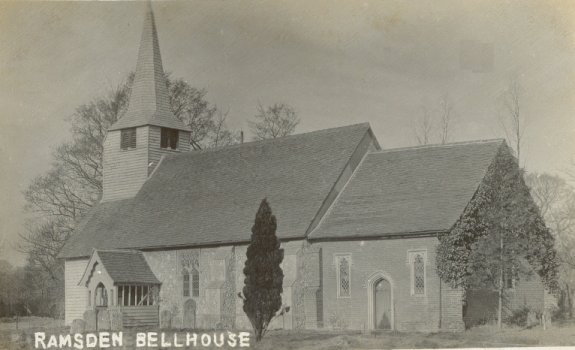
Ramsdale farm in Nottinghamshire (EPNS Nt 114) was held by John de Ramsdale in 1332 - per Dr Gillian Fellows-Jensen (2 April 1997)
Ramsden Bellhouse was held by Ricardus de Belhous in 1208 (Cur). Bellhouse means "belfry". Ramsden Crays was held by Simon de Craye in 1252 (Cl). Craye is from CRAY or CRAYE in France.
Old English & Old Norse Derivations
OE hramsa, hramse, 'wild garlic', sometimes appearing as hramaes-, hremesin OE place name spellings and is therefore difficult to distinguish from rammes, genitive singular of ramm, as in (a) Ramsbottom La (botm), Ramsdale Ha (denu), Ramsey Ess, Hu (g), Ramsholt Sf (holt), Romsley sa, Wo 300 (leah) [Middle Low German ramese 'garlic']. [7]
The suffix -dale is derived from the OE doel, or, perhaps nearly always in old names, ON dalr, a dale, the root meaning being probably deep, low place [compare Gothic dalath, 'down']. Found from the Scottish border south to Derbyshire, but much commoner in the north, where Norse influence was strong, and there usually a river valley between hills, a glen - Allendale, Borrowdale, Ennerdale, etc. [2]
Similarly, the English surname Dale is a topographic name for someone who lived in a valley, ME dale (OE doel), reinforced in Northern England by the cognitive ON dalr, or habitation name from any of the numerous minor places named with this word. [1]
"English Place Names" (1996) Kenneth Cameron, The Bath Press, at pages 189 to 191
Of the numerous place-name elements denoting a valley, "valley" itself is very rare and vale, also a French loan-word into English, is infrequent … Dale on the other hand is common enough, particularly in Scandinavianised areas of the country, and sporadically elsewhere. OE dœl, modern dale meant 'pit, hollow', and the general view today is that it was really only in general use with the sense 'valley' due to the influence of the cognate Scandinavian word dalr which did mean 'valley'. It would appear, therefore, that it was only in late OE, for the most part, that doel denoted a 'valley'. The usual English word for this topographical feature was denu, modern dene … The widespread use of dale in later minor names and field-names must, it would seem, ultimately be the result of Scandinavian influence … in major place-names the occurrence of doel 'valley' is rare indeed and south of the Thames it is not found at all. In Devon, for example, Dalwood is not recorded before 1175 and is probably of post-Conquest origin, while the other dale-name in Devonshire is Dymsdale, in Alwington, first recorded in 1371. The editors of The Place-Names of Devon comment "As the element dale is otherwise unknown in Devon the name can hardly be of local origin". Indeed, there can be little doubt that Dymsdale is derived from the topographical surname Dymmyngesdale, that of a miner or miners from Derbyshire or Staffordshire impressed into work in the royal stanneries in the south-west, for which there is evidence certainly from 1295. A John Dymmyngesdale is actually mentioned in the 1371 document noted above. The surname itself is doubtless derived from a place-name such as Dimmin Dale in Taddington (DBY) or Dimsdale (STS), but unfortunately the first element has not yet been fully explained. Dale is found most frequently to the north of the River Mersey and River Humber but it also occurs as far south as NTH. Even in the north, however, it is comparatively rare in DUR and NBL, where Scandinavian influence is much less than in YKS, and it has been plausibly suggested that the degree of Scandinavian influence is crucial in the use of dale in the formation of place-names. Further because of "its wide currency as a term for 'valley' it often replaced the more usual OE denu". This has happened in the self-explanatory Deepdale (NTH), Oxendale (LAN) 'where oxen are found', Saxondale (NTH) 'valley of the Saxons', and Stavordale (SOM), the first element of which may mean 'stake'.
Dale has been added to a number of river-names like Airedale (WRY), Eskdale (CUL), Lonsdale (Lune, LAN), Ribblesdale (LAN), Swaledale (NRY), and Wharfedale (WRY). It is named from animals in Cowdale (DBY) and Kiddal (WRY) 'cows', Grisdale (WES) 'young pigs', and Withersdale (SFK) 'wether-sheep', from plants in Farndale (NRY) 'fern', Matterdale (CUL) 'madder', and Mosedale (CUL) 'moss', from a cross in Crossdale (CUL), a church in Kirkdale (LAN, NRY), and from a fortification in Borrowdale (CUL, WES). In the north-west the first element is sometimes a Scandinavian personal name as in Bannisdale (WES) from Bannandr, Belasdale (LAN) from Blesi, and Skelmersdale (LAN) from Skelmer, while Patric, an Irish name, is the first element of Patterdale (WES).
OE denu has been referred to as "the standard OE term for a main valley" and as such is widespread in this country. We have seen how it has sometimes been replaced by dale and in at least one name, Longdendale (DBY), the latter has been added to an original Langdene 'long valley'. Indeed, it has been shown that most valleys derived from denu are long and sinuous, and as Ann Cole notes that "denu is mostly used of long, narrow valleys with two moderately steep sides and a gentle gradient along most of their length".
Compare and contrast with the text of the 1977 edition below:
"English Place Names" (1977) Kenneth Cameron, The Bath Press at pages 179 & 180
Of the numerous place-name elements denoting a "valley", valley itself is rare, and vale, also a French loan-word occurs infrequently … Dale, on the other hand, is common enough, particularly in the Scandinavianized areas of the country and occasionally elsewhere. Recent research has suggested that Old English dœl "dale" was not a common place-name element, and that the subsequent increasing use of dale was due to the influence of the corresponding Old Norse dalr. The similarity of the two words often makes it impossible to be certain which of them is the source of particular names. But it is probably the English word in Silverdale (LAN) 'silver' from the colour of the rocks, the common Deepdale and Debdale (NTH) 'deep', Edale (DBY) 'land between streams', and Sterndale (DBY) 'stony'. A few contain an Old English term for animals, as in Cowdale (DBY), Kiddal (WRY) 'cows', and Withersdale (SFK) 'wether', and for a plant in Farndale (NRY) 'fern', but the first element could be either English or Scandinavian in Mosedale (CUL) 'moss' and Westerdale (NRY) 'western'. Dalr is, however, likely where the first element is a Scandinavian word, as in Borrowdale (Cu, We) literally "valley of the fortification", Bowderdale (CUL) "valley of the booth", Wasdale (CUL, WES) 'valley of the lake', Grisdale (WES), of which the first element means 'young pigs', Uldale (CUL) 'wolves', and probably Matterdale (CUL) 'where madder grows' and Birkdale (LAN) 'where birches grow'. This is similarly the case where the first element is a Scandinavian personal name, Bannandi in Bannisdale (WES), Blesi in Bleasdale (LAN), Skelmer in Skelmersdale (LAN), as well as Patric, an Irish name, in Patterdale (WES).
The usual Old English term for a valley was denu, as in Dene or Dean, common minor names in many southern counties, as well as the Sussex Eastdean and Westdean, originally simplex names later distinguished by East- and West-. In the North, however, this element is comparatively rare, but in some names it may later have been replaced by dale.
Teutonic Sources
Many old Norse names had roots and meanings similar to old English names, for the Saxons had themselves come as invaders from the opposite shores of the North Sea, like the Vikings. This makes it often impossible in their modern forms to distinguish between names which are in fact Viking from similar names which are Old English. [3]
Many names used by the Norman settlers after the Norman Conquest were also of Norse origin and indeed the name Norman itself simply means Northman. Some of these Norse names brought to England by the Normans are known to have been already used in England, for they occur in Saxon Charters, and other such names may also have been already used in England though they do not happen to survive in any of the Saxon charters which still remain to record the fact. Names of this kind became more common thanks to new arrivals with similar names from Normandy; but, whether used by conquerors or conquered, spelling and pronunciation took on the French air which was to be fashionable in conquered Anglo-Norman England for the next two centuries and more after 1066. [3]
The main source of English place names is Teutonic and came at two distinct times
- at the Anglo-Saxon invasions during the 5th, 6th and 7th centuries
- during the 8th, 9th, 10th and 11th centuries when the Danes came direct to this country from Denmark and the Norsemen or Northmen from Norway penetrated into the north-west by way of Ireland and the Hebrides, passing up the Wirral peninsular and spreading over Lancashire and the West Riding of Yorkshire. [4]
In addition to the direct invasion of England by the Danes via the east coast there was also a Norwegian conquest of northern Scotland, the Orkneys and Shetlands and other islands, as well as the over-running of most of Ireland. It was from the Hebrides and Ireland that they penetrated into England via the west coast, especially into Lancashire with an overflow into Yorkshire. Well over 50% of place names in Yorkshire are of Scandinavian as distinct from Anglo-Saxon origin. [4]
This double Teutonic influence has made it difficult in every case to say definitively to which source a place-name such as Ramsdale belongs, but if the root is to be found in Old English it will be allocated to the Anglo-Saxon period; if the root is to be found in Old Norse it will be placed in the period of the Danish and Norwegian invasions. Often, as perhaps in the case of Ramsdale, the root is to be found in both these old Teutonic languages (OE dæl and ON dalr), and then it is immaterial to which source we allot it. [4]
Professor Stenton, in an article published a recent number of the Historical Review, noted this Scandinavian influence in place name nomenclature in many ways, among them being … the frequent replacing of Old English names by Scandinavian, eg Scandinavian dalr replaced Old English denu, accounts for the large number of dales and the comparative rarity of deans or dens. But everywhere it is the Norse element that predominates, recalling the Scandinavian settlements of exceptional thoroughness in the 9th and 10th centuries. Remember that in 915 Norsemen from Ireland captured York, and for 35 years Irish Vikings ruled there. [4]
Viking Influence
In the same way that the Danish names in England are seen to radiate from the Wash, so the Norwegian immigration seems to have proceeded from Morecambe Bay and that part of the coast which lies opposite to the Isle of Man. [5]
In the North Riding, in the western half, in Gilling, Richmondshire and Langbargh, there is very definite evidence of extensive Norse settlement, as well as on the coast near Whitby, the latter, no doubt, reached directly from the North Sea. These Irish Vikings, on their way east, quickly came into contact with the earlier Danish settlers and in places there was a considerable mixture of races, Norwegian, Danish and Anglian. [6]
The Norwegian movement from the north-west into Yorkshire culminated in 919 in the capture of York by Ragnall mac Bicloch, who was the first of a series of Irish Viking Kings of York which lasted for 35 years, during which constant intercourse must have been maintained between Yorkshire and Ireland, with a constant increase of Irish-Norwegian settlers all along the route. [6]
Scarborough is one of the few place-names of which the exact origin is known. From the Kormaks saga we learn that two brothers Thorgils and Kormak went harrying in Ireland, Wales, England and Scotland: "They were the first men to set up the stronghold which is called Scarborough"
From two poems which Kormak addresses to his brother, we know that Thorgils was nicknamed Skarði, the hare lip, hence the Scandinavian form of the name, Skarðaborg, found also in English as Scartheborc circa 1200 later Scareburgh (1414). Thorgils died in 967; the brothers' expedition to England took place immediately after their return from one to Russia in 966, so that Scarborough must have been founded late in 966 or in 967. [6]
The mixture of races is well illustrated by such names as Danby, Normanby and Ingleby, each of which occurs three times in the North Riding. These denote villages of Danes, Norwegians and Angles and can have been given only by Scandinavians in districts where these races were in a minority. Normanby, found four times in Lincolnshire and three times in the North Riding, was a village where Norwegians lived, among an overwhelming Danish population.
"External Influences on English: From its Beginnings to the Renaissance" (2012) D. Gary Miller
Several places with the name Normanby in Lincolnshire and Yorkshire mark Norwegian settlements while Denby/Danby is Danish (Cameron 1958; Fellows Jensen 1972: 189ff, 1973: 18) …
In Norfolk, names in -by are rare except on the Norse-settled coast (Sandred 1987) …
-DAL(E). Valley names in -dal(e) (cf. OIcel dal-r 'valley: DALE') are frequent north of a line from the Mersey to the Humber, excluding Northumberland and Durham (PNL 95), e.g. Grisedale 'valley of pigs' (OIcel griss 'young pig: hog') …
The distribution of these names is interesting and unexpected. They provide evidence for Norwegians in the eastern Danelaw who could hardly be Vikings from Ireland. They may have been Norwegians who had joined the armies of Halfdan and Guthrun, and the scanty evidence of their presence in the eastern Midlands may be due to the known hostility between Danes and Norwegians. The capture of York from the Danes and the establishment of a Norwegian kingdom would not conduce to friendly relations, and the Anglo-Saxon Chronicle of the 10th century not only gives proof of the internecine feuds between them but also provides evidence of similar hostility farther south. [6]
Norway, I. Virile Ways of the Modern Vikings" (circa 1920) A. MacCallum Scott Volume V at pages 3833 to 3845
Climate is an important factor in the development of racial characteristics. The North is a Spartan mother, and her sons are nourished in adversity and indurated to the struggle with nature. Fruits do not drop into their lap. They are trained to stand alone, compelled to exercise foresight. Like the pine that braves the tempest, their fibre is toughened by the struggle for life. The earliest members of the Gothic race to settle in Norway found in these sheltered fjords and narrow valleys and virgin forests plenty of food for those who had the skill and the strength to win it, and when their numbers had multiplied beyond the limits of their food resources they could send forth a breed of men able to find and take what they required elsewhere.
…
The coast of Norway is one vast sheltered harbour for thousands of miles. It is protected by a continuous belt of islands, large and small, the Skjaergaard, or fence of skerries, through the narrow straits between which ships wind their way as through a canal. Between these islands and the mainland there is a channel or belt of deep water, deeper than the outside ocean. The fjords are not river estuaries, but narrow, deep-sea channels, branching out in all directions until they almost meet, and penetrating sometimes one hundred miles into the interior of the country. Their towering cliffs run down precipitously into deep water.
The interior is a huddle of grey, rounded mountains culminating in the snow-clad heights of the Dovrefjeld and the Jotunfjeld, or Giant mountains. These are not peaked like the Alps. They have been ground down by glaciers, denuded, scraped, harrowed, by the ice plough of the Titans. Some relics of the Ice Age still remain in the shape of glaciers which feed the rivers that pour down the narrow valleys winding between the mountains.
Such a land, and such a coast, were essential for the breeding of such a race of seafarers as the Vikings. The Norwegians are a pure race, preserving all the characteristics of their Viking ancestors, and it is in the light of the Viking age that they should be studied.
Wheat is grown in the south, barley, rye, and oats farther north, but the corn supply has to be largely imported. The rearing of cattle, sheep, and horses is the staple occupation. The pastures are excellent. Among the most familiar features of the Norwegian landscape are the curious pegged posts, like hatracks, dotted over the fields, on which the hay and corn are dried, and the fences of rough wooden laths all slanting upwards.
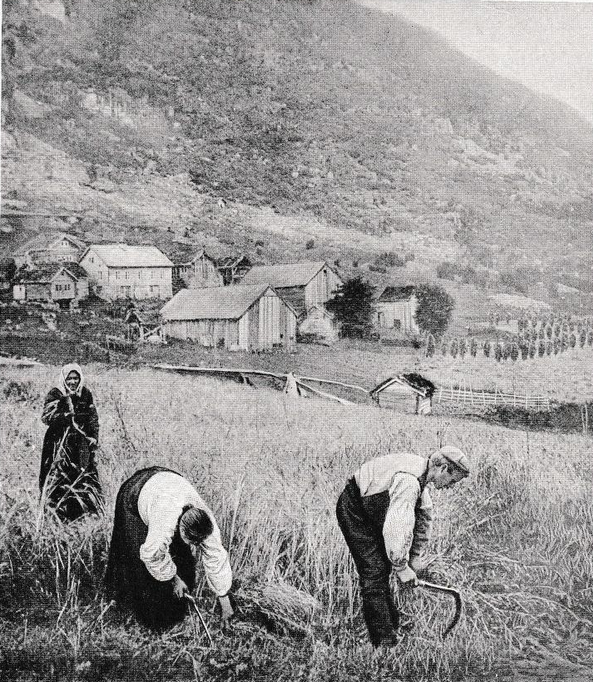
Harvesting Barley in a Fertile Valley near Trondhjem
Barley makes a successful crop in South Trondhjem, and has been reaped six weeks after sowing, while records show that two crops a year are not uncommon. The ripe ears, cut down with the sickle, are bound into sheaves and stuck one above another to dry on poles, which at a distance look for all the world like rows of sturdy soldiers lined up for parade.
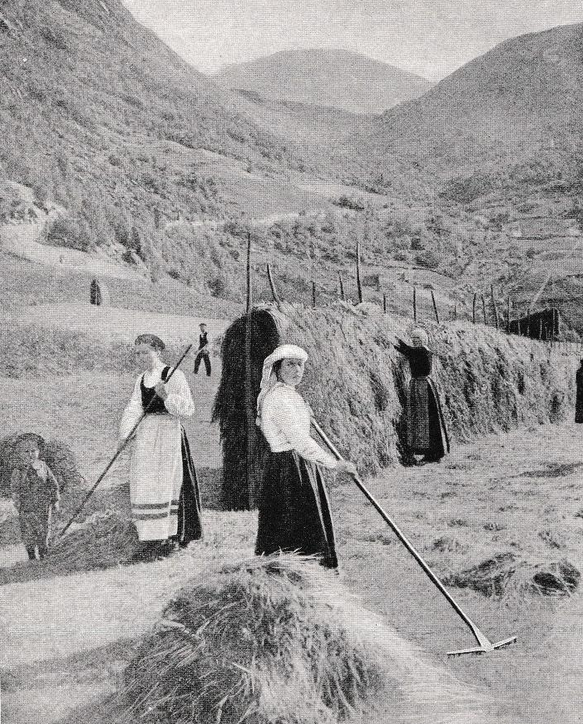
Drying Hay Crops in the Heart of the Norwegian Highlands
So damp is their climate that the Norwegian agriculturalists have considerable difficulty in drying the newly-cut hay; and to enable the air to reach the crop more readily, they erect long, fence-like structures, several feet high, on which the hay is stacked. Sometimes the hay is piled up on separate poles, as is done in the Swiss and Austrian Alps.
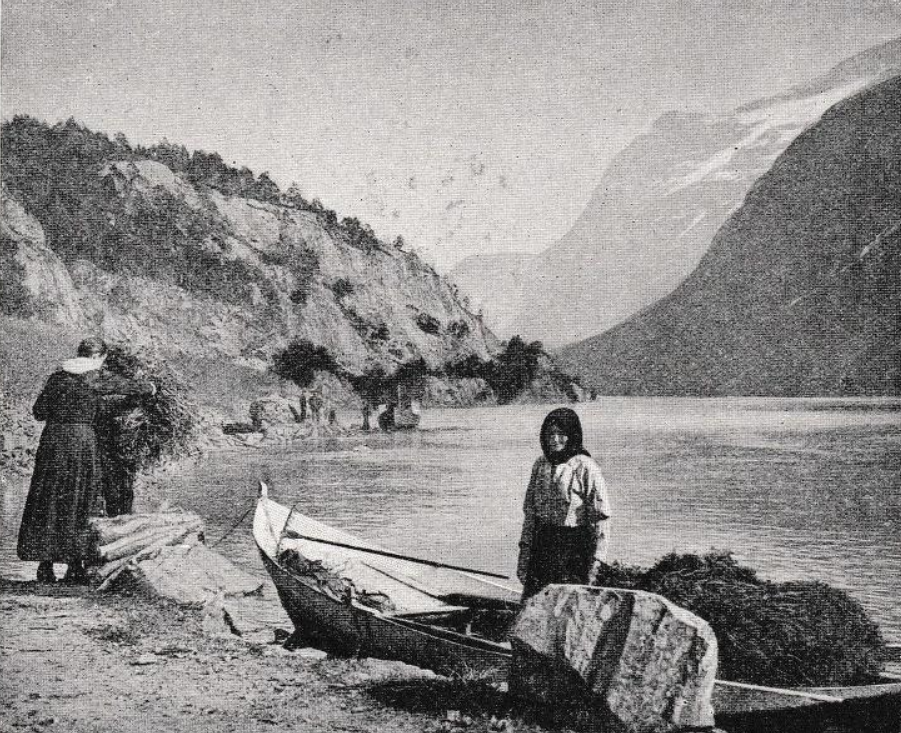
Bringing Home the Scanty Herbage Grown on the Heights
So thrifty and painstaking are the Norwegian farmers that every blade of grass on the steep hillsides is cherished for the use of the cattle during the long winter. Clipped and collected annually, these miniature mountain crops are sometimes transferred from their high altitudes to the valleys below by pulleys on long wires, and brought down the fjords to their destinations by boats.
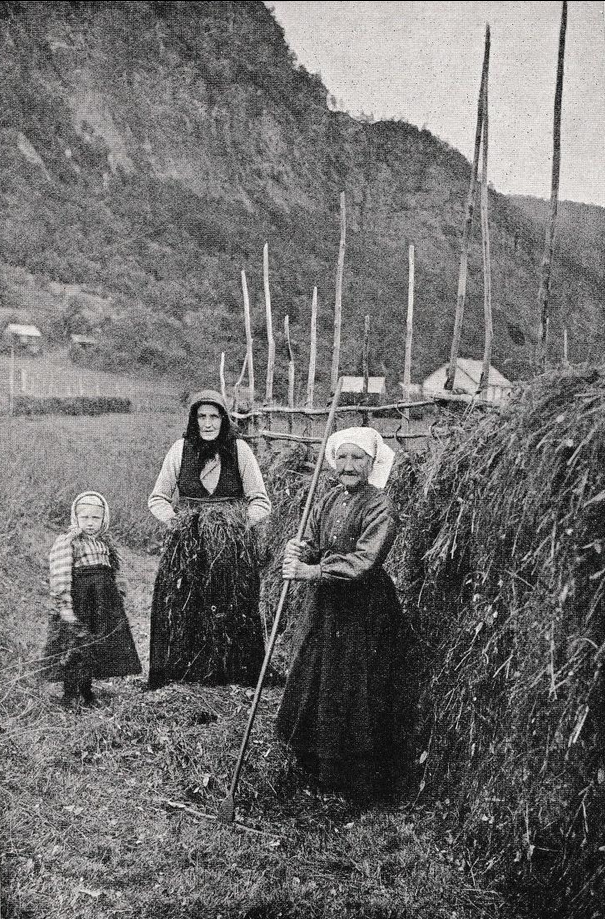
All Hands to the Rakes in the Hay-making Season
The thrift of the Norwegian people is strikingly illustrated in the way they wrest a livelihood from the narrow stretches of fertile land scattered about the valleys and mountains. About nine-tenths of the farmers own their properties - a privilege that adds a zest to toil; while nature does her share, and the vegetation is usually remarkable for the rapidity of its growth.
Only a small proportion of the total surface is suitable for cultivation, and to each farm in the valley there is generally attached an area of mountain pasture. Often these pastures are at a considerable distance from the farm. In winter the cattle are housed and fed in the farm, but every spring sees a migration en masse to the mountain pastures. The herds are driven up the steep mountain paths to the higher valleys by the girls and young women of the farms who remain with them all through the summer, living in one-roomed wooden huts, known as saeters. Much the same system used to prevail in the Scottish Highlands, where the summer pastures were known as shielings. The saeter system is one of the most characteristic and picturesque features of Norwegian country life. It is a strenuous life, for there is much milking and cheese and butter-making to be done.
The men come up at intervals from the farms with horses to carry away the produce. There is joy in the fresh air of spring after the long dark winter. The flaxen-haired, red-cheeked girls are merry at their work and quite fearless of their isolation. They bring their Sunday finery with them, and, though no church bells can be heard for a score of miles, they celebrate the holy day in the bright colours of the national gala costume, which has its characteristic features in every valley. Visits from amorous swains from the farms are not infrequent, and many a marriage follows the saeter season. Public opinion is somewhat lax so long as marriage is assured.
"Peoples of all Nations", Japan to Oman, (ca 1920) J. A. Brendon
Norway, II. From Harald Haarfager to Haakon VII Volume V at pages 3877 to 3880
NORWAY, as an organized and independent nation-state, has a very short history. It did not attain to complete autonomy until 1905. The Norwegians, on the other hand, have a long and glorious history, a history full of romance.
At one period, the Norwegians were leading actors on the European stage. They continued as such for three hundred years at least - throughout the ninth, tenth, and eleventh centuries. Yet in the eighth century Europe hardly knew of their existence; in the thirteenth century they again sank into obscurity. Only recently have they begun to re-emerge.
In the days of long ago - indeed, since time immemorial - a seafaring race, a race of fishermen, had toiled laboriously for a bare subsistence in the winding, rock-bound bays along the coast of Norway. There were not many of these men. Norway is a cold and barren land; even today it can support only a small population. In the far-off ages food was very hard to find; and the clan of one bay had often to rely for the necessities of life upon what it could plunder from the clans of neighbouring bays.
These people made war their sport, but frequently they had to make it their means of livelihood. And they comforted themselves with the belief that he who died peacefully in his bed went to hell - a hell near to the North Pole, colder even than Norway; while he who died fighting, as a man should die, went to Valhalla, and there could fight and drink forever to his heart's content.
Norway at that time was no place for weaklings. Nor was it the place for a king or settled government. For this reason the Norwegians were one of the last of the white peoples to mature. Then suddenly, in the eighth century, they burst upon the world as a race of conquerors.
Had they organized as a nation before they expanded in conquest, they must have made themselves the masters of Europe. Instead, they conquered as they had lived, without order or method; and in the end they dissipated their strength. Only now are they slowly recovering from the reckless expenditure of human energy incurred by their early ancestors. Upon Europe these wild men conferred incalculable benefits. Norway herself, however, could ill afford to lose all that virile blood which her sons lavished to enrich the races of mankind from the Baltic to the Black Sea, from the Gulf of Finland as far westward as America.
The Norwegians, being excellent craftsmen, evolved in course of time a fine ocean-going vessel for deep sea fishing. This was the famous Viking ship. The Viking ship could ride an Atlantic storm and outsail any other type of vessel then afloat. It gave the Norwegians a mastery of the sea such as no people had hitherto possessed. From the latter part of the eighth century onwards for three hundred years, it enabled them to make themselves a very terror to every other European people. Whenever the square sails of a Viking ship appeared on the horizon, the dwellers on foreign coasts fled panic-stricken from their homes, while priests prayed, but prayed in vain, for deliverance from the fury of the Norsemen.
…
From tribal foray to piracy
Prior to the Viking age, Norwegian fought Norwegian; earls and kinglets preyed one upon another. Gradually as the stronger ousted the weaker, earldoms or kingdoms - call them which you will - increased in size and strength. Inter-tribal frays thus became more hazardous and formidable undertakings. Yet honour - and necessity - still compelled chieftains to 1ive by war. So, unable to make war safely at home, they took to sailing to foreign parts in quest of plunder and adventure.
At first a chief would sail across perhaps to Denmark, or to Flanders, or to Scotland, attack some township or monastery, and then return home with the booty. In course of time, expeditions came to be conducted on more scientific lines. Fortifications were erected at the place of landing, and forays were made thence into the surrounding country. Later still, several chiefs would band together and, discarding the character of pirates, would assume that of conquerors. Even so, the Norsemen effected conquests without method; and, in the end, the vanquished, not the victors, were the gainers. Discipline, the power to endure, the will to achieve - these were the qualities the peoples of Europe acquired from their Viking masters.
Viking ships fraught with terror
During the ninth century an incessant stream of adventurers flowed from Norway. The peoples of the Baltic, the peoples of Scotland, Ireland, France and Spain, even those of the distant lands around the Mediterranean, all learned to dread the coming of the Viking ship. To England, for some inexplicable reason, only a few Norwegians found their way. Old sagas tell us of Norse chieftains who took service under the Saxon kings, and we learn of raids upon the coast, even of expeditions holding up trade and shipping in the Thames. Yet, generally speaking, they left England as a field of conquest to their kinsmen, the Danes; at any rate until the 11th century. For conquest and settlement the Norsemen favoured specially France, Ireland, Scotland and the Scottish Isles.
In 841 they plundered Rouen; in 845 they dared even to sack Paris. A few years earlier a Norse chieftain sailed up to Dublin. "After many sharp fights," according to the old chronicler, Giraldus Cambrensis, "he conquered in a short time all Ireland, and erected, wherever he went, high fortifications of masonry with deep moats, of which many ruins are yet to be seen in the country. At this time too, Norsemen frequently visited the Orkneys, Shetlands, Hebrides, and Faroe islands. There they made permanent settlements. Norse blood still flows freely in the veins of the people of these islands; Norse names are common among them.
At last towards the end of the ninth century Norway produced a really "big" man. Harold Haarfager was his name, or Harold the Fairhaired. Harold had a clearly defined idea of national unity and having by force of arms established his ascendancy over rival kinglets, he proceeded ruthlessly to reorganize the country on a feudal basis.
False dawn of national unity
To the proud and independent Norse chieftains, feudal obligations and the rule of law were quite intolerable. Why, they asked, should they not rob and plunder ? To rob and plunder had been their unquestioned privilege since none knew when. Why should they pay dues and taxes ? Such charges seemed to them to be humiliating impositions; he who submitted to them, they said, was unworthy to be called a freeman.
Thus Harold, though he made himself master of Norway, lost many of his bravest warriors. Rather than surrender their independence, these men sought homes in foreign lands. Some went to Iceland and took with them a great school of Norse poets. Others went to France - notably Rollo the Walker. Rollo had to be a 'walker'; he could not find anywhere a horse strong enough to carry his weight. Rollo and his followers ultimately accepted Christianity and, circa 912, settled in Normandy. From them sprang those men who later conquered England, Sicily and southern Italy.
While Norway was thus weakening herself by emptying her best blood into foreign countries, the savage earls of the northland continued fiercely to maintain their struggle for independence against Harold Harfaager and his successors. One of the latter, Olaf Tryggvesson (994-1000), became, during his Viking wanderings, a convert to Christianity and, when he ascended the throne, ordained that all his subjects should also be baptized. Ferocious in his Christianity, as in all else, Olaf converted by the sword. Finally, he drove his heathen earls league themselves with the kings of Denmark and Sweden, and was defeated and slain in battle.
End of the Romantic Period
For sixteen years the progress of Christianity was stayed in Norway. Then Olaf Haroldsson (1016-30) came to the throne. He is usually known as Olaf the Saint and, throughout the Middle Ages was the patron saint of Norway. During his reign Norway became a Christian country. More than a century elapsed however, before the Church was organized and given its own archbishop. The second Olaf, like the first, was a strong ruler. As such, he inevitably incurred the hostility of his nobility. Also he incurred the hostility of his powerful neighbour, Canute or Cnut, King of England and King of Denmark. Canute stirred up revolution in Norway; then, as leader of the movement he conquered and made himself master of the land (1028).
Canute's great northern empire did not survive its founder's death. In 1035, a son of Olaf the Saint - Magnus by name - who had taken refuge in Russia, restored the Norwegian throne to the house of Harfaager; and during the next few years the Norwegians showed themselves still to be possessed of national vigour. Not only did they liberate their country from the Danish intruder, but in 1066 made a bold attempt to forestall their Norman kinsmen in the conquest of England.
Anarchy, exhaustion and absorption
The Norwegian invasion was defeated by the English king, Harold, at the battle of Stamford Bridge, in Yorkshire, only three days before William the Conqueror landed at Pevensey. The battle of Stamford Bridge may be said to end the romantic period in the history of the Norwegian people. During the twelfth and thirteenth centuries their story is a dismal tale of racial Suicide. Anarchy held sovereign sway; and, under a feeble monarchy, powerless to control internecine strife, the unruly noblllty of Norway forced those brave fisherfolk, whose enterprise and daring had reshaped Europe, to wage remorselessly a fierce war of extermination on themselves.
In 1319 the house of Harold Haarfager became extinct. The crown of Norway then passed to the Swedish dynasty. Twenty four years later, Margaret of Denmark the widow of the Swedish king, succeeded - by means of the Union of calmar Calmar (1397) - in bringing the three Scandinavian kingdoms under her rule. The union was purely dynastic. Denmark, Norway and Sweden, though they acknowledged the same sovereign, remained separate kingdoms, and in each, owing to the frequent and inevitable absence of the king, the too mighty subject got more and more out of hand.
In 1523, Sweden, under the leadership of Gustavus Vasa, threw off the Danish yoke. Norway could not escape. The people of Norway by this time had exhausted their strength; their natural leaders all were slain. Norway continued as a Danish province until 1814. During these centuries the country had no individual history; its story is all part and parcel of that of Denmark.
"Empires and Barbarians: Migration, Development and the Birth of Europe" (2010) Peter Heather
Chapter 9: Viking Diasporas
Vikings and the West
In western Europe, Viking raiding began with a vengeance in the late eighth century. The first really spectacular act of Viking destruction came in 793: the sacking of the famous island monastery of Lindisfarne off the Northumbrian coast of Britain on 8 June. Within two years the raiders had worked their way around the north coast of Scotland and down through the western isles, where they sacked an Irish monastery on Raithlin.
These acts of destruction were carried out, it seems, largely by Norwegians, led to the northern coasts of the British Isles by a natural combination of winds and currents. The prevailing easterlies of springtime carried the Norwegian raiders across the North Sea to Shetland, Orkney and north-eastern Scotland. This involved braving the open sea between the coasts of Norway and Shetland, initially out of sight of the land. This was a major undertaking, but not an overwhelming one. Going from Bergen in western Norway to Shetland took no longer than coasting round southern Scandinavia through the Skagerrak and into the Baltic. And once you had reached Shetland, everything else could be done without losing sight of land. Scotland was in easy reach, and straightforward coastal routes then led the Norwegian raiders round its north coast to the Hebrides, the Irish Sea, western Britain and Ireland itself. Then - very conveniently if they had no wish to stay longer - the prevailing winds of autumn in the North Sea being, by contrast, westerlies, took them home again. If seasonal winds and currents were reversed, we might now be writing about medieval Scottish invasions of Norway.
At the same time as northern Britain and Ireland were coming under attack, there was also trouble along the coasts either side of the English Channel. Sometime between 786 and 802 (the incident cannot be placed more definitely because of the vagaries of the dating system employed by the Anglo-Saxon Chronicle), in what was possibly the first recorded raid of the Viking period, three ships containing North-men landed at Portland on the south coast of Britain. The local royal official wanted to take them to his king, but they killed him; it has been argued that he mistook them for traders. The ships were from Horthaland in Norway. Other evidence of trouble is less direct, but clear enough. As early as 792 Offa, King of Mercia and overlord of England south of the Humber, allowed a coastal monastery in Kent to prepare a place of refuge for itself further inland, safe inside the still-standing Roman walls of the city of Canterbury. In 800, the Emperor Charlemagne strengthened his defences at the mouth of the River Seine. Viking raiders had already sailed much further afield. The previous year they had made their way round the coast of Brittany to attack the monastery of Noirmoutier at the mouth of the River Loire in western France. Ten years later the Emperor decided to establish fleets at Ghent and Boulogne, their purpose again the suppression of sea-borne raids.
Like the sack of Lindisfarne, the Portland incident involved Vikings from Norway. For the most part, however, the action on this southern front in the ninth century would be carried forward by Scandinavians from Denmark. Again, this was due to facts of geographical proximity that made the eastern seaboard of England and the entire Channel zone highly accessible to Danish Seafarers. This was, however, only a tendency. 'Norwegian', 'Dane' and even 'Swede' are anachronistic categories in the Viking period. At its opening, none of the three existed as a cohesive political unit, and leaders of note recruited manpower from right across the Baltic.
Raiding
Some aspects of the violent but smaller-scale raiding characteristic of the first phase of Viking activity in western Europe are better documented than others. The action in northern Britain was both dramatic and early. Already by the ninth century, the island systems of Shetland, Orkney and the Hebrides had not only been raided, but were playing host to large-scale colonisation. This story is largely untold in historical sources, but there were already established Norse leaders in the Western Isles (Outer Hebrides) by the year 850, and, for their northern counterparts, place-name and archaeological evidence are both eloquent. In the long run, every older layer of name-giving was wiped out in Shetland and Orkney. Every name for every place in these islands derives from the Old Norse language …
Further south, in England and Ireland and on the continent, historical sources help establish some clearer patterns. Odd references to Scandinavian attacks appear in continental and insular sources for the early decades of the ninth century, but then the raiding intensified dramatically. In Irish sources, the first named Viking leaders appear in the Chronicle of Ireland for the mid-ninth century: a greater knowledge had been born of more intense contact. And the narrative confirms the point. Monasteries within Ireland, not just coastal establishments, became subject to attack for the first time in 836. To do this, the Vikings had penetrated the island's internal river systems and loughs: another sign of the greater knowledge they were building up of their target. At the same time, Channel ports were being heavily hit. Between 835 and 837 the port of Dorestad in Frisia was attacked in three successive years, while Sheppey in Kent was attacked in 835 and Wessex in 836 …
… long-distance raids were the exception, however, not the rule. Sustained attack went no further than south-western France, and the Garonne River system of Aquitaine. These assaults were eventually countered by the efforts of the rulers of the region - Charlemagne's grandson Charles the Bald and his nephew Pippin - but even Aquitaine was a sideshow compared with the increasingly intense raiding unfolding further north on either side of the Channel. Here the increase in Viking assault manifested itself in three ways: a growth in the number of Viking groups involved, an increase in the frequency and duration of the individual assaults and, as in Ireland, the spread of raiding from the coast up through the river systems leading into the interiors …
From about 850 the level of assault intensified still further. For the first time, the Vikings began to overwinter in western Europe, reducing the respite that usually came between November and March when the North Sea was too dangerous for navigation. This was also ominous for the degree of detachment it suggested in the attackers' attitudes to their Scandinavian homelands. Raiding groups occupied the Isles of Thanet and Sheppey in east Kent in the winters of 850/1 and 854/5 respectively …
… For the first time the Chronicle of Ireland noted the arrival of a Viking leader whom they styled 'king'. At the head of 120 ships, this individual set about subduing those Vikings who had already moved west, as well as extracting further tributes from the unfortunate Irish. By 853 there were two 'kings', identified in some sources as brothers, operating in Irish waters, and they had forced all the Vikings already resident in Ireland to acknowldege their leadership. They stayed in Irish waters until the mid-860s.
The identity of these kings has been much debated, but they were probably brothers - Ivar the Boneless and Olaf the White - who from 866 switched their attentions to England where, as we shall see in a moment, they started a further dangerous escalation in the level of Viking assault with the help of perhaps a third brother, Healfdan. Although this has been disputed, it is also likely that they came to the British Isles directly from Scandinavia in the 850s, and did not originate in Scotland and\or the Hebrides as has sometimes been claimed. More legendary material, preserved only in much later sources written down over two hundred years after the events, also suggests that the three were sons of Ragnar Lothbrok ('Hairy Breeches'), whose death in the snake pit of King Aelle of Northumbria, after a spectacular career of destruction in which he mistakenly sacked the Italian city of Luni thinking it was Rome, is said to have inaugurated the Viking conquest of England. None of this is at all likely, but the Ragnar of legend may indeed preserve some memory of Reginharius of Paris fame, and the importance of Ivar, Olaf and Healdan requires them to have been from a very significant family …
Danish or Norwegian Origin ?
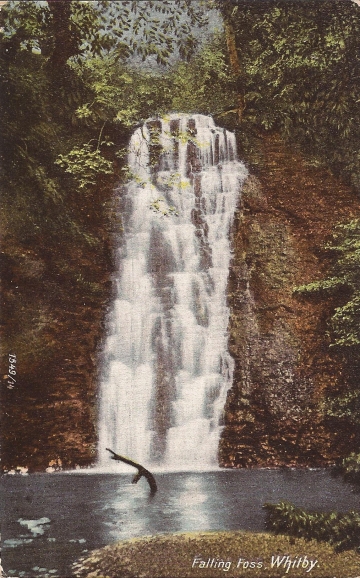
"Robin Hood's Bay lies in the ancient parish of Fylingdales. The name itself is believed to be derived from the Old English word 'Fygela' which meant 'marshy ground'. The first evidence of man in the area was 3000 years ago when Bronze Age burial grounds were dug on the high moorland a mile or so south of the village. These are known as Robin Hood's Butts. Some 1500 years later, Roman soldiers had a stone signal tower built at Ravenscar about the 4th century AD. The first regular settlers, however, were probably Saxon peasants, followed by the Norsemen. The main colonists of this coast were Norwegians who were probably attracted by the rich glacial soil and ample fish, and this is how they survived by a mixture of farming and fishing. The likely original settlement of the Norsemen was at Raw, a hamlet slightly inland, which helped to avoid detection by other pirates."
Robin Hood's Bay - its history and origins
It is frequently impossible to decide whether a particular word or personal name is of Danish or Norwegian origin. Both "by" and "thorp" were used alike in East and West Scandinavia, whereas in England, whilst "by" was clearly used by Norwegians, "thorp" may be regarded as a sign of Danish settlement. [6]
Place-names on the North Yorkshire coast ending in -dale, -by and -thorpe (e.g. Fylingdales, Whitby, Normanby, Ramsdale, Fylingthorpe, Sneaton Thorpe) are indicative of settlement by Norwegian adventurers in the ninth century AD who had joined Danish Vikings in subjugating the whole of northern England (the Danelaw) before settling there as farmers and traders and developing great mercantile cities such as York.
The word "beck" (e.g. Ramsdale Beck, Thorpe Beck), a brook, is more frequent in the Norwegian than in the Danish region, and this is also the case with the suffixes -haugh, -with, -tarn and -dale. The word "force", which is the ordinary name for a waterfall in the lake district, is exclusively Norwegian, and corresponds to the Icelandic and Norwegian foss. The word fell is also derived from Norway, where it takes the form fjeld (pronounced fi-ell). It is the usual name for a hill in the north west of England. [5]
"In conclusion, it would seem that once the Vikings began to settle in the British Isles, they intermarried with the native population and sometimes gave their children non-Scandinavian names or names newly coined from Scandinavian material. Some of these names were later carried to Scandinavia. In Shetland and Orkney Norse personal names drove out all the names employed by the earlier settlers, whether Pictish or Gaelic, whereas in the Hebrides, Western Scotland, Man and Ireland, Norse names were employed side by side and in combination with names of Gaelic origin. Some of these Norse names have survived as forenames or in patronymic surnames to the present day, even though the Norse language has been supplanted in all these areas by Gaelic and/or English.
"The Vikings and their victims: the verdict of the names" (1994) Gillian Fellows-Jensen, Reader in Name Studies at the University of Copenhagen at page 31
Click here to view further text sources regarding Old Norse place-names in and around Fylingdales.
Click here to view table of 8,731 place-names of Old Norse derivation in and around the North Yorkshire littoral parishes (Pickering Lythe, Whitby Strand and Langbargh East Wapentakes) containing one or more of 502 Old Norse original elements.
Møre og Romsdal, Norway
See also Møre og Romsdal
"The Vikings" (1913) A. Mawer at page 53
… The story of the foundation of Normandy is obscure: still more obscure is the origin and history of the leader of the Northmen at this time. Norse tradition, as given by Snorri Sturluson, makes Rollo to be one Hrólfr, son of Rögnvaldr earl of Möre, who was exiled by Harold Fairhair and led a Viking life in the west …
Mœrr f. district in Norway (Norðmœrr-Raumsdalr-Sunnmœrr; modern Møre and Romsdal) XVI:9 according to "A New Introduction to Old Norse, Part III: Glossary and Index of of Names" (2007) compiled by Anthony Faulkes and Michael Barnes at page 172.
The county of Møre og Romsdal constitutes the northern part of "Vestlandet" - the "Western Land". Numerous fjords, wild mountains and islands dominate in Møre og Romsdal. The first part of the county name probably derives from "mare", an old word for sea and, if so, Møre means "the land by the sea". Romsdal, the central part of the county, takes its name from the valley where the river Rauma flows to the sea. Romsdal is located between Nordmøre and Sunnmøre. The district of Romsdal comprises the eight municipalities of Aukra, Fræna, Midsund, Molde, Nesset, Rauma, Sandøy, and Vestnes. It is named after the valley of Romsdalen, which covers part of Rauma.
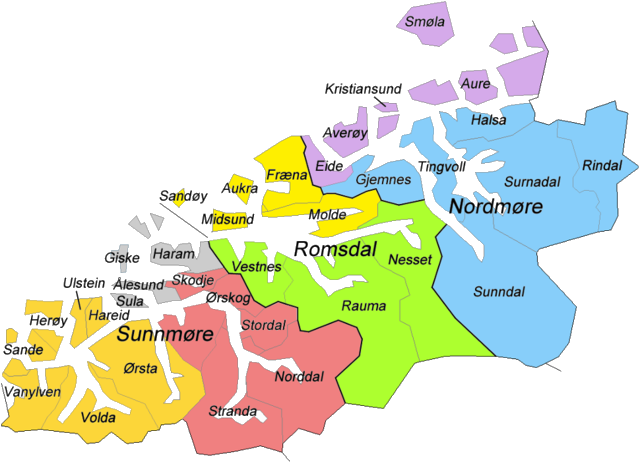
Molde and Romsdal

Molde and Romsdal
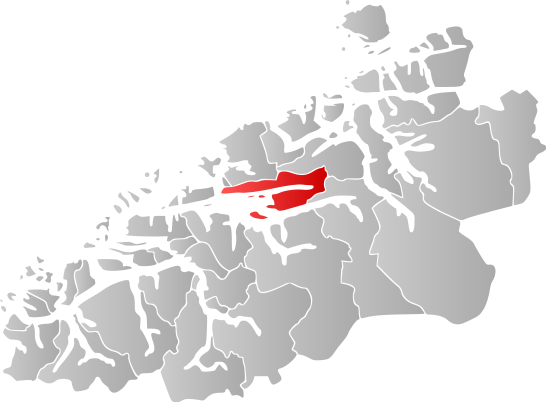
Molde
The Norse form of the name Romsdal was Raumsdalr. The first element is the genitive case of a name - Raumr - and this was probably the old (uncompounded) name of the Romsdalsfjord again derived from the name of the river Rauma - "The Dale of Rauma". The name Rauma is itself a mystery, but a clue may be found in the works of the Gothic historian Jordanes [14] who mentions a tribe called "Raumii" which might be the origin of the river Rauma. The old fjord name is derived from the name of the river Rauma in the counties of Oppland and Møre og Romsdal. It runs for 68 km from Lesjaskogsvatnet in Lesja to Åndalsnes in the Rauma Municipality (basin area 1.202 km²).
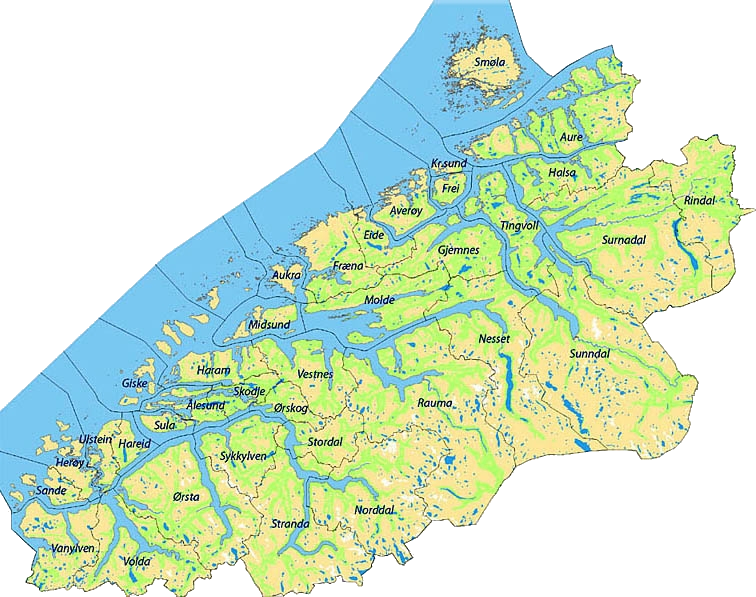
Molde and Romsdal
The meaning of the name Rauma is unknown (it is probably very old). The river was once famous for its salmon-fishing, but since an infection with Gyrodactylus salaris (salmon fluke) only 5 to 10% of the original stock survives. The Romsdal (Rauma valley) and the Rauma river is by many regarded as the most beautiful river valley in Norway. The river runs very clear with a green tint, and the mountains tower 1,500 to 1,800 metres above the river in the lower and middle parts of the valley.
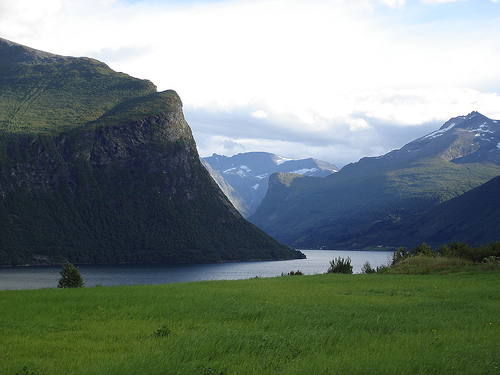
The Romsdal Valley, through which the Rauma river passes to the Romsdalfjord, has been described as a worthy rival for Yosemite, being surrounded by the mountain range Romsdalsalpene.
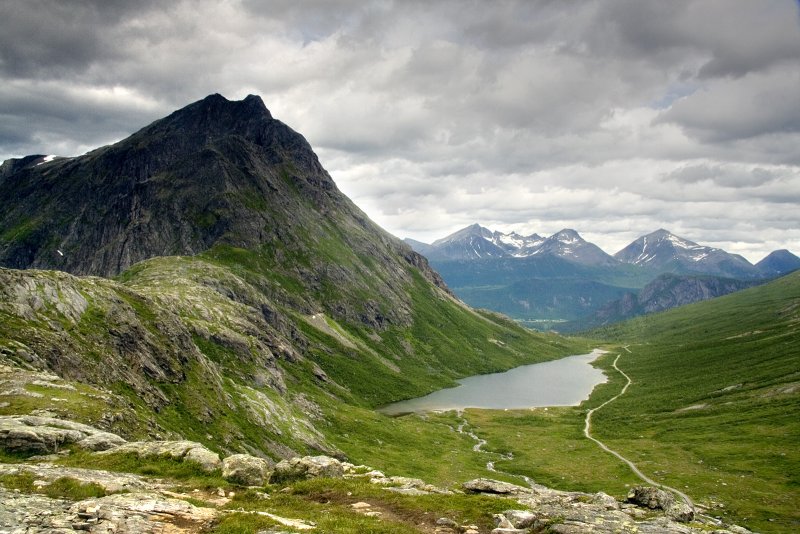
The 1,550 metre tall Romsdalhorn has been compared to the Matterhorn, while the Trolltindane peaks, according to legend a bridal procession of trolls turned to stone by the morning light, stands opposite across the Rauma. The North Face of Trollryggen peak (1,740 m), Trollveggen (Troll Wall), is the tallest vertical cliff in Europe. Norway's most famous hair-pin road is Trollstigen, or "Troll's Trail", which leads to the south out of Åndalsnes to the beautiful Geirangerfjord.
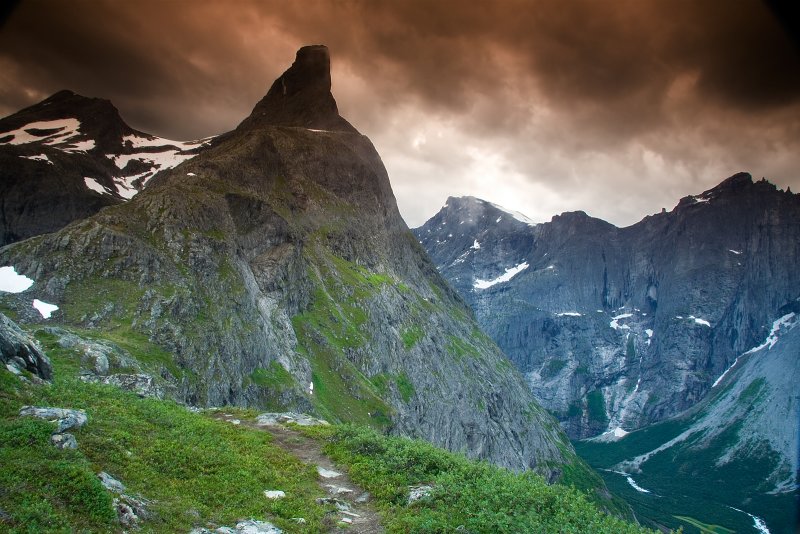
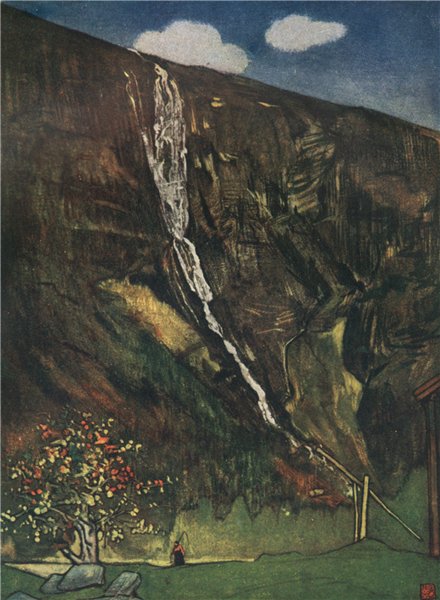
Romsdal Waterfall
Norway, Nico Jungman and Beatrix Jungman, 1905
Fosna Culture
The first traces of human settlement in Norway, the Fosna culture, are found in outer Nordmøre. The Fosna (8,300 BC to 7,300 BC) was a late Palaeolithic/early Mesolithic hunter-gatherer culture that lived by the coast in the Nørdmore district of Møre og Romsdal county in northern Norway and is named after a location in Kristiansund. The oldest Fosna settlements in eastern Norway are found at Høgnipen in Østfold. New finds (2008) on Pauler in Larvik seem to be even older. The settlements were located close to the contemporary seashore but, due to constant land uplift after deglaciation, they are now 60 to 70 metres above present-day sea level. Site locations indicate that fishing and seal hunting were important for the Fosna economy and on settlements archaeologists have only found stone tools and the remains of the production of the same. Characteristic tools include flake axes, lanceolates and tanged arrowheads.
There have been a considerable number of finds which prove that there was contact, trade and cultural influences from outside during the Bronze Age and Roman Iron Age and many objects from the first centuries A.D. originating in the southern parts of Europe have been found.
Viking Romsdal
Møre og Romsdal has given several important contributions to the development of the boat, the importance of which is evident from rock carvings. The Kvalsund boat, built about 600 A.D., is one of the forerunners of Viking sea-going sailing vessels.
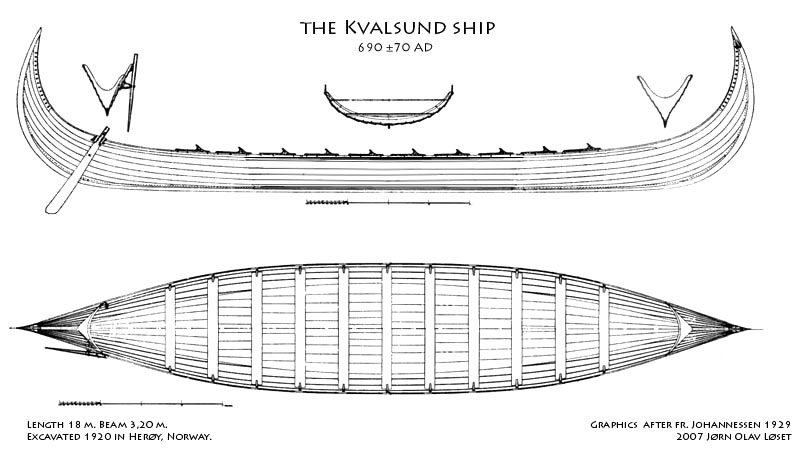
It was probably ships of the Kvalsund type which were used when the people of Møre, for the first time, headed west for colonisation, trade and Viking raids. We know that people from Møre og Romsdal set out for the Faroes, the Shetlands, the Orkneys, the Hebrides, Iceland, Ireland, the Isle of Man, England, Normandy and even lands further afield. The old sagas mention several people from the county. The main character in Gisle Surssons saga came from Surnadal. Gange-Rolv (Rollo), who was the son of Ragnvald Mørejarl (Earl of Møre), travelled to Normandy, became a Duke under the French king, founded the Duchy of Normandy and became the ancestor of William the Conqueror and the British Royal Family.
In the early Viking Age, before Harald Fairhair, Romsdal was a petty kingdom. According to legend, Romsdal is an eponym after Raum the Old, son of the equally eponymous King Nor, legendary founder of Norway.
Jøtunbjørn ("Giant-bear") the Old, was the son of Raum the Old and Bergdis, a giant's daughter. He inherited Raumsdal (modern: Romsdal) from his father, and was again the father of King Raum, who is the father of Hrossbjörn, who is the father of Orm Broken-shell, who is the father of Knatti, who had two sons: Thórolf and Ketill Raum (in one version, Thørolf and Ketill Raum are sons of Orm). Among the descendents of Thórolf, according to legend, came some of the first settlers of Iceland.
The Laxdæla Saga claims that Raumsdal was the home of Ketill Flatnose, a descendent of Ketill Raum. In the 850s AD Ketil was a prominent viking chieftain. He conquered the Hebrides and the Isle of Man. Some sources refer to him as "King of the Sudreys" (Hebrides), but there is little evidence that he himself claimed that title.
"Ketill Flatnose was the name of a man. He was the son of Bjorn the Ungartered. Ketill was a mighty and high-born chieftain (hersir) in Norway. He abode in Raumsdale, within the folkland of the Raumsdale people, which lies between Southmere and Northmere." per Laxdæla Saga
The Norwegian king appointed him the ruler of these islands, but he failed to pay tribute to Harald Fairhair and was outlawed. He and his family left Norway and fled westwards across the sea, to Scotland, then Ireland, where he married off his daughter, Aud the Deep-Minded, to Olaf the White, king of Dublin. Aud went eventually to Iceland where she began that country's shift to Christianity. The crosses she had erected to mark her places of prayer are still to be seen in their original locations.
Ragnvald Eysteinsson (830 to 890) (Norwegian: Ragnvald Mørejarl), was jarl (earl) of Møre, approximately of today's Møre og Romsdal. He died in the Orkney Islands. He was son of King Eystein "Glumra" (the Noisy) Ivarsson of Oppland, and a contemporary of King Harald Fairhair, whom he supported in the unification process, and received his fiefdom from. He is likely to have resided on or nearby the important township of Veøya, Romsdal's Viking Age hub for commerce and communication. With Ragnhild Rolfsdaughter, he had the sons Hrolf Ganger, and Tore Teiande who inherited the earldom after his father's death. Another, illegitimate, son was Turf-Einar, ancestor of the earls of Orkney. Although historians are divided on this, Hrolf Ganger might be identical with Rollo of Normandy, and if so the great-great-great-grandfather of William I of England.
The legend says Ragnvald was the one to cut the hair of King Harald Fairhair after he became king of all Norway. [10]
King Rodulf (Roduulf rex), a Scandinavian-Gaut (Germanic chieftain or petty king) of the Ranii tribe during the Migration Period in Scandza (in modern-day Norway), appears in the Getica of the Roman historian Jordanes.
Building on the now lost "History of the Goths" (Historia Gothorum) of Cassiodorus, Jordanes wrote his account at the request of Theodoric the Great, King of the Ostrogoths and ruler of Italy.
In the Getica it is said that Rodulf spurned his own kingdom, namely that of the "Ranii" tribe (which ought properly be read "Raumi", from Romsdal) and fled, likely together with a band of warriors, to seek the sanctuary and support of Theodoric in Ravenna around 500 AD.
Another unresolved issue is whether Rodulf could be the background for certain aspects of later heroic poetry, possibly including the Norse saga character Hrólfr Kraki.
Jordanes' work - an obituary of the Gothic nation - includes (Chapter XLV, sections 237 & 238) one of the earliest references to the original King Arthur, known here as Riotimus from Celtic Rigotamus "King-most", "Supreme king", later literarily confused with a Latin name, Artorius. Many of the events and dramatis personae sung about in the epic lays and sagas of the later Germanic north are described here as they originally happened. Above all, the ceaseless battles and unending bloodshed described here give us some idea of just what the decline of a civilization entails.
"De Origine Actibusque Gothorum" or "Getica" (The Origin and Deeds of the Getae\Goths) (551 AD) Jordanes, Chapter III sections 19 to 24
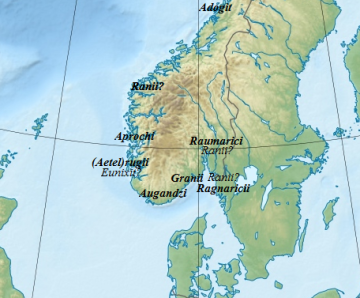
(19) Now in the island of Scandza, whereof I speak, there dwell many and divers nations, though Ptolemaeus mentions the names of but seven of them. There the honey-making swarms of bees are nowhere to be found on account of the exceeding great cold. In the northern part of the island the race of the Adogit live, who are said to have continual light in midsummer for forty days and nights, and who likewise have no clear light in the winter season for the same number of days and nights.
(20) By reason of this alternation of sorrow and joy they are like no other race in their sufferings and blessings. And why? Because during the longer days they see the sun returning to the east along the rim of the horizon, but on the shorter days it is not thus seen. The sun shows itself differently because it is passing through the southern signs, and whereas to us the sun seem to rise from below, it seems to go around them along the edge of the earth. There also are other peoples.
(21) There are the Screrefennae, who do not seek grain for food but live on the flesh of wild beasts and birds' eggs; for there are such multitudes of young game in the swamps as to provide for the natural increase of their kind and to afford satisfaction to the needs of the people. But still another race dwells there, the Suehans, who, like the Thuringians, have splendid horses. Here also are those who send through innumerable other tribes the sappherine skins to trade for Roman use. They are a people famed for the dark beauty of their furs and, though living in poverty, are most richly clothed.
(22) Then comes a throng of various nations, Theustes, Vagoth, Bergio, Hallin, Liothida. All their habitations are in one level and fertile region. Wherefore they are disturbed there by the attacks of other tribes. Behind these are the Ahelmil, Finnaithae, Fervir and Gauthigoth, a race of men bold and quick to fight. Then come the Mixi, Evagre, and Otingis. All these live like wild animals in rocks hewn out like castles.
(23) And there are beyond these the Ostrogoths, Raumarici, Aeragnaricii, and the most gentle Finns, milder than all the inhabitants of Scandza. Like them are the Vinovilith also. The Suetidi are of this stock and excel the rest in stature. However, the Dani, who trace their origin to the same stock, drove from their homes the Heruli, who lay claim to pre-eminence among all the nations of Scandza for their tallness.
(24) Furthermore there are in the same neighborhood the Grannii, Augandzi, Eunixi, Taetel, Rugi, Arochi and Ranii, over whom Roduulf was king not many years ago. But he despised his own kingdom and fled to the embrace of Theodoric, king of the Goths, finding there what he desired. All these nations surpassed the Germans in size and spirit, and fought with the cruelty of wild beasts.
"De Origine Actibusque Gothorum" or "Getica" (The Origin and Deeds of the Getae\Goths) (551 AD) Jordanes, Chapter III sections 23 & 24
Sunt et his exteriores Ostrogothae, Raumariciae, Rahnaricii, Finni mitissimi, Scandiae cultoribus omnibus minores; |
And there are beyond these the Ostrogoths, Rauma-reikians (inhabitants of the south-east Norwegian district of Rauma-reiki domain of the Raumii), Rahna-reikians (inhabitants of the south-east Norwegian district of Rahn-reiki domain of the plunderers), and the most gentle Finns, lesser than all the inhabitants of Scandia. |
Hae itaque gentes, Germanis corpore et animo grandiores, pugnabant beluina saevitia. |
… All these nations surpassed the Germans in size and spirit, and fought with the cruelty of wild beasts. |
The Christian faith soon got a foothold in Møre og Romsdal and as early as the tenth century many had brought home the Christian faith and Christian customs from their journeys overseas. The Runic inscriptions on the Kuli Stone, which was found on Kuløy in Smøla evidences christianisation shortly after 1000 A.D.
"An account of the Danes and Norwegians in England, Scotland, and Ireland" (1852) J. J. A. Worsaae, Introduction at page xvi
The Norwegian, who had now become skilled in navigating his ship through the mountain waves of the Atlantic and the far more dangerous surfs on the rocks of Norway, no longer dreaded the open sea. When the population had increased to such an extent that the Norwegian rocks could barely afford it a sufficient maintenance; when the reports concerning the rich lands beyond the sea, and their defenceless condition, promised at once renown and booty; and when, lastly, Harald Haarfager's conquests threatened the Norwegians with the loss of their freedom - then thousands of vessels shot out from the fiords of Norway, and steered dauntlessly for the neighbouring western islands. A northern life, and the severe winter's cold, had not only braced the body of the Viking to endure all kinds of hardships, and given him strength to wield the sword with effect; it had also steeled his courage, and taught him fearlessly to face all manner of danger. The clear starry firmament of the North enabled him to observe the course and relative situation of the stars, which were then the only compass by which he steered his ship towards foreign and unknown shores.
Romsdal to Ramsdale
"The Viking Longship" (1st February 1998), John R. Hale, Scientific American
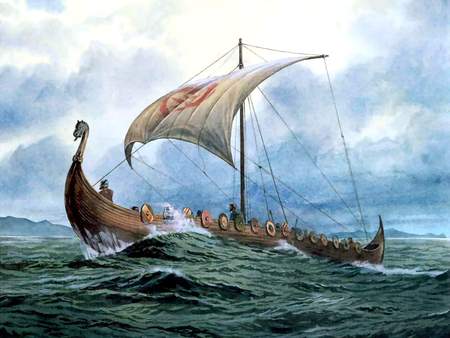
"An even more revolutionary change appeared about 700, just a century before the first important Viking raids. A ship from Kvalsund in western Norway sported an embryonic keel; the ever narrowing bottom plank finally acquired verticality with a T-shaped cross section. A fixed side rudder, the descendant of the steering paddle held over the side of earlier canoes, further stabilized the ship by projecting below the hull to prevent side slipping, like a modern centerboard. Thinner strakes, now eight in number, would make possible the more complex curves of the longships. The hardy Scandinavians stoically accepted the extra leaking around all these new seams. A Norse law regarded a boat unseaworthy if it needed bailing thrice in two days. (The crew could still choose to assume the risk.)"
"The Kvalsund ship's keel and side rudder heralded the arrival of leading performers in the drama of ship evolution that remained mysteriously in the wings until the dawn of the Viking Age: the mast and sail. Gravestone art on the Swedish island of Gotland began to depict ships with sails by 700, although the earliest physical remains of a mast come from a royal ship built in about 815 and buried at Oseberg in about 835. By then, the sail had been evolving for over four millennia, and Celtic sailing ships had been plying the seas near Scandinavia since the time of Cæsar. Norwegian archæologist Arne Emil Christensen, the greatest authority on early Viking ships and the introduction of the sail, speculates that resistance to sailing may have been less technical than cultural: tough men row. Elder Vikings at the time "must have scorned the young", Christensen writes. He imagines them deriding their sons, "who were too lazy to row as we did, and want to be blown across the sea". In the long run, however, the advantages offered by the sail prevailed."
"A pole, or spar, on the deck connected to a lower corner of the sail. Moving the spar angled the sail, which allowed the ship to tack into the wind. Rowing had carried the immediate ancestors of the Vikings east to Russia and west as far as the British Isles, but with the sail, the explosive career of the Vikings truly started. And the sail dictated most of the final steps of Viking ship evolution, including deeper keels, broader hulls and higher sides. The Viking longships, the direct descendants of the Stone Age canoes, soon found themselves surrounded by a family of related ship types that took advantage of the evolutionary potential to be found in the mast and sail. New designs proliferated, like Darwin's finches in the Galápagos, to fill every available environmental niche. Many of the newcomers were specialized sailing ships built for trade, exploration and colonization, such as the famous knorrs - stout ships with deep holds that carried Vikings across the Atlantic to America …"
"The early Viking ship types" (2014) Eldar Heide, Western Norway University of Applied Science at pages 88 to 93 with additional definitions from "An Icelandic-English Dictionary" (1869) Richard Cleasby and Gudbrand Vigfusson, "A Concise Dictionary of old Icelandic" (1910) Geir T. Zoëga, "Edda" (1998) Anthony Faulkes, and "A New Introduction to Old Norse: Part III Glossary" (2007) Michael Barnes.
Ship-type terms of the early Viking Age
- ægir m. ocean … in kenning for ship, jór ægis
- askr m., (1) 'ash, ash-tree' … (3) 'a small ship made of ash'
- ask-maðr, m. shipman, viking, pirate, cf. askr (3)
- Askvitull m. a ship ('a bit of an askr')
- Atall m. sea-king; in kenning for ship (part of kenning for Viking)
- bára f. wave, bore (also the name of one of Ægir's daughters) … in kenning for ship, báru fákr
- barði m., 'a kind of ship', a ship with a projection at the front for ramming, 'ram'; 'beaked' (cf. barð; barði possibly means one with strengthening or a projection on the stem for ramming
- bátr m., 'a boat'. When batr is mentioned in sagas, it generally refers to multi-purpose vessels. However,the construction and basic features of all these ships were still the same.
- beit f., poetical 'a ship'
- bersi m. '(little) bear', hypocoristic or diminutive of bjǫrn (cf. bjarki); in kenning for ship, skorðu bersi
- bjǫrn m. bear … in kennings for ship, bjǫrn undinna festa
- blakkr m. (black or pale-coloured) horse; in kennings for ship, svana strindar blakkr
- búza, buss f. a large (war and cargo) ship, usually a merchantman, of the 13th century, carrying heavy bulk cargo across the North Sea, and would not have been a good warship, since it required ease of movement.
- byrðingr m. coaster, ship for transporting heavy cargo (especially driftwood) with high sides
- byrr m. (fair) wind, sailing wind … in kennings for ships (with viggjar), byrjar drǫslar
- drasill (plural drǫslar) m. horse, in kennings for ship(s), drasill skorðu
- dreki m., (1) 'dragon'; (2) large warship usually with a dragon's head on the prow and/or stern
- drómundr m. a very large war-ship used on the Mediterranean
- dýrblik n. 'beast-gleam'; Heita dýr, beast of the sea-king, is a kenning for ship
- dýrin wild animals; in kenning for ship, ægis dýr
- eik f., 'oak'
- eikja f., (1) 'a small ferry-boat'; (2) a small row-boat or ferry (originally made of a dug-out oak trunk)
- elgr m. elk; in kenning for ship, elgr flóðs
- elliði m., (1) 'a kind of ship' … (2) Elliði m. name for a ship … elliði is used for longships and therefore has not kept the same associations as the Slavonic words;
- fákr m. horse (poetical; implies a fine, lively horse); in kenning for ship, báru fákr
- far, n., literally 'a means of transport, trading vessel, a ship, vessel, boat'
- ferja f., 'a ferry'
- festr f. rope; in kenning for ship, bjǫrn undinna festa
- fjarðlinnr m. fiord-serpent, i. e. ship
- flaust n., (1) literally 'something floating, ship' (2) a word for ship (general term, cf. fljóta)
- fley n., wherry, ferry; also used of warships and merchantmen; literally 'something floating'
- flóð n. flood; in kennings for … ship(s), bjǫrn flóðs
- foldvigg n. 'land-horse', in kenning for ship, Ræfils foldvigg
- fura f. poetical word for ship (made of fir or pine, metonymy)
- furðu mikit skip, an amazingly large ship
- galeið f. galley, a type of ship used in the Mediterranean
- Gautrekr m. a sea-king … in kenning for ships, Gautreks svanir
- Geitir m. a sea-king; in kenning for ship, Geitis marr
- gjálfrstóð n. 'surge-horses', 'a fleet of ships'
- Glaðr is the name of a mythical horse, Glaðr kjalar slóða 'horse of the keel's path, i.e. of the sea' is a kenning for ship, whose steersman is a seafarer, meaning Gunnarr
- Glaumr m. (1) Atli Buðlason's horse; in kenning for ship, Gylfa rastar
- goti m. horse (the name of Gunnarr's horse; originally perhaps 'Gothic horse'); in kenning for ship, sólborðs goti
- haf n. 'sea' … in kenning for ship, hafs otr
- hafreið f. lifting carriage, carriage that moves up and down (see hefja; or sea-carriage = ship, cf. haf), in kenning for ship, hafreið hlunns
- hafskip n. 'seagoing ship'
- hafskíð n. 'sea-ski' = ship
- hafskip n. 'ocean-going ship'
- haf-Sleipnir m. 'sea-Sleipnir', kenning for ship
- Haki m. a sea-king, brother of Hagbarðr; in kenning for ship, Haka vagn
- harðvigg n. 'tough horse', in kenning for ship, harðvigg umbands allra landa, 'tough horse of the ocean'
- hauss m. 'skull, figurehead on a ship'
- hefja; 'sea-carriage' = ship, cf. haf)
- Heiti m. a sea-king; in kennings for ship, Heita hrafn
- hemlir m. 'having rowlocks, a ship'
- herskip n., 'warship'
- hestr m. 'horse'; in kenning for ship, hestr lauks
- hjǫrtr m. hart, stag; in kenning for ship, vengis hjǫrtr
- hǫfðaskip n. ship with figurehead(s) at prow and/or stern; dragonship
- hlátrelliði m. 'laughter-ship' (see Elliði), breast or trunk (of the body); hlátrelliða kjǫlr = backbone
- hlunnr m. plank (for supporting a ship or for standing it on); a piece of wood forming part of a slipway (for launching ships); in kennings for ships, vagnar hlunns, hafreið hlunns, hreinn hlunns
- hlunnvísundr m. 'slipway-bison', kenning for ship
- hlunnvitnir m. 'slipway-wolf', i. e. ship
- hógdýr n. gentle, tame (or pliant?) beast, in kenning for ship, húna hógdýr
- Hrafn m. (1) King Áli's horse; in kennings for ship, Heita hrafn
- hrannvalr a. wave-horse (or -falcon, cf. hrafn), i. e. ship
- hrauð f. … (2) a ship ('plunderer'? or hrǫð, 'swift'?)
- hreinn (2) m. reindeer; as name for ship … also in kennings for ships, Sveiða hreinn
- húnn m. (2) 'hound' … in kennings for ship, húna hógdýr
- íugtanni m. … in kenning for ship, húna íugtanni
- jór m. horse; in kenning for ship, á jó strengjar
- karfi m., (1) 'swift-going ship, galley'; (2) carvel, a kind of ship between a small rowing boat and a large sailing ship, larger than 10 smálestir i. e. tons, probably not for ocean journeys
- kaupskip, OE céapscip 'merchant ship'
- kenning f. description, designation … for the purposes of periphrastic description
- kjóll m., (1) poetical 'ship'; (2) a kind of large ship (cf. OE ceol)
- knörr OE cnear m., (1) 'a ship, especially a merchant-ship, opposite to 'langskip'; (2) 'a large high-sided ocean-going ship usually used for transport and trade rather than warfare'; sem knǫrru as well as merchant ships (3) medium or large ship with 'bosom-like' stem; For unknown reasons, in Hakon's Saga the word 'knorr' is used only once to describe cargo vessels. Otherwise, the word 'byrðingr' (see above) is used for this purpose.
- kuggr m. 'cog', a broad-beamed ship with high rounded prow and stern used for trade in the later Middle Ages
- langskip n., (1) 'longship'; (2) a Viking warship, probably not a distinctive type, but a general term
- lið n. 'vessel, ship' (cf. líða; OE lid 'ship')
- lung n., OIr long 'a ship', an early synonym for langskip
- mór m. poetical word for horse, once a proper name … mór Marnar is a kenning for ship
- Marnar see Mǫrn
- Mǫrn f. name of a river (Marne?); in a kenning for ship
- Nóatún n. plural 'enclosure or field of ships', kenning for the sea
- naðr m., 'a snake, dragon'
- nǫkkvi m., 'a small boat rowed with a pair of sculls, a cock-boat'
- nór m., (reflected in the name of the god Njorðr's residence) (1) 'a smith's trough'; (2) brandnór 'hearth ship, house'; (3) Nóatún 'ship farmyard'; (4) nór m. is a poetical word for 'ship'
- œringr, boat type described by its number of oars
- ǫlstafn m. ale-vessel (stafn stem (of a ship) = ship by synecdoche)
- ǫndurr m. ski, snow-shoe; Eynæfis ǫndurr kenning for boat … varrar ǫndurr = ship
- ǫrk f. a kind of ship … a kind of boat used on the Elbe in Saxony; … or Noah's ark?
- otr m. (1) 'otter'; (2) in kenning for ship, hafs otr
- raðálfr m. ship-elf (cf. rǫð), seafarer, sea-king (Hǫgni?) (genitive with herr; or with mar, making a kenning for ship
- Rær m. a sea-king, in kenning for ship, Ræs reið
- ræsinaðr (rs) m. splendid (rushing?) serpent, dragon-ship
- regg n., 'a kind of ship'
- reggbúss m. 'ship-(box-)tree'
- Reifnir m. a sea-king whose roof is a shield, in kenning for ship, Reifnis marr
- reið f. carriage, chariot … in poetry, 'ship' (basic sense 'vehicle') in kenning for ship, Ræs reið
- riðmarr m. quivering, swaying, rocking, tossing horse; in kenning for ships, riðmarr Róða rastar
- rein f. a strip of ground … in kenning for sea, land of ships, Haka vǫgna rein
- rǫð f. a kind of ship
- rǫst f. a kind of ship
- Sessrúmnir m. Freyja's hall; a ship
- sjágnípa f. sea-crest, high wave; in kenning for ship, sjágnípu Sleipnir
- skautbjǫrn m. 'sheet-bear', part of kenning for ship: Gusis nauta skautbjǫrn, 'bear of the sheet of Gusir's gifts', i. e. of the sail
- skeið f., (1) 'war-ship, galley'; (2) 'large longship' (larger than a snekkja)
- skíð n. (long) piece of wood … in kennings for ship, Meita útvers skíð on a ship, by ship; the kenning is taken to be Meita skíð; vetrliði skíða (it is unusual for skíð to be the determinant rather than the base-word of a kenning for ship)
- Skíðblaðnir m. Freyr's ship
- skip n., 'a ship'; in kennings for poetry, skip dverga; skip does not relate to any particular type but rather is defined by context
- skjǫldr (genitive skjaldar, dative skildi, plural skildir) m. shield … in kenning for ship, viðr skjaldar (generic sg.; shields fastened along the side of a ship looked like leaves on a tree)
- skúta f. (1) medium or small-sized multi-purpose ship; (2) … (2) a light but fairly large ship, larger than a ferja, though sometimes the words seem to be interchangeable; not all that common; perhaps generally = tólfæringur; (3) sometimes a seagoing vessel of large size
- skær m. horse; in kenning for ship, stjórviðjar skær
- Sleipnir m. Óðinn's horse, offspring of Loki; in kennings for ship, sjágnípu Sleipnir
- slóðgoti m. 'track-, pathway-horse', in kenning for ship, slóðgoti sæðings horse of the gull's path
- snekkja f. (1) 'a swift sailing ship'; (2) kind of large warship, generally with 20 rowing benches and a 90-man crew, smaller than a skeið (OE snacc)
- snœrivitnir m. 'wolf of ropes', kenning for ship
- sólborð n. 'sun-board', the uppermost plank on a ship's side, or an extra row of planks above the rail (perhaps used in measuring the elevation of the sun in navigation, or the strake just above the surface of an unladen ship, which is perhaps more likely) … in kennings for ship, sólborðs goti, sólborðs hestr
- Sǫlsi m. a sea-king; in kenning for ship, Sǫlsa bekkr
- stafn m. stem (of a ship; or the position at the prow, forecastle) … plural by synecdoche = ship(s)
- stefknǫrr m. refrain-(cargo-)ship
- stjórvið f. = stjórnvið; in kenning for ship, stjórviðjar skær
- strengr m. (bow-) string; hagl strengjar = arrows … cable (particularly to moor a ship); in kenning for ship, jór strengjar
- storskip 'large ship'
- strind f. (bank of) land; in kenning for ship, svana strindar blakkr
- stǫð … harbour, landing-place; in kenning for ships, stǫðvar hrafnar, flóðs stǫð
- súð f. planking … often by metonymy = ship … (instr. plural, 'with a ship')
- sund n. sound, strait … in kenning for ships, sunds dýr
- svanr m. swan; Gautreks svanr = ship (genitive plural with brautar); svana strind = sea, in kenning for ship
- Sveiði m. a sea-king; in kenning for ships, Sveiða hreinar
- sæðingr m. seagull (common gull) in kenning for ship, sæðings slóðgoti
- sæskip n. sea-ship, ocean-going vessel
- unndýr n. wave-beast, i. e. ship, in kenning for warriors, seafarers, unndýrs runnar
- útver n. fishing place in an outlying place, on an island; = land in kenning for sea, Meita útver; Meita skíð is adequate as a kenning for ship
- unnvigg n. wave-horse, kenning for ship
- vagn m. carriage, chariot, waggon … in kennings for ships, vagn hlunns
- vébraut f. 'sacred road, standard-path, warpath' = the sea? (genitive with ræsinaðr, the rushing serpent of the sea, a kenning for a dragon-ship) …
- vengi n. poop, a raised deck in the stern of a ship, perhaps forming the roof of a cabin … in kenning for ship, vengis hjǫrtr
- vetrliði m. 'winter-passer', 'winter-survivor', a name for a (one year-old?) bear (or refers to hibernation?); in kenning for ship, vetrliði rastar
- viðr (1) m. tree … wood (material, of a ship) … plural timbers (of a ship) in kennings for ship, viðr skjaldar
- viðr hauðrmens 'timber of the sea' is a kenning for ship
- vigg n. horse; poetical word for a ship … perhaps originates in kennings or is a 'half-kenning'
- viggr m. horse; in kenning for ship
- Vimur f. a river waded by Þórr … appears in Ǫrvar-Odds saga in a kenning for ship in Einarr Skúlason's poem about Sigurðr Jórsalafari
- víngnoð f. wine-ship (Gnoð is the name of a ship); Hertýs (Óðinn's) víngnoð is one of the vats containing the mead of poetry, bailing which is to produce verse
- vǫrr (2) m. wake (of a ship), or the marks on the surface of the water caused by oars … in kennings for ship, varrar ǫndurr, viðr varra
- þetta et mikla skip the large ship
- þrafni m. beam; þrafni byrjar 'ship'
Terms for ship types only used in poetry:
- beit, n.
- eik, f.
- flaust, n.
- lung, n.
- nór, m.
- regg, n.
In addition, askr, elliði and kjóll have very limited use in prose … The list is made by comparing:
- ON Ship Names and Ship Terms (1912) Rudolf Simek with
- Lexicon Poeticum, Fritzner 1883 - 1896 Finnur Jónsson, and
- A Dictionary of Old Norse Prose - http://dataonp.hum.ku.dk/.
Names of Viking Age Ships
- Árakló f. name of a ship ?
- Barði as name of a ship (= Járnbarðinn)
- Barðkaldr m. 'prow-cold', name for a ship
- Elliði m. name for a ship (Ketilbjǫrn's ship)
- Fáfnir m. name of a dragon = dragon-ship
- fartíðr m. 'frequent traveller, travelling delight', name for a ship
- freki m. 'bold one, greedy one', name of a ship
- Gnitaheiðr f. … name for a ship (from the gurgling noise it makes when sailing)
- Gnoð name of a ship
- Hélugbarði m. 'icy-prowed', name for a ship cf. Barðkaldr
- Hreinn m. a ship
- hringr m. … (3) name for a ship: with a curled or spiral stem; cf. hringlot = having a curved or bowed stem; cf. Hringr and Hringhorni(r)
- Hringr m. a ship
- Hringhorni m. Baldr's ship
- hugró f. upper hilt, pommel of a sword. Hugróin f. is the name of a ship in Hákonar saga
- Hugróin f. a ship
- húnn m. (2) 'hound', mast-top, a four-sided structure fixed to the top of a mast, crow's-nest; … in kennings for ship, húna hógdýr, húna íugtanni
- hylbauti m. 'depth-striker', name for a ship
- hǫmlungr m. 'oar-strapped', name for a ship (or 'having rowlocks', cf. hamla)
- Járnbarðinn m. name of a ship (with an iron strengthening or projection on the prow for ramming)
- knarrasmiðr m. 'ship-builder', nickname
- knúi m. knuckle; name for a ship ('thruster' ?)
- Knúi m. legendary person (cf. Ǫrvar-Odds saga; also a shipname
- Leifnir m. a sea-king … a ship
- Móðrói m. a ship
- Naglfari m. a mythical ship
- Ormr enn langi 'the long serpent', Óláfr Tryggvason's ship
- Reifnir m. a sea-king whose roof is a shield, in kenning for … ship, Reifnis marr
- Sessrúmnir m. Freyja's hall; a ship
- Skálpr m. name for a ship
- Skíðblaðnir m. Freyr's ship
- Skjǫldr m. (2) a ship
- Stígandi m. a giant (cf. Gǫngu-Hrólfs saga; also a ship in Landnámabók, Vatnsdœla saga)
- ugla f. owl; fastening or batten on a ship; name for a ship
- þekkr m. 'pleasant, delight', name for a ship
"The Tune Viking Ship Reconsidered" (12 March 2020) Dr Knut Paasche
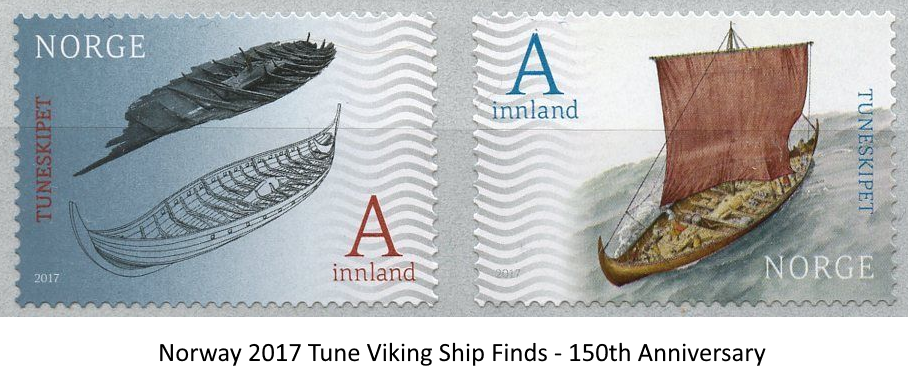
Introduction
A Viking ship somewhat neglected by scholars since its excavation in 1867 at Østfold is about to return to the spotlight. Scientific analysis has revealed that the Tune ship, built around AD 910, was probably the fastest of its era. The ship was excavated from a burial mound in the southeast Norwegian parish of Tune in the 1860s and is exhibited in the Viking Ship Museum in Oslo. It is smaller and less complete than the Gokstad and Oseberg ships in the same museum and has received less attention from researchers.
Knut Passche, of the Norwegian Institute for Cultural Heritage Research, used laser scans to measure the ship's surviving fabric for the first time and create a 3D model that is the basis of his new digital reconstruction allowing analysis of its seafaring qualities. About half of the boat survives and he recreated the rest based on extrapolation from the existing fabric, the structures of other ships and Viking art. The ship had a flatter bottom helping it to carry the powerful rig, whilst its sharp keel stabilised it at sea and prevented drift. The shape of the front would have given it the lift to ride above the waves. The higher sides protected the sailors in rough seas, while allowing them to easily jump out on raids.
Given its sophisticated design, Dr Paasche believes the Tune would have been faster than other Viking vessels, including the Gokstad, which could travel at 10-12 knots. He believes it may have provided a chieftain or king with fast transport along the Scandinavian coast with a small squad of fighting men. It would also have been capable of crossing the North Sea to Britain where the Vikings had extensive settlements. Dr Paasche said early Norwegian archæologists had missed the significance of the boat because:
"they didn't actually talk to people who knew boats and ships".
In contrast, he sails and is in touch with traditional Norwegian boat builders. The next stage of his research will be to build a scale model and ultimately a full-sized version for trials at sea.
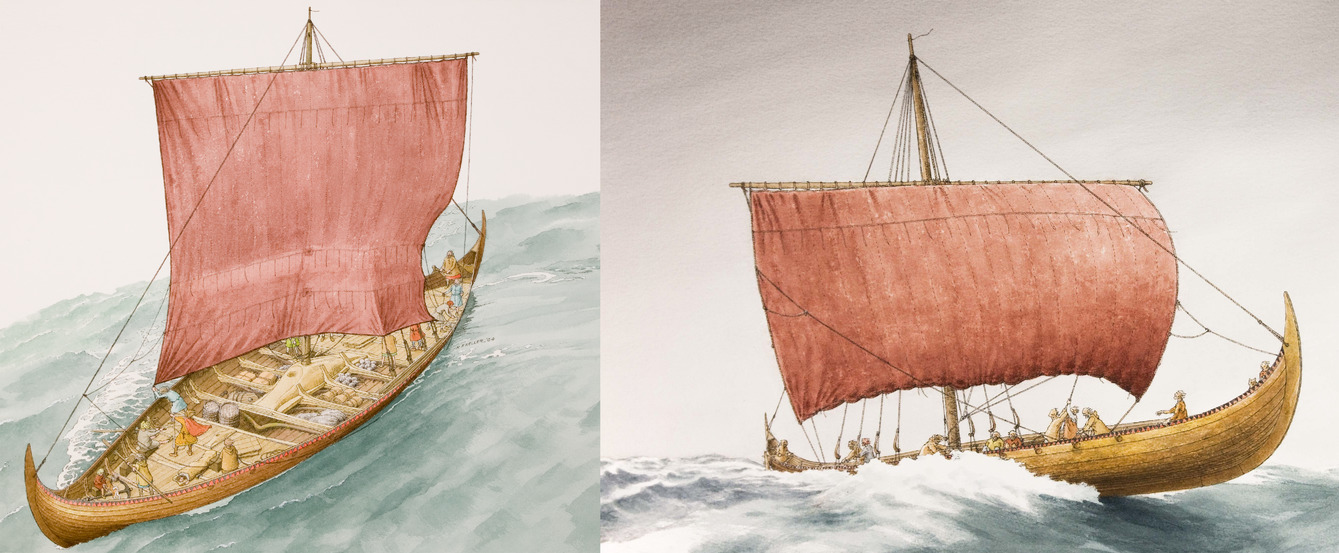
The Tune ship under sail
(Reconstruction Knut Paasche, watercolour Karl-Fredrik Keller)
Sail and rig
While at about 18 metres (57.33 Old Norse feet - 0.314m) the Tune ship was shorter than the more famous ships in the museum, it had a mast and sail of comparable size. The mast was at least 10 metres (31.85 Old Norse feet) and the sail about 100 sqm. According to an oral tradition still alive on the west coast of Norway today, the mast's length should be equal to the circumference of a circle with the diameter equal to the ship's widest point. If this rule is applied to the Tune ship, its mast would have been just under 10m high. In addition to its sailing rig it had room for 12 oarsmen on each side. The length-to-beam ratio of the hull shows that the Tune ship was primarily built for sailing rather than for rowing. Sailing vessels from the Viking Age all seem to be designed to tack, which is reflected in the choice of rigging, rudder, and hull shape that can stand up to strong winds and heavy waves. The Tune ship's form probably gave it good balance in a tailwind. At the same time, the characteristics necessary to achieve sailing ability limit the ship's design.
The ship's capabilities at sea
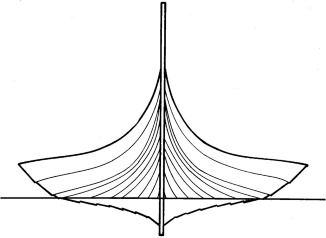
Experimental data shows that an open ship with a low freeboard works well since it pushes the bow wave out and underneath the hull, lifting the ship in the water … The arrangement of the strakes gives a good entrance fore, and a good run aft, which is of particular importance for this type of combined rowing-and-sailing vessel. The Tune ship's concave entrance likely gives it enough bearing or lift and enough sea pressure to stay on top of the seas during heavy crossings. This will provide the necessary lift in the bow, and it is likely that the ship will also be lifted up somewhat by its own speed.
Pronounced sharpness of the keel makes sure that the ship does not lose contact with the water and, hence, prevents excessive drift. In traditional Norse boatbuilding it is common that the hull 'grows', meaning that the front of the ship is slightly wider. This also applies to the Tune ship, albeit not so distinctly that we can say that the ship has a 'cod's head and mackerel tail', it is not truly teardrop shaped … The shape of the Tune ship's hull is different above and below the waterline. The quick-works are relatively narrow fore, but somewhat wider in the aft. The opposite is true for the dead-works. This probably helps the ship to push water away and provides the necessary lift in the front.
Robust frames gave the ship the strength it needed to survive heavy seas, while the system of cleats and lashings has several advantages: by lashing the floor-timbers to cleats, the vessel reduces the number of holes through the bottom, improving water tightness. In addition, it is possible that fewer treenails left protruding on the outside of the hull meant less resistance and a smoother hull and therefore allowed for higher speeds.
The shipbuilders of vessels such as the Tune ship, with its detailed, carefully considered design, solved the problems related to bearing, lift, speed, and balance that arise when a ship's hull meets the sea. The ship's low mid section and sharp keel would have helped to stabilize it at sea, something very important for a ship of this size that would have carried a powerful rig of mast and sails. The centre of the ship with strong mast attachment in the form of heavy frames and mast knees, keelson, and mast partner is solid evidence that the Tune ship was sailed. The shape of the hull is determined by the curve of the keel, the hull's length and width, and the shape and placement of the strakes. A smoother transition between bottom and sides, a greater freeboard, and a stronger attachment for mast make the Tune ship more of a sailing vessel than the Oseberg ship, which can be seen as more of a combined rowing-and-sailing vessel.
Overall, there are many factors which speak to the excellent sailing capabilities of the Tune ship. Carefully considered and probably tried-and-tested details show that the ship was built for ocean voyages. Brøgger and Shetelig describe the Tune ship as 'quite seaworthy' and 'a sharp sailor for tailwind', despite expressing surprise at the ship's low freeboard … The combination of a powerful mast mounting and consequently a large rig with a sharp entrance, not to mention very good bearing due to its flat bottom, are clear indications that the Tune ship could have been fast under sail, similar to the replicas of the Gokstad ship that have often achieved a speed of 10 to 12 knots. It is shorter than the Oseberg and Gokstad ships, but, proportionally, it could have been fitted with the same rig. Flat planks along the bottom also provide steadiness in strong, gusting winds: from this perspective, the Tune ship could very well have been a better sailor than the Oseberg ship, and certainly safer.
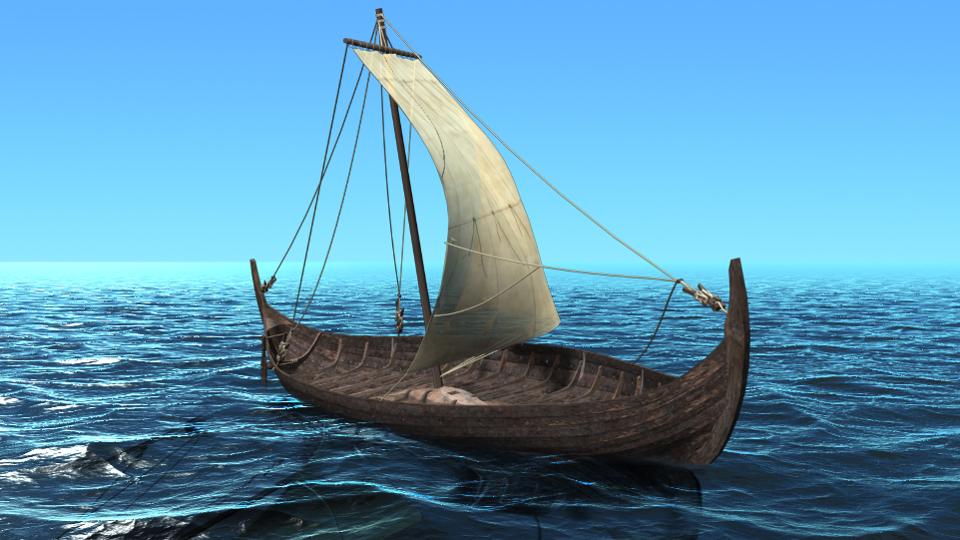
Dating and typological features
By studying remains of carved pieces of what had probably been a saddle and by comparing artefacts from the Tune ship site with bronze ornaments from the Gokstad ship, Schetelig set a date of approximately AD 900 for both. The dating of the vessels to the Norwegian early Iron Age and Viking Age has subsequently been determined through dendrochronological dating. The latest surviving tree ring in the sample taken from the Tune ship burial has been dated to the year AD 892. After being adjusted for missing sapwood and the time between the timber being felled and being used, Nils Bonde dates the construction to between AD 905 and 910. The samples were corrected again in the final analysis, giving a year closer to AD 910.
Changes in typological features are a very important part of maritime history and can help us to determine ship types and uses. For example, both the shape of the hull and the system for securing the mast changed during the Viking Age and into the Middle Ages. While the scarcity of ship finds from the early Iron Age provides a weak basis for developing a chronological series, we can say with certainty that society's need for oceangoing vessels changed throughout the Viking Age.
Based on what we know about the ships of this period from the written sources the number of ships purely for overseas raids increased from the late 700s onwards. From the mid 800s, an increase in the transport of goods and/or trade, emigration, and occupation of land abroad created the need for more cargo-efficient ships. Large, specialized warships - the long ships - are first seen in the 900s and made the relocation of larger armies in conjunction with regular warfare possible, including in conflicts on the other side of the North Sea. The growth of cities on a large scale in the early Middle Ages, and hence the need for large-scale shipping, inspired further specialization, visible in larger commercial vessels such as Skuldelev 1. In such a concise historical framework, the Tune ship should be characterized as a relatively well-developed rowing-and-sailing vessel, with good sailing capabilities, undoubtedly a dependable oceangoing vessel. However, it would not have been particularly well suited to carrying cargo. With little load capacity, but still room for many men on deck, the Tune ship was best-suited to the rapid transport of many people and a smaller amount of cargo. As a warship it would have worked well, although it is much smaller than the really big ships we see towards the end of the Viking Age and into the Middle Ages, such as the Skuldelev ships in Roskilde.
… The Tune ship helps confirm a distinction between the first sail-powered ships of the late Iron Age and the more sophisticated ones that come along during the transition from the late Iron Age into the early Middle Ages. Again, with such a small sample it is difficult to distinguish change over time from variety within a single assemblage, but with this in mind, there seems to be a conscious development to increase load capacity. Besides combined rowing-and-sailing personnel carriers, pure sailing vessels developed in this later period … A higher freeboard and more internal timbers make the ships less suitable for rowing.
Future research
… This interpretive reconstruction of the Tune ship provides a new understanding of the archaeological ship material from the late Iron Age, despite this find having been available to researchers for 150 years. Perhaps the most important finding is that, despite its clear resemblance to the Gokstad and Oseberg ships, Tune is in many ways very different. They are all clinker-built, Nordic-type vessels and almost prototypes for what we know as Viking ships, yet there are also significant differences between them. Oseberg is long and narrow with an extremely low freeboard. The Gokstad ship is far more powerful with the keelson spanning four frames, a stronger mast support system and a higher freeboard. Finally, the Tune ship: short, wide, flat-bottomed with good bearing aft, and possibly with the largest sail area in relation to its total size. The three ships give the impression of having been built for slightly different tasks, or perhaps different answers to the same challenge.
By the end of the 9th century the Scandinavians had shifted their attention from plundering to invasion, mainly due to the overpopulation of Scandinavia in comparison to resources and arable land available there. Shetland was colonised by Norsemen in the 9th century, the fate of the existing indigenous population being uncertain. The colonisers gave it that name and established their laws and language. In 866 Harald Finehair (Harald Hårfagre) made the first of a series of conquests over the many petty kingdoms which then comprised Norway. In 872, after a great victory at Hafrsfjord near Stavanger, Harald found himself king over the whole country. His realm was threatened by dangers from without as large numbers of his opponents had taken refuge in Iceland (then recently discovered) and the Orkney, Shetland, Hebrides and Faroe Islands. His opponents' leaving was not entirely voluntary. Many Norwegian chieftains (Jarls), who were wealthy and respected, posed a threat to Harald and they were therefore subjected to much harassment prompting them to vacate the land. From the Northern Isles they continued to raid Scotland and Norway, prompting Harald in 875 to raise a large fleet which he sailed to the Scottish mainland and islands to clear them of those Vikings hiding there.
The purge of 875 may have encouraged or forced a group of Norse Vikings to leave the Shetland Islands and sail south down the east of England to find a safe haven in which to settle - possibly Robin Hood's Bay and Ramsdale. Having arrived it was customary for such Norse invaders to give their name to the place where they settled - Romsdal or Raumsdalr (the Norse form of the Norwegian name Romsdal) which has, in time, become Ramsdale. Place-names ending in -dalr were only given to localities to which the generics were lexically appropriate and the generic dalr is of frequent occurrence in place-names in Scandinavia, where in hilly and mountainous areas it generally refers to a longish valley running between hill or mountain ranges. Fitting the description of such a valley, Ramsdale Beck falls sharply through a series of waterfalls and rapids down a steep narrow gorge in Oak Wood (olim Ramsdale Wood) lined on both sides by ramsons (wild garlic) which completely cover the beck's banks up and down stream. Ramsdale Beck joins and becomes Mill Beck and enters Robin Hood's Bay at Boggle Hole.

Molde wind rose annual plot
(August 2011 to January 2017)
A wind rose can quickly indicate the dominant wind directions and the direction of strongest wind speeds. This wind rose indicates frequencies of wind direction and wind speed at Molde (at the mouth of the Romsdalsfjord) over the period August 2011 to January 2017. Click here to view monthly wind roses for Molde, which climatological data indicates the most and least favourable months in which to sail to and from Southwest Norway (Molde), the Shetland Isles and North Yorkshire.
"The Norse Settlement of North Scotland in its Geographical Setting" (1934-6) Andrew C. Odell Saga Book of the Viking Society Vol. XI at pages 256 to 259
… The first Norse immigrants to Scotland, as has been shown by the work of the Faroese philologist Jakobsen, were peasant immigrants of the eighth century from Agder and Rogaland. That they came from the Möre and Agder districts of S.W. Norway is shown by the distribution of "setr" and "land" place names in that part of Norway - which root is common in the north of Scotland.
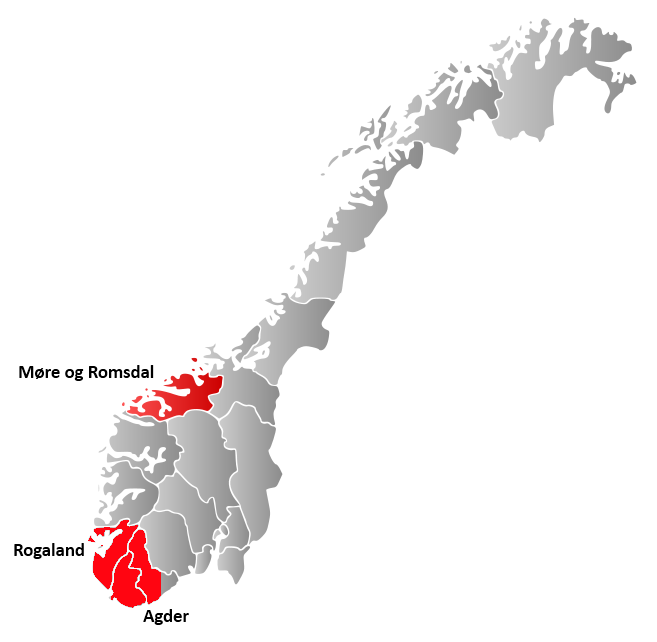
These peasant immigrants were succeeded, at the period of consolidation in power of Harold the Fairhaired, by a set of adventurers. The Shetland Islands have been proved by Brøgger to have been later settled than most southerly regions by the Norse. The peasants married with the aborigines, it was not as so often imagined an extermination settlement, but one of peaceful penetration, and probably in time they brought the thrall women from Norway, who were also dark, and this perpetuated the dark strain in the Shetland Islands.
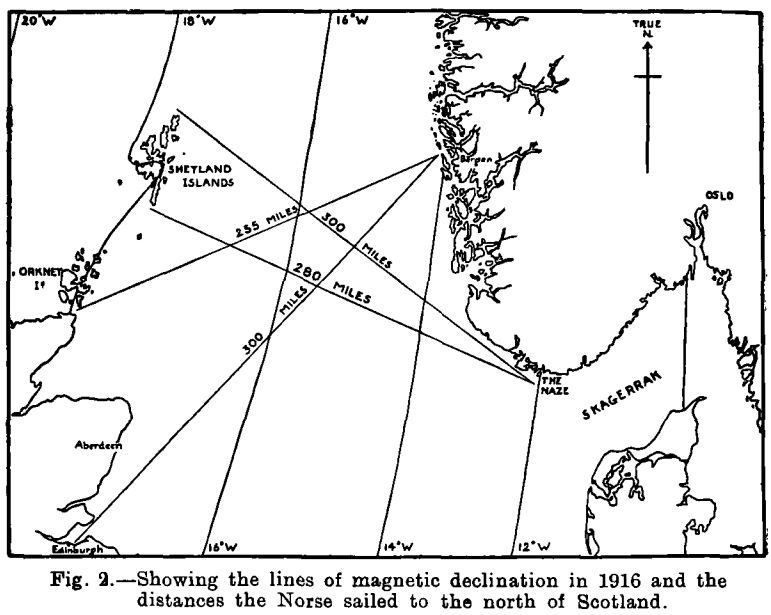
To reach the north of Scotland the Norse had nearly three hundred miles to sail across the North Sea, in the main against prevailing winds. The shortest distance is from Bergen to Caithness and this may account for the focusing of Norse penetration on that point of the seaboard, apart from its nodal character for passing down the west or eastern seaboards.
The third diagram shows the prevailing winds for May and September. The upper figure for May shows that, when the crops were sown, there is a marked north and easterly component for the average winds which, making the assumption that they have not appreciably changed since Norse times, would allow a more easy seasonal passage to the west.
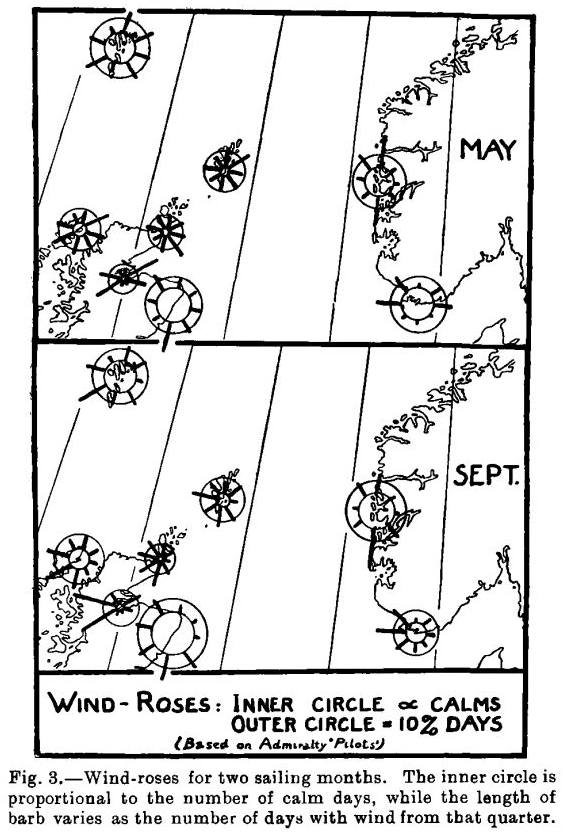 |
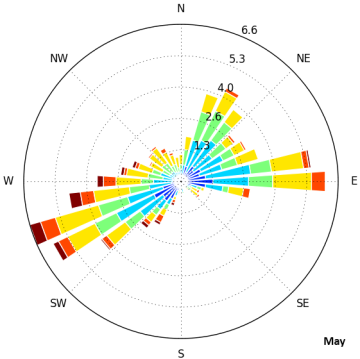 |
 |
|
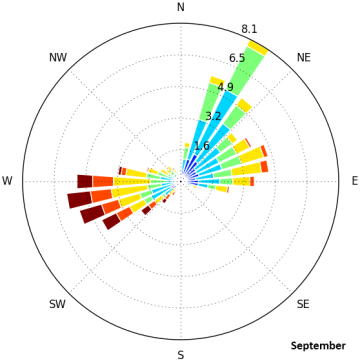 |
The Norse landed on the seaboard, and if they were on a marauding expedition failed to have any deep influence on the settlement, but even if they came as settlers it is noteworthy that they failed to go far into the interior. A study of the place names of a parish as that of Farr in Sutherland shows that the Norse did not settle a great distance inland, and the clean cut line between the two types of names in Strath Naver shows that it was a peaceful occupation of the land. The settlement seems to have been discontinuous, based as it was on a command of the sea.
… To conclude, the Norse settlement of the north of Scotland took place when the Viking ships were able to navigate the northern waters, and the peoples who crossed left an impression on the place names of the region which still persists to the present …
It is likely that the Norse vikings (Englands-fari) who invaded and settled in and around Ramsdale travelled by longship (Englands-far) from Møre og Romsdal (Romsdalsfjord) to Robin Hood's Bay (possibly stopping en route to reprovision at the Shetland archipelago which had been colonised by Norsemen) being a far shorter, safer and more direct route than via Dublin and the Wirral across England to the east coast.
 |
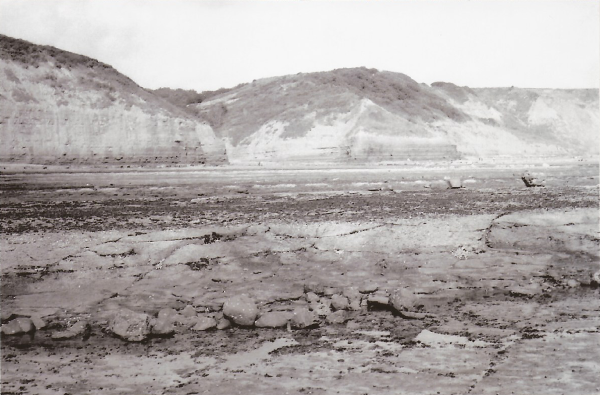 |
| Low tide in Robin Hood's Bay. 1972 photographic images looking inland at the coast (a) south of Boggle Hole (right image) and (b) north of Boggle Hole (left image - the wooded cleft on the right), showing the wave cut platforms of rock. These layers of Jurassic rock are rich in fossils especially ammonites. The whole area is a site of special scientific interest where hammering of the bedrock is not permitted. | |
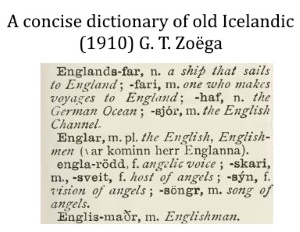
"A Concise Dictionary of Old Icelandic" (1910) G. T. Zoëga at page 115
- Englands-far, n. a ship that sails to England
- Englands-fari, m. one who makes voyages to England
- Englands-haf, n. the German Ocean; the English Sea, i. e. the North Sea between England and Norway
- Englis-maðr, m. an English man
- Englands-sjór, m. the English Channel
"An Icelandic-English Dictionary" (1874 & 1957) Richard Cleasby and Gudbrand Vigfusson at page 141 entry 23
FAR, n. I. motion, travel; … II. a means of passage, a ship; … in compounds, a trading vessel:
- Íslands-far, an Iceland-trader
- Englands-far, an English-trader
- fari, a sea-farer … Englands-fari, an English seaman
- far-sumar, the season for sea-faring
- far-sæll, speeding well in voyages
- far-drengr, far-maðr, a seaman, sea-faring man
- víkingligr, like a viking, martial
- víkingr, a freebooter, rover, pirate … The word 'víkingr' is thought to be derived from vík (a bay), from their haunting the bays, creeks, and fjords; or it means 'the men from the fjords'.
"An Icelandic-English Dictionary" (1874 & 1957) Richard Cleasby and Gudbrand Vigfusson at page 712 entry 1
- Englands á vit, towards England
"In the North Riding, in the western half … there is very definite evidence of extensive Norse settlement, as well as on the coast near Whitby, the latter, no doubt, reached directly from the North Sea." [11]
"Normanby, found four times in Lincolnshire and three times in the North Riding, was a village where Norwegians lived among an overwhelming Danish population. The distribution of these names is interesting and unexpected. They provide evidence for Norwegians in the eastern Danelaw who could hardly be Vikings from Ireland. They may have been Norwegians who had joined the armies of Halfdan and Guthrum, and the scanty evidence of their presence in the eastern Midlands may be due to the known hostility between Danes and Norwegians. The capture of York from the Danes and the establishment of a Norwegian kingdom would not conduce to friendly relations, and the Anglo-Saxon Chronicle of the tenth century not only gives proof of the internecine feuds between them but also provides proof of similar hostility farther south …" [12]
As the hrafn (raven) flies, the orthodromic distance from Veøya (olim ON Vé-ey, 'holy island') in Romsdal [13], situated at the mouth of the Romsdalsfjord to:
- the Shetlands, is 280 nautical miles;
- Robin Hood's Bay (Ramsdale), is 580 nautical miles;
- Lindisfarne ('Holy Island'), Northumberland, is 520 nautical miles (ON sigla milli Vé-ey ok Lindisfarne, to sail between the Holy Islands of Veøya and Lindisfarne).
The average speed of Viking longships varied from ship to ship but lay in the range of 5 to 10 knots with a maximum speed, under favourable conditions (ON veðr siglanda, 'weather fit for sailing'), of around 15 knots: see Longships and Viking Ships.
Assuming no stop-over in the Orkneys or Shetlands, the 580 nautical mile non-stop journey by longship from the Romsdalsfjord to Robin Hood's Bay (ON veðr-sæll, 'blessed with good weather') would have taken between:
- 58 hours (at 10 knots) - circa 2½ days and
- 116 hours (at 5 knots) - circa 4⅔ days
and, if undertaken in autumn and winter (October to January) with the benefit of the prevailing north-easterlies (ON veðr-staða 'the standing direction of the wind' - see also ON brýnn byrr, 'a straight, fair wind', ON hag-stæðr, 'fair, favourable, of wind and weather', ON hag-byrr, 'a fair wind', ON veðr hagstætt, ON stór veðr ok hagstæðr), the direct non-stop journey under sail (at 15 knots) from the Romsdalsfjord to Robin Hood's Bay would likely have taken no more than 39 hours (circa 1½ days).
For a supposed but plausible (ON vestr-víking, 'freebooting expedition to the West') from the holy island of Veøya (ON forn siðr/inn forni siðr, the ancient, heathen faith) to the Christian holy island of Lindisfarne (founded in 634 by Saint Aidan), again assuming no stop-over in the Orkneys or Shetlands, the 520 nautical mile journey by longship would have taken between 52 hours (at 10 knots) and 104 hours (at 5 knots) and, if undertaken in autumn and winter with the benefit of the prevailing north-easterlies, the direct 520 nautical mile journey under sail (at 15 knots) from Veøya to Lindisfarne would likely have taken no longer than 35 hours (circa 1½ days - ON hálfan annan dag sigling).
The sacking of the island monastery of Lindisfarne took place on 8th June 793, in which month the prevailing winds are predominantly west-southwest and north-northeast making the outward journey from Veøya (assuming a favourable north-northeasterly on or about 5th June) faster and less onerous than the post-sacking return journey from Lindisfarne to Veøya on a west-southwesterly (if available).
Having sacked the island monastery of Lindisfarne, the Viking raiding party (ON langskipa-menn) would have performed 'the last honours' for any fallen friend or relative (assuming ON víkingr fatalities during the raid) while awaiting favourable sea and weather conditions (ON fœrt veðr, 'weather fit for travelling') for their return journey to Veøya. The "great and imminent danger" the ON víkingr faced would have encouraged them to set sail (ON sigla um) and leave Lindisfarne promptly regardless of whether or not the sea and weather conditions were entirely favourable i.e. on 'a straight, fair wind' (ON brýnn byrr) from the west-southwest. However, it is possible that the raiding party's return to Veøya was less hurried than we might imagine. In "The Real Middle Earth: Magic and Mystery in the Dark Ages" (2002) Professor Brian Bates records at page 28 that
"The monastery of Whitby in Yorkshire was raided in 867, and a stone mould for casting ingots found at Whitby Abbey may have been used by Vikings for melting down and sharing out the looted treasures."
Perhaps, after 74 years' experience of sacking coastal monasteries, Viking raiding parties were in no hurry to get back to their longships knowing they had sufficient time to share out the plunder and await a ON brýnn byrr or at least ON veðr siglanda.
"An account of the Danes and Norwegians in England, Scotland, and Ireland" (1852) Jens Jakob Asmussen Worsaae at Section VI, page 48
… A short stay would easily have sufficed to erect a runic or bauta-stone; and great and imminent indeed must have been the danger which threatened the Northmen of the olden time if he omitted, even on a foreign soil, to perform the last honours for a fallen friend or relative …
Time and Travel in Old Norse Society
Thorsteinn Vilhjalmsson, Science Institute, University of Iceland
Published in Disputatio, II: 89-114, 1997
… "So the wise men say, that from Stadlandet in Norway there is seven days' sailing to Horn in the East of Iceland, but from Snæfellsnes four days' sailing to Cape Farewell in Greenland."
"The most important and the best substantiated of these data is the first point of the trip from Norway to Iceland, a stretch that was very frequently sailed. The distance in question is about 530 nautical miles so that the average time of 7 days corresponds to 76 miles per day or 3.2 knots on average. Such an average implies that single voyages might well have been twice as fast, thus taking only 3-4 days, say. All of this fits fairly well with information from other sources and also with modern experiments with replicas of Viking ships."
For longship sailing speeds see the Viking Ship Museum website.
Five ships from the Viking Age were excavated between 1957 and 1962 in the Roskilde fjord, near Skuldelev. In order to protect the Danish capital from intruders, these five ships had been filled with stones and scuttled to create a barrier in a natural channel in the Roskilde fjord. These five ships provide a snapshot of a Viking-age harbour of circa 1030-1050:
| Ship | Type | Date | Crew | Average Speed (knots) | Top Speed (knots) |
|---|---|---|---|---|---|
| Skuldelev 1 | ocean-going trader | circa 1030 | 6-8 | 5-7 | 13 |
| Skuldelev 2 | great longship | 1042 | 65-70 | 6-8 | 13-17 |
| Skuldelev 3 | coastal trader | circa 1040 | 5-8 | 4-5 | 8-10 |
| Skuldelev 5 | small longship | circa 1030 | 30 | 6-7 | 15 |
| Skuldelev 6 | fishing vessel | circa 1030 | 5-15 | 4-5 | 9-12 |
When longships were at their finest (circa A.D. 1050), an average Viking ship could sail at about 5-10 knots (6-12 mph), whereas a Viking longship could travel at up to 17 knots (20 mph).
The longships' light, economic construction was a major factor behind their success. Modern replicas have achieved speeds of up to 14 knots. In marked contrast to modern sailboats, the ships' lack of a big, vertical keel meant that they were highly maneuverable and could easily penetrate shallow surf and river estuaries. Seafarers steered using a single side rudder on the right, the 'starboard' or 'steering board' side. (The term 'starboard' is thought to have originated in the Viking era - see ON stjórn-borði above.) They could also reef the square sails in strong winds and adjust them to permit rapid tacking.
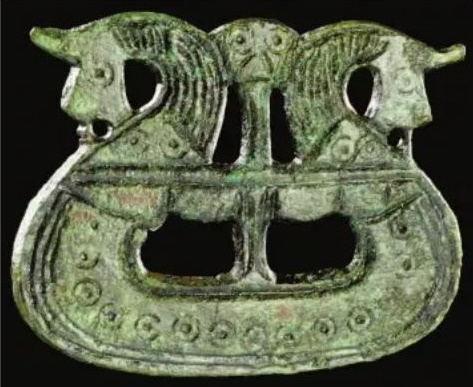
Brooch shaped like a Viking ship with reefed sail (Frey's Skíðblaðnir?)
found in 2007 at Tjørnehøj, not far from Odense
"An Icelandic-English Dictionary" (1874 & 1957) Richard Cleasby and Gudbrand Vigfusson at page 594, entry 27
stjórn-borði, a, m. [Anglo Saxon steôrbord; English 'starboard'], (sounded stjór-borði), the starboard side.
"An Icelandic-English Dictionary" (1874 & 1957) Richard Cleasby and Gudbrand Vigfusson at page 594, entry 28
stjórn-byrðingr, m. a starboard man.
The Reef Knot
"An Icelandic-English Dictionary" (1874 & 1957) Richard Cleasby and Gudbrand Vigfusson at page 498, entry 37
ríða knút, to knit a knot.
"A Concise Dictionary of Old Icelandic" (1910) G. T. Zoëga at page 339 entries 13, 14 and 15
rif, noun, (1) reef in the sea … (2) reef in a sail … (3) tearing asunder (4) plundering.
"A Concise Dictionary of Old Icelandic" (1910) G. T. Zoëga at page 340 entry 12
ríða, (ríð, reið, riðum, riðinn), verb (1) to twist, knit, wind; ríða knút, to tie a knot …
The phonetic pronunciation of ON ríða knút (reetha noot), 'to tie a knot', suggests that it may be the derivation of 'reef knot', a quick release knot which a Viking raiding party could use to secure their longship when hauled up on a beach. At sea it is always employed in reefing and furling sails but its usefulness to the Norsemen would also lie in its tendency to capsize (spill) when one of the free ends is pulled outward so that it could be undone swiftly to allow a quick getaway. It can be undone as follows:
| Untying (leysa knút) | |
| Step 1: Pull either end straight upwards until its curves have been pulled into a straight line. In this example, the yellow end has been pulled straight. The blue end is still wrapped around the yellow end with a double-loop. |  |
| Step 2: Simply slide the blue double-loop up and outwards along the yellow lace until it falls off the end. |  |
A reef 'knot', might better be described as a 'bend' or a 'hitch':
- a 'knot' only refers to a 'tucking knot' in which the strands of a rope are unravelled and then tucked over and under each other to form a 'stopper knot', a knob or enlargement in the rope so that the end of a rope could not be pulled through an eye;
- a 'knot' implies a permanent fastening whereas a 'bend' or a 'hitch' is used as a temporary measure;
- a 'bend' or 'hitch' is used to join one rope to another or to an object e.g. when sails are fastened by ropes they are 'bent to' masts, yards and booms. The anchor cable is said to be 'bent' to the anchor;
- 'hitches' are the same as bends but they are hitches' if so named - 'half-hitch', 'rolling hitch', 'clove-hitch'.
"An Icelandic-English Dictionary" (1874 & 1957) Richard Cleasby and Gudbrand Vigfusson at page 346, entry 29
knútóttr, adjective, knotted
"An Icelandic-English Dictionary" (1874 & 1957) Richard Cleasby and Gudbrand Vigfusson at page 347, entry 1
KNÚTR, m. [English 'knot'; Danish knud; Swedish knut] a knot; leysa knút, to loosen (untie) a knot; ríða knút, to tie a knot; knýta knút, to knit a knot … III. a proper name, Knútr, m. Cnut, Canute: mar-knútr
"An Icelandic-English Dictionary" (1874 & 1957) Richard Cleasby and Gudbrand Vigfusson at page 238, entry 24
hand-rif, n. … 'hand-reefing', a nautical term, in the phrase, svipta hand-rif, to reef a sail …
"An Icelandic-English Dictionary" (1874 & 1957) Richard Cleasby and Gudbrand Vigfusson at page 497, entry 15
RIF, n., genitive plural rifja, dative rifjum, [English 'rib, reef' … ] a rib … II. a reef in the sea; … frequent in modern usage of reefs connecting two islands, but flooded over at high water, whence the local name Rif-gerðingar in western Icel. III. nautical, a reef in a sail … rif-hind = a 'reef-hind', i.e. a ship.
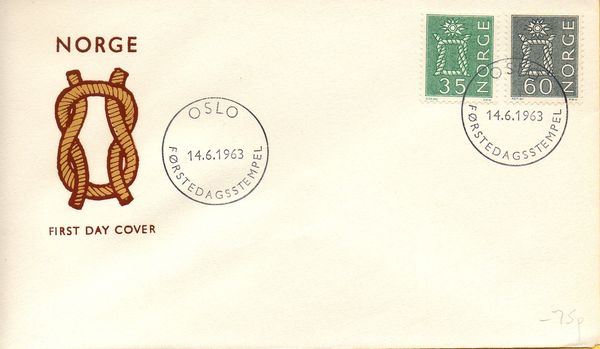
Norway first day cover issued Friday, 14th June 1963
(35 and 60 øre reef knot definitives)
The reef knot - at least 4,000 years old - has always been used by sailors to tie the reef points of a sail when reefing and furling sails when the wind increases. A reefed sail reduces heeling of the boat and makes the boat easier to manage. It also reduces the risk of capsizing in a gust. The reef knot is featured in the Norwegian 'boatman's knot' definitive postage stamp series first issued on 14 June 1963:
 |
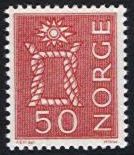 |
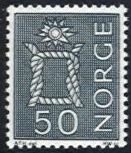 |
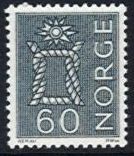 |
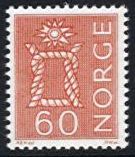 |
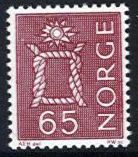 |
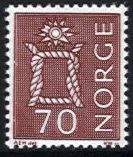 |
| 35 øre Emerald | 50 øre Red | 50 øre Grey green | 60 øre Grey green | 60 øre Red | 65 øre Red | 70 øre Brown |
"An Icelandic-English Dictionary" (1874 & 1957) Richard Cleasby and Gudbrand Vigfusson at page 579, entry 4
sólar-steinn, m. a sun-stone or loadstone, = leiðarsteinn, used by sailors to find the place of the sun on a cloudy day:
- Fornmanna Sögur v. 341
- Biskupa Sögur i. 565, 674
- Auðunnar-máldagi 52
- Pétrs-máldagi 20, 81
leiðar-steinn, n. a loadstone; þá höfðu hafsiglingar-menn engir leiðarstein á Norðrlöndum, "then the mariners had lode stones in the north lands"; Landnámabók (Hauks-bók) 28, Konráðs Saga 29; eptir himin-tungla gang ok eptir leiðarsteini, idem leiðar-stjarna, u, f. the lodestar, Symbolae 31, Rímbegla 464, Fornmanna Sögur x. 112, Maríu Saga.
"An Icelandic-English Dictionary" (1874 & 1957) Richard Cleasby and Gudbrand Vigfusson at pages 581, entry 48 and 688, entry 1
spár, adjective, spá, spátt, [spá]: prophetic …
veðr-spár, adjective, 'weather-spaeing', weather-wise, Landnámabók 231.
The sunstone (Icelandic Spar) hypothesis stems largely from a 13th-century manuscript, St Olaf's Saga, in which the hero Sigurd tells King Olaf II Haraldsson of Norway where the sun is on a cloudy day. Olaf checks Sigurd's claim using a sólarsteinn or sunstone:
Olaf grabbed a sunstone, looked at the sky and saw from where the light came, from which he guessed the position of the invisible Sun.
Another 13th century tale called Hrafns Saga provides further detail:
The King looked about and saw no blue sky … then the King took the sunstone and held it up, and then he saw where the Sun beamed from the stone.
Perhaps the most infamous example of this preferred direct route from Norway being taken was the first spectacular Viking raid on the British Isles when, on 8th June 793, the island monastery of Lindisfarne off the Northumbrian coast was sacked and destroyed by Norse raiders. Lindisfarne (Holy Island) is approximately 120 nautical miles north of Robin Hood's Bay (and Ramsdale). This and similar acts of destruction were largely carried out by Norwegians, led to the northern coasts of the British Isles by a natural combination of winds and currents. The prevailing north-easterlies of autumn and winter (October to January) carried the Norwegian raiders across the North Sea to Shetland, Orkney and north-eastern Scotland and the prevailing winds of spring and summer (March to July) in the North Sea being, by contrast, westerlies, took them home again. This involved braving the open sea between the coasts of Norway and Shetland, initially out of sight of the land. Sailing from Bergen (or Romsdalsfjord) in western Norway to Shetland took no longer than coasting round southern Scandinavia through the Skagerrak and into the Baltic. And upon reaching Shetland the rest of the journey could be undertaken without losing sight of land. Scotland was in easy reach, and straightforward coastal routes then led the Norwegian raiders either
- south to the east coast of England (Holy Island monastery sacked in 793, Sheppey in Kent attacked in 835 and raiding groups occupied the Isles of Thanet and Sheppey in east Kent in the winters of 850/1 and 854/5); or
- around the north coast of Scotland to the Hebrides, the Irish Sea, western Britain and Ireland.
The Norwegian fleet took this direct route when it embarked on an expedition to attack Scarborough in September 1066 under Harald Hardrada as it had possibly also done in 1058 under Harald's son Magnus:
Scarborough 966-1966 (1966) Mervyn Edwards (ed.), Scarborough and District Archaeological Society Research Report No. 6, at page 19
Some such attack on England had been impending for a long time, though the Scandinavians whom Tostig [19] had tried to interest in the project of a conquest of England had always been well aware of its dangers and doubtful of its profit …
Tostig's raids on his brother's kingdom [15] in 1065 were manned by Flemish mercenaries and were known to William the Conqueror in Normandy, but were also supported by Harald Hardrada's men from the Norwegian territory of the Orkneys. Late that winter Harald began collecting a force for an expedition against England, the greatest ever seen in Norway. He had nearly 200 ships (which would imply about ten thousand men), cargo vessels full of stores, and small boats. The fleet got split up on the crossing from Norway, and some landed in Orkney whilst Harald himself ended up in the Shetlands where he stayed some time. As we know that there were strong westerly winds in the Channel in early September that year, Harald's stay in Shetland may not have been entirely voluntary, as it would be very difficult for him to get to the southward against a wind which was probably stronger in those latitudes than it was in the Channel, and south or south-westerly. In the second week of September the wind went round to the north (and the weather presumably improved, as the depressions had passed over) and Harald set off for England, making an unopposed landing north of Scarborough in Tostig's own territories [16]. It was therefore natural that he should ask Tostig the name of a hillock near their landing-place. Tostig attempted to turn the question aside saying 'We don't give names to every hillock' but Harald persisted, and learnt that it was the burial mound of Ivar the Boneless, son of the legendary Ragnar Loðbrok and leader with Halfdan of the great Viking army which had attacked York in 866. Harald's sad reply 'Few have conquered England who have landed by this mound' shows him already seeing evil omens, and Tostig's attempted reassurance that this is mere superstition suggests that there was (or was later believed to have been) some belief that the mound was unlucky, though it is difficult to understand why, as Ivar was one of the most successful Viking leaders. Possibly the obscure 'fleet from Norway' under Harald's son Magnus which raided England in 1058 had landed there, but this is pure speculation. It certainly had not conquered England.
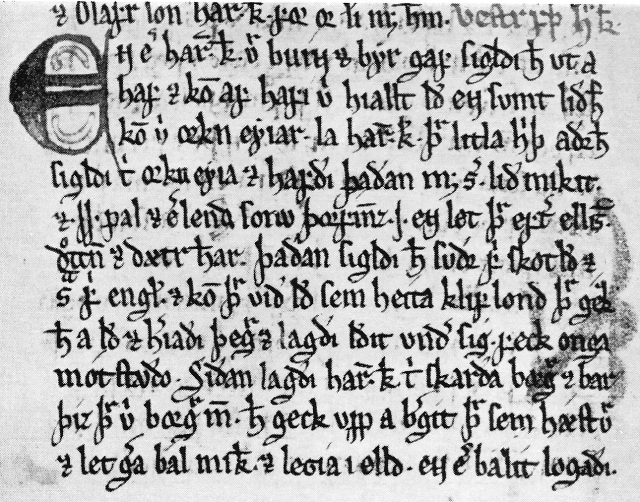
The account in Codex Frisianus of the attack on Scarborough in 1066
"But when King Harald was ready & a fair wind came sailed he out to
sea & came from sea to Shetland but some of his fleet
came to the Orkneys. Lay King Harald there a little time before he
sailed to the Orkneys & had thence with him a great fleet
& the earls Pal & Erland, sons of Earl Þorfinn, but left behind there Ellisif
the Queen & her daughters. Thence sailed he south by Scotland, &
so along England & came there to land where it is called Cleveland. There went
he ashore & harried at once & laid the land under him, met no
resistance. Then put King Harald into Scarborough & fought
there aginst the townsmen. He went up into the mount there where it highest was
& had made a great bonfire & set fire to it, but when the fire was blazing
they took great forks and pushed it down into the town so that all the houses set fire to one another and the town surrendered."
The Codex Frisianus records that King Harald's first landing in England after sailing from Scotland was at Cleveland where he went ashore and "harried at once & laid the land under him" meeting no resistance. Cleveland, being part of Northumbria, would have been part of Tostig's "territories" as Earl of Northumbria prior to his exile in 1065. Hence the need for King Harald's attack on, and subjugation of, Cleveland in August 1066 in preparation for his invasion of Yorkshire from the Humber.
Scarborough 966-1966 (1966) Mervyn Edwards (ed.), Scarborough and District Archaeological Society Research Report No. 6, at page 17 and at page 29:
"Now, King John leased the burgesses (of Scarborough) the tenancy of the Falsgrave manor, its Ramsdale mill and demesnes."
So, in 1210 King John gave 60 acres of Falsgrave Manor to Scarborough, along with its Ramsdale Mill and common pasture rights. This meant that Scarborough had its own arable land and no longer had to rely on trade with its neighbours for barley and wheat. In a reversal of the relationship implied in the Domesday report of 1086 (which seems, by omission, to have considered Scarborough a part of Falsgrave manor), Falsgrave was now a part of Scarborough. The name of Falsgrave is mentioned in the Domesday Book, but there is no mention of Scarborough. The devastation by fire of Scarborough by Harald Hardrada implied by the saga accounts of Harald's siege alone, without taking subsequent wastings into account (including William the Conqueror's famous harrying of the north in the winter of 1069-70), would suffice to explain the absence of Scarborough from the Domesday Book. The community was left abandoned and those who remained were slain and all their belongings seized:
"Harald went up onto the rock which was there, had a huge bonfire built and set fire to it. When it was blazing his men took large pitchforks and cast the fire down into the town. All the houses then caught fire one after the other, and the whole town surrendered. The Norsemen killed many there and took all the booty they could lay hands on." As reported in Heimskringla and confirmed by Fagrskinna.
The Manor of Hougun is the name given to a district recorded in the Domesday Book, and which now forms part of the county of Cumbria in north-west England. Of the three most northern counties of England surveyed in the Domesday Book of 1086 (Northumbria, Durham and Cumbria), only the southern band of land in the south of Cumbria was recorded. The western-most entries for Cumbria, covering the Duddon and Furness Peninsulas are largely recorded as part of the Manor of Hougun. The entry in Domesday Book covering Hougun refers to the time when it was held by Earl Tostig about 1060. The exact location of Hougun has been long disputed and Millom is often suggested, although High Haume near Dalton-in-Furness has also been suggested given that it was recorded in 1336 as Howehom. It has been suggested that the centre of the district was Furness, and that the territory included the Millom area, plus part or all of Cartmel - what would later be the Lancashire territory known as Amounderness. The name itself is thought to derive from the Old Norse haugr meaning 'among the hills', which could refer to almost anywhere in the area. Houganai or island of Hougun was also the name given to nearby Walney Island.
North of the Hougun district, the land was part of Strathclyde/Cumbria, under Scottish over-lordship which would explain why Tostig's "sworn brother" was King Malcolm III of Scotland. Tostig spent the summer of 1066 in Scotland. He made contact with King Harald III Hardrada of Norway and persuaded him to invade England. One of the sagas claims that he sailed for Norway, and greatly impressed the Norwegian king and his court, managing to sway a decidedly unenthusiastic Harald, who had just concluded a long and inconclusive war with Denmark, into raising a levy to take the throne of England. With Hardrada's aid, Tostig sailed up the Humber and defeated Morcar and Edwin at Gate Fulford.
Conservation Area Appraisal & Management Proposals, Falsgrave (3 July 2008)
Falsgrave was once a separate township from Scarborough and in deed it pre-dates the latter. The name of Falsgrave is mentioned in the Doomsday Book - there is no mention of Scarborough. At this time Falsgrave was one of the most important settlements in the district being the head of a composite royal manor or soke with jurisdiction over an arc of territory from Staintondale in the north, Ruston in the west and Filey in the south. It is likely that Falsgrave had significant administrative, judicial, economic and ecclesiastical functions. It is thought the centre of the village was roughly where the Crown Tavern and Cambridge Place now stand, and the historic core can be recognised in the group of cottages around Cambridge Place and the former farmhouses, many now listed, and in commercial use, such as the Lloyds Bank building. However an alternative theory is that the original settlement was at the head of Ramsdale, close to the present junction between Valley, St. James' and Londesborough Roads. In this location too were probably the sites of the Chapel of St. Clement and the Guildhouse, the exact locations of which are now lost.
Falsgrave declined in importance as it became overshadowed by the growth of Scarborough from the 12th century and other than perhaps part of the street pattern there are no surviving traces of the medieval settlement.
In 1201 King John granted Scarborough 60 acres of his manor of Falsgrave, thus giving the town its own arable fields. The roles were reversed - Scarborough had been part of the royal manor of Falsgrave but now Falsgrave became part of the borough and liberty of Scarborough. From this time on Falsgrave must have begun to lose its administrative functions but must also have retained a strong economic function.
Staintondale is identified as the northern boundary of Falsgrave Manor and is located five miles south of Ramsdale. Accordingly, the reference in the 1210 lease by King John of 60 acres of Falsgrave Manor and "its Ramsdale mill" could be a reference to a mill in Ramsdale Valley in Scarborough rather than the Ramsdale Mill in Ramsdale.
"Vikings and Surnames" (1991) K. H. Rogers at pages 10 and 11
Choice of Sites for Settlement
Much account is taken nowadays of the rôle of geographical and geological conditions in determining land settlement (see M. Gelling Signposts to the Past, and G. Fellowes Jensen's books on Scandinavian settlement names). Obviously the Viking, like any other immigrant, was primarily concerned with food, shelter, safety and general means of livelihood. Among the priorities would be good soil and grassland, preferably low-lying for ease of access and nearness to a water-supply, but with drier ground available nearby for habitation. But forests would be sought for timber, and as a hunting-ground for food, also for leather and fur to make clothing. All these factors, and many more, such as ownership and demarcation of land, show up in the place-names which gave rise to surnames, and the range is enormous … The eye has focused on aesthetic as well as practical aspects; colours, shapes, landmarks go to make a picture and inventory of the new homeland … But survival demanded then, as now, a balance between cultivated ground and woodland …
Editor's note: the hamlet of Ramsdale and its environs - Oak Wood (formerly Ramsdale Wood), Ramsdale Beck (with its three waterfalls), Kirk Moor and Fyling Park in Fylingdales Parish - provide fresh water, food, hunting, grazing and arable land which, together, comprise the land settlement conditions sought by Viking settlers.

Robin Hood's Bay viewed from the west
showing the land settlement conditions sought by Norse Viking settlers:
"above the farmland, overlooking the bay and with easy access to the hill grazing lands …"
A Guide to Prehistoric and Viking Shetland (1986) Noel Fojut at pages 44 and 45
… many modern crofts bear Norse names, and occupy sites which fulfil the ideal for Norse settlement: above the farmland, overlooking the bay and with easy access to the hill grazing lands …
Editor's note: again, these "ideals for Norse settlement" are met by the hamlet of Ramsdale and its environs.
"On Scandinavian Place Names in the East Riding of Yorkshire" (1879) Edward Maule Cole, British Library at page 13
… In several cases, perhaps in a majority, if we knew the actual facts, the prefix is a proper name. The Norse invaders originally gave their name to the place where they settled; in more recent times, families took their name from the place where they lived. Thus some Scandinavian warrior gave his name Grimr to Grims-tuna, and subsequently the owner of the soil, possibly a descendant, called himself "de Grimston", which passed into a surname, and is one of the most ancient in the East Riding.
Editor's note: from Raumsdal (modern: Romsdal) or Raumsdalr to Ramsdale would be a good example of this Norse naming tradition.
"Vikings and Surnames" (1991) K. H. Rogers at pages 37, 44, 45 and 47
Chapter V: Later Years of the Viking Period in England
'Scarcely a township, hamlet or farmstead existed before 1300 which did not supply a family name.' per J. H. Turner in "Yorkshire place-names as recorded in Domesday Book" at page xiii
Domesday Book - relevance to surnames
It has been estimated that Domesday Book fails to name about one fifth of the settlements and a good proportion of the population … The vast work names 13,418 places and is written up on about 1,000 sheepskins, apparently all in the same hand. One sympathises with a later copyist when he added a heartfelt postscript:
Pro Christo da mihi potum
or roughly, 'All this is finished - for Christ's sake give me a drink'. The book has, for us, an additional function - as the raw material for many surnames which developed a century and more later.
… Many surnames reflect relatively unchanging larger aspects of the landscape: DALE (dalr) …
Topographical and Toponymic (habitation) Surnames
Locative surnames derived from place-names may be divided into two broad categories: topographic and toponymic (habitation):
Toponymic Surnames
Toponymic (habitation) surnames are by far the most common type of surname in Britain. In many cases the location is as specific as an individual farmstead or a place no longer found on any map, in others a more generalised location such as a village or town. Some of these surnames have been identified because hundreds of years later the surname holders remain concentrated close to their point of origin and their family history has been traced back through early medieval documents.
Toponymic (habitation) surnames are derived from a pre-existing names denoting towns, villages, farmsteads, or other named habitations. Other classes of local names include those derived from the names of rivers, individual houses with signs on them, regions and whole countries [1]. Toponymic surnames are relatively more common in the parts of Britain that are sparsely populated with scattered farmhouses rather than larger settlements, for example in the far north and the south-west of England.
Some of these surnames could conceivably have arisen because an ancestor travelled away from his home region during the period of surname formation, so the principal modern-day heartland of the family could therefore be in that new settlement area rather than the area of origin. Studies have shown, however, that overall more than half the surnames in Britain still have a statistically significant association with a particular locality.
Like all surnames, toponymic surnames can "mutate" when name bearers change their locality, their name then being pronounced differently and leading over time to a change of spelling. Some modern surnames are unrecognisable abbreviations of familiar places e.g. "Deadman" being a contraction of "Debenham", a village in Suffolk.
Given that toponymic surnames are so specific in their origin, logic suggests that many of these surnames will probably have a single common ancestor at their head. Accordingly, DNA tests on modern-day name-bearers should reveal that they have identical or very similar DNA signatures.
Topographical Surnames
The second common type of surname is that derived from a general descriptive reference to someone who lived near a physical (topographic) feature in the landscape such as an oak tree, a hill, a stream or a church. These arose in the same way as toponymic surnames, but because they tend to describe a general feature rather than a specific location e.g. Brook, Green, Hill, Wood, it is generally assumed that they must have arisen in many places across the country independently of each other.
As a general rule, the further someone had travelled from his place of origin, the broader the designation. Someone who stayed at home might be known by the name of his farm or locality in the parish; someone who moved to another town might be known by the name of his village; while someone who moved to another country could acquire the name of the country or region from which he originated. [1]
Recent developments in surname studies [9] demonstrate that some topographical surnames are toponymic i.e. they are linked to a specific location rather than to a general landscape feature e.g. the relatively common surname "Sykes".
Given that topographical surnames are likely to have arisen in many different places across the country, it is to be expected that DNA results of men bearing one of these generic surnames should reveal its multiple ancestor origin.
Monogenetic surnames are those with a single origin, often being derived from just one original bearer or family of bearers at one particular place and time. Most polygenetic surnames were coined independently in many different places. It is not normally possible to identify the original bearer of a monogenetic surname, but it is sometimes possible to postulate that a name must be monogenetic on the basis of its distribution. [1]
Heraldry
It is highly unlikely that the surname is in any way derived from the word ram meaning a male sheep, although the arms of Ramsdale make a pun on this, a practice known in heraldry as canting.
Notes
[1] A Dictionary of Surnames Patrick Hanks and Flavia Hodges, OUP 1988
[2] The Place Names of England and Wales Johnston, John Murray, 1915 (page 50)
[3] History Through Surnames W O Hassall, Pergamon Press, 1967 (page 15)
[4] Place Names and Surnames - Their Origin and Meaning Taylor Dyson, Alfred Jubb & Son (1944) at page page 43
[5] Words and Places Isaac Taylor, London, published by J M Dent & Sons (pages 128 and 137)
[6] The Origin of English Place Names Reaney, Routledge & Keegan Paul, 1960 (page 175)
[7] English Place-Name Elements, A. H. Smith, Part 1 (Introduction), A - IW Cambridge University Press, 1956
[8] English Place Names Kenneth Cameron, The Bath Press (1977 and 1996 editions) (respectively pages 179 & 181 and 189 to 191)
[9] Surnames and Genealogy: A New Approach Dr George Redmonds, New England Historic (June 1997)
[11] The Origin of English Place Names Reaney, Routledge & Keegan Paul, 1960 (page 188)
[12] The Origin of English Place Names Reaney, Routledge & Keegan Paul, 1960 (page 190)
[13] From Vé-ey ('Holy Island', Romsdal) to Lindisfarne ('Holy Island', Northumbria) on 8th June 793 ?
"Vé-ey, an island in Romsdal in Norway = our Holy Isle;" On Scandinavian Place Names in the East Riding of Yorkshire (1879) Edward Maule Cole, British Library at page 17.
Veøya (Old Norse Veøy olim Vé-ey) is an island in Molde Municipality in Møre og Romsdal county, Norway. The name is a compound of vé which means "sanctuary" or "holy" and øy which means "island", thus a holy island. The name was historically spelled Veø and Vé-ey).
The island is located at a junction of the three main branches of the Romsdalsfjorden between the island of Sekken and the mainland near the village of Nesjestranda. The 2.3 square mile island was the municipal centre of the old Veøy municipality. The island was Norway's first legally protected land, and the buildings on the island, including the Old Veøy Church, are now part of the Romsdal Museum.
The island was a strategic location for the coastal routes during the Viking Age. The southern branch of Romsdalsfjorden leads to the Romsdal valley (and the present-day town of Åndalsnes), where important trade routes led up the valley to Lesja. From there it followed the pilgrim trail over Dovre to Trøndelag, or down the Gudbrandsdal valley to Eastern Norway. The eastern branch led through the Langfjorden where they hauled their ships over the 3.1 mile wide, low-lying isthmus at Eidsvåg, in order to avoid the dreaded waters of Hustadvika, and then back to the shipping routes northwards to Nidaros (modern day Trondheim). To the west, past the inlet of the fjord, were the southbound routes to Bergen.
At this junction Veøy, an island in the middle of the Romsdalfjord, was established as a kaupang (Old Norse for a market town), and Romsdal's economic, administrative, and religious center. It had 300-500 permanent residents, and was an important commercial center, with a significant increase during the sailing season.
The Old Veøy Church, dedicated to the Apostle Peter, is built in stone and it is the only survivor of three churches on Veøya in the Middle Ages. This church dates back to around the year 1200. It has a capacity of 400 people, and served the entire region, while the other churches served the local population. There had been in time immemorial a religious site at Veøy and, at the close of the 12th century, Veøy gamle kirke, the church dedicated to St. Peter, was constructed over an ancient site of pagan worship.
Veøya is mentioned by Snorre Sturlason (circa 1179-1241) in connection with the battle of Sekken in 1162 where king Håkon Herdebrei was killed by Erling Skakke on 7 July 1162, during the Norwegian civil wars. Veøya, or nearby on the mainland, was probably the seat of Ragnvald Eysteinsson (Ragnvald Mørejarl), earl of Møre, whose son was Hrolf Ganger (Gange-Rolv).
[14] Editor's note: "De origine actibusque Getarum" (The Origin and Deeds of the Getae/Goths), or the "Getica", written in Late Latin by Jordanes (or Jornandes) in 551, claims to be a summary of a voluminous account by Cassiodorus of the origin and history of the Gothic people, which is now lost. It is significant as the only remaining contemporaneous resource that gives the full story of the origin and history of the Goths and Slavs.
[15] Tostig's brother was Harald, King of England.
[16] "Tostig's own territories" north of Scarborough is not thought to be a reference to either (a) the Manor of Falsgrave or (b) the Manor of Hougun. Tostig was the Lord of the Manor of Falsgrave (located about 1 mile west of Scarborough town centre on the routes of the main Scarborough to York and Scarborough to Pickering roads) which had jurisdiction over an arc of territory from Staintondale in the north, Ruston in the west and Filey in the south and this territory included Ramsdale mill. Accordingly, part of the Manor of Falsgrave is north of Scarborough (which appears to have been surrounded by the Manor of Falsgrave) whereas the Manor of Hougun is located in Cumbria on the north-west coast of England some 160 miles due west of Scarborough.
[17] Scarborough figures in Snorre Sturluson's "Heimskringla" and the "Noregs Kononga tal" as an important stage in Harald Hardrada's expedition to Stamford Bridge where, on Monday, 25th September 1066, he died with an arrow in his throat.
[18] Harald Sigurdsson (Old Norse: Haraldr Sigurðarson; circa 1015 to 25 September 1066), given the epithet Hardrada (harðráði, roughly translated as "stern counsel" or "hard ruler") in the sagas, was King of Norway (as Harald III) from 1046 to 1066.
[19] Tostig Godwinson (died 25 September 1066) was an Anglo-Saxon Earl of Northumbria and brother of King Harold Godwinson. The Domesday Book recorded twenty-six vills or townships as being held by Earl Tostig forming the Manor of Hougun.


